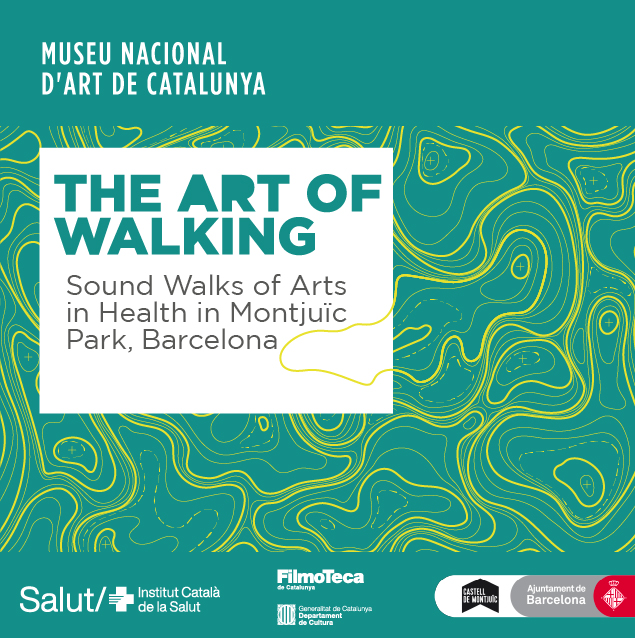
Preparing the canvas: before the route
The Art of Walking
Transcript
The Art of Walking
“Welcome to “The Art of Walking”, an itinerary of art, sound and health around the paths of Montjuïc. We propose a leisurely experience in which to enjoy nature and art, to connect with the surroundings, and improve your wellbeing. Painting, sculpture, photography, literature and music will accompany you on this tour of the area of Montjuïc that surrounds the MNAC. It is a museum that opens up in all directions, spreading the colours, shapes and textures of its works over every flower, tree and landscape you come across along the way.
You will also travel to the past through the museum’s photography collection and the early films preserved by the Film Archive of Catalonia. If you wish, you too can become an artist. Take out your camera (or mobile phone) and follow our photographic suggestions to capture the light and colours of Montjuïc mountain.
Your guide will be the app you are now looking at. In it you will find the contents of each section of the route and icons with directions to guide you, as well as photographic suggestions and content expansion. You should familiarise yourself with the app to get the most out of the activity. We will also offer you various indications and health tips prepared specifically for The Art of Walking activity by health professionals from the Catalan Health Institute. They focus on exercise, relaxation, nutrition, concentration, enjoyment, mindfulness and breathing, as well as suggestions for muscle stretching and postural hygiene. The route begins at the MNAC and proposes a first segment to the Mossèn Cinto Verdaguer Gardens. If you would like to continue walking or to resume the route another day, we have prepared a second section up to the top of Montjuïc, where the you will find Montjuïc Castle. We also recommend you repeat the experience in different seasons of the year and admire nature’s brushstrokes of varied colours on the landscape, not usually easy to see in the city. Let yourself be carried away. This moment is just for you, to breathe, to walk and to feel your steps like a metronome, like a rhythm, like a heartbeat.
and well-being
How to get there
Transcript
How to get there
The itinerary begins on the steps in front of the National Art Museum of Catalonia at Montjuïc.
You can reach Plaça Espanya on Metro lines 1 or 3 or the trains of Ferrocarrils de la Generalitat de Catalunya. When you come out the station, continue along Avinguda Maria Cristina Avenue, passing by the Magic Fountain and the four columns until you reach the top. The climb is made easier by the escalators on almost the entire stretch.
Map
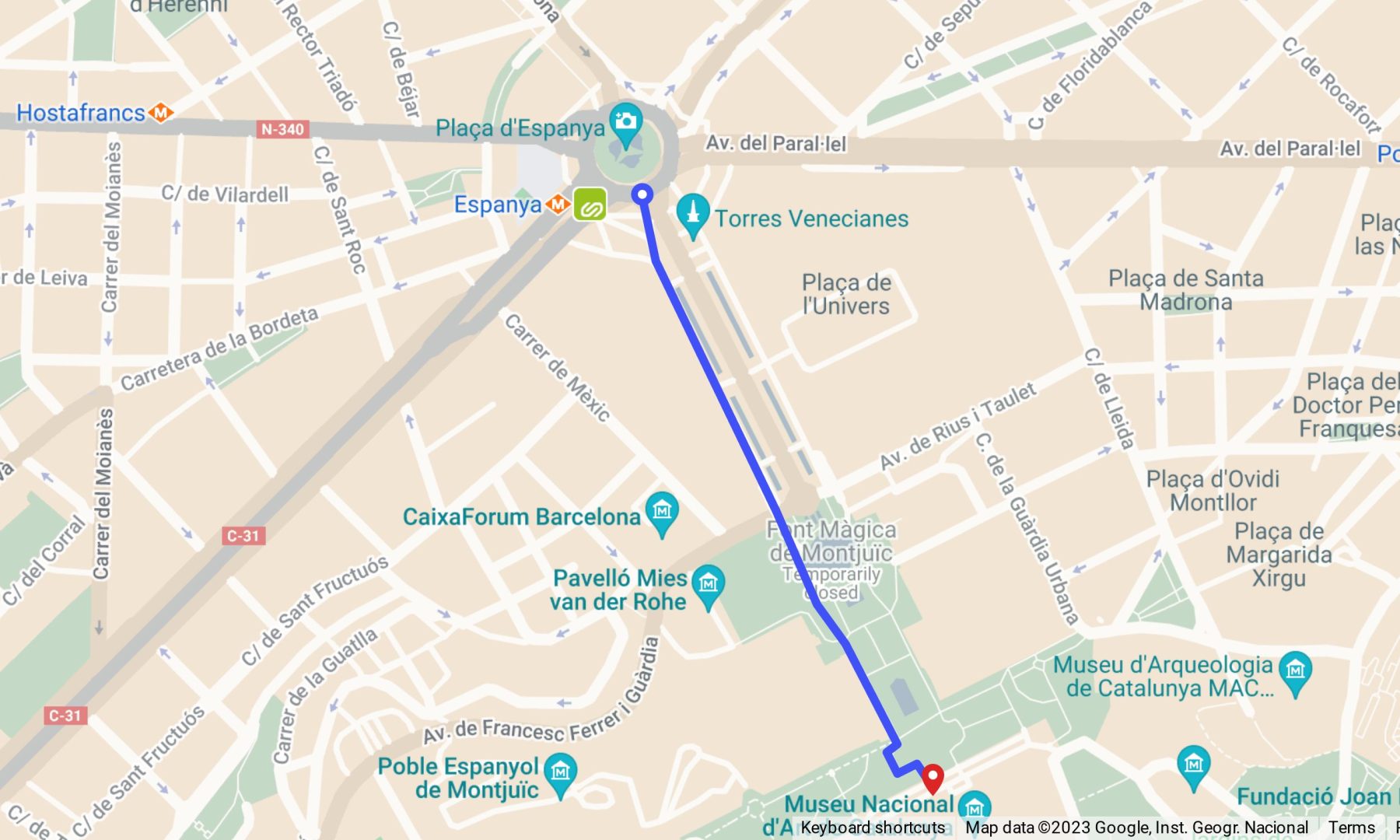
Before you start
Transcript
Before you start
Protect your skin from the sun:
– Apply a generous amount of sunscreen to your face, ears, neck, the nape of your neck and any other exposed part of your body.
– Apply a lip balm with sun protection to your lips.
– Put on your sunglasses.
– Wear a hat or cap (remember, the wider the brim, the more it will protect you. So it will not only protect the skin on your face, but also the back of your neck, neck and neckline).
Remember that on cloudy or rainy days you also need to protect yourself from the sun. It is very important to follow these sun protection tips to prevent unpleasant sunburn and avoid harming your skin. Overexposure to the sun is a risk factor for the development of wrinkles, sun spots and skin cancer.
Healthy eating:
Did you have a good breakfast? I hope so! Next, we’ll give you some ideas for a healthy breakfast before starting the day:
– Wholemeal toast with cottage cheese
– Yogurt with strawberries and oat flakes
– Wholemeal toast with radish and tomato
– An apple with peanut butter
Prefer to take it with you? Here are some healthy snack ideas:
– Banana and nuts
– Wholemeal bread sticks low in salt
– Wholemeal sandwich with escalivada and tuna
– Vegetable sticks and hummus
– A handful of walnuts
– Wholemeal sandwich with hummus, tomato and corn salad
These are just some ideas. Now it’s your chance to demonstrate your creativity!
Stay hydrated:
Do you drink enough water? Remember you should mostly drink water; always carry a bottle with you when you go for a walk. Take sips along the way, even if you’re not thirsty. If water seems boring to you, here are some tricks:
– Hot or cold teas
– Flavour the water with pieces of fruit (blueberries, raspberries, lemon, orange, etc.).
– Vegetable broth (to warm you in winter)!
Clothing and footwear:
– Remember to wear comfortable clothing and appropriate footwear. Don’t go for long walks the first day you wear new shoes, because they can cause blisters. Remember to take the appropriate accessories for the time of year:
– Cap or hat if it’s sunny
– Waterproof clothing if it’s cloudy or might rain
– Gloves, hat and warm clothes if it’s cold
First-aid kit:
– Sticking plasters
– Bandages between 5 and 10 cm
– Dressings
– Sutures (steri-strip)
– Gauze
– Gloves
– Chlorhexidine or alcohol
– Physiological serum (single dose)
– Scissors
– Insect repellent and bite treatment
– Sugar
– Ointment for bruises (Thrombocid)
– Paracetamol
What to do if you feel faint:
First of all, try and catch yourself before you fall. Once on the ground, if possible roll over with your legs raised at a 45-degree angle and your head to one side in case you throw up. Loosen your clothes (belts, ties, scarves, etc.) to help your breathing. Try to prevent too many people gathering around you. Remain in the lying position with your legs at a 45-degree angle for 15 minutes. When you start to feel better, slowly sit up. Faintness is usually caused by a drop in blood pressure. Drink water to relieve the faintness once you are partially sitting up; that way your body fluids will be replenished and your blood pressure will increase. If the feeling of faintness persists, you need to be seen by a healthcare professional.
First aid if you hurt yourself:
If you injure yourself and there is an open wound, the first thing to do is clean it thoroughly, if possible with running water and soap. Then disinfect it with antiseptic (povidone iodine) or chlorhexidine. If there is a lot of bleeding, apply compression with a clean gauze until the bleeding stops. Once the bleeding has been stopped, cover the wound to prevent it from becoming infected. If you have any doubts, or especially if it is a deep wound, you should seek the advice of a health professional.
In any case, it’s a good idea to have your tetanus vaccine up to date.
Starting point at the MNAC: The Expanded Museum
The Expanded Museum
Transcript
The Expanded Museum
Right now you are on the outer steps of the National Palace, the home of the National Art Museum of Catalonia (MNAC).
Perhaps you have already visited it. If not, you will find the MNAC is a boundless museum with an infinite capacity to surprise you.
For example, what you are hearing now is part of OVAL, a project by the artist Fito Conesa. He brought the organ in the Oval Hall back to life with digital recordings amplified by the pipes, also with the collaboration of the singer Maria Arnal. The organ was once the largest in Europe, although it is no longer played and is currently awaiting a major restoration.
In front of the Palace you can see Maria Cristina Avenue, a monumental promenade built for the International Exhibition of 1929. The “Magical Fountain” designed by Carles Buïgas still arouses the admiration of visitors from all over the world with its spectacle of water, light and colour.
The 1929 Exhibition enormously transformed Montjuïc mountain, urbanised it and connected it to the city. Its current appearance and the parks and paths we will walk from now on are from that historical period. The avant-garde technology and architecture of the time gave rise to modern, innovative buildings, spectacular fountains and more than 100 obelisks illuminated with electric light that gave a unique aspect to Reina Maria Cristina Avenue, which reaches the Plaza España. The city looked to the future through technology and the arts, and the theme of the exhibition was a fascinating advance: electricity.
Let’s start walking, following the rhythm of steps and words, sounds and smells. We’ll follow paths and delve into gardens for colours and textures, poems and stories, landscapes and horizons…
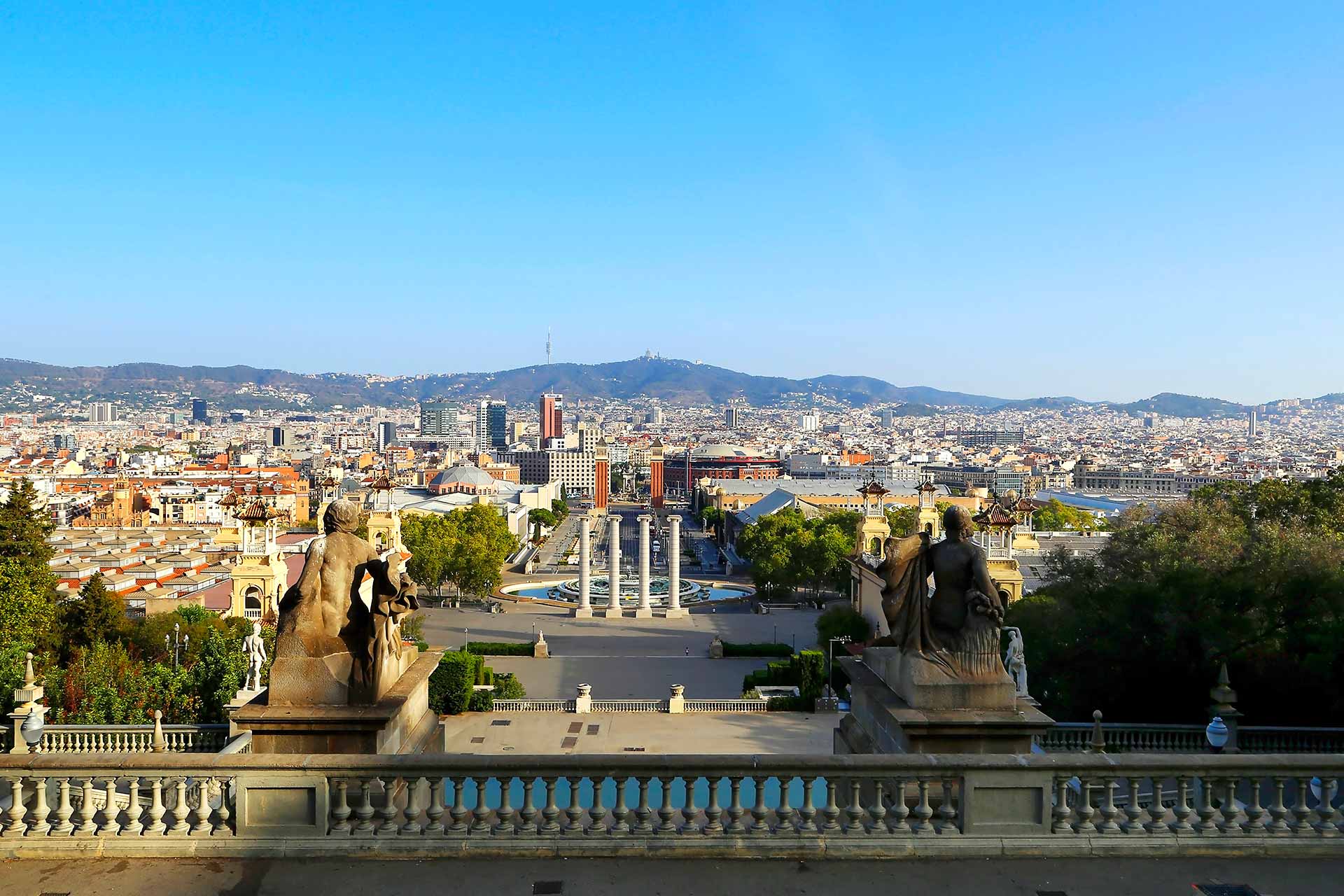
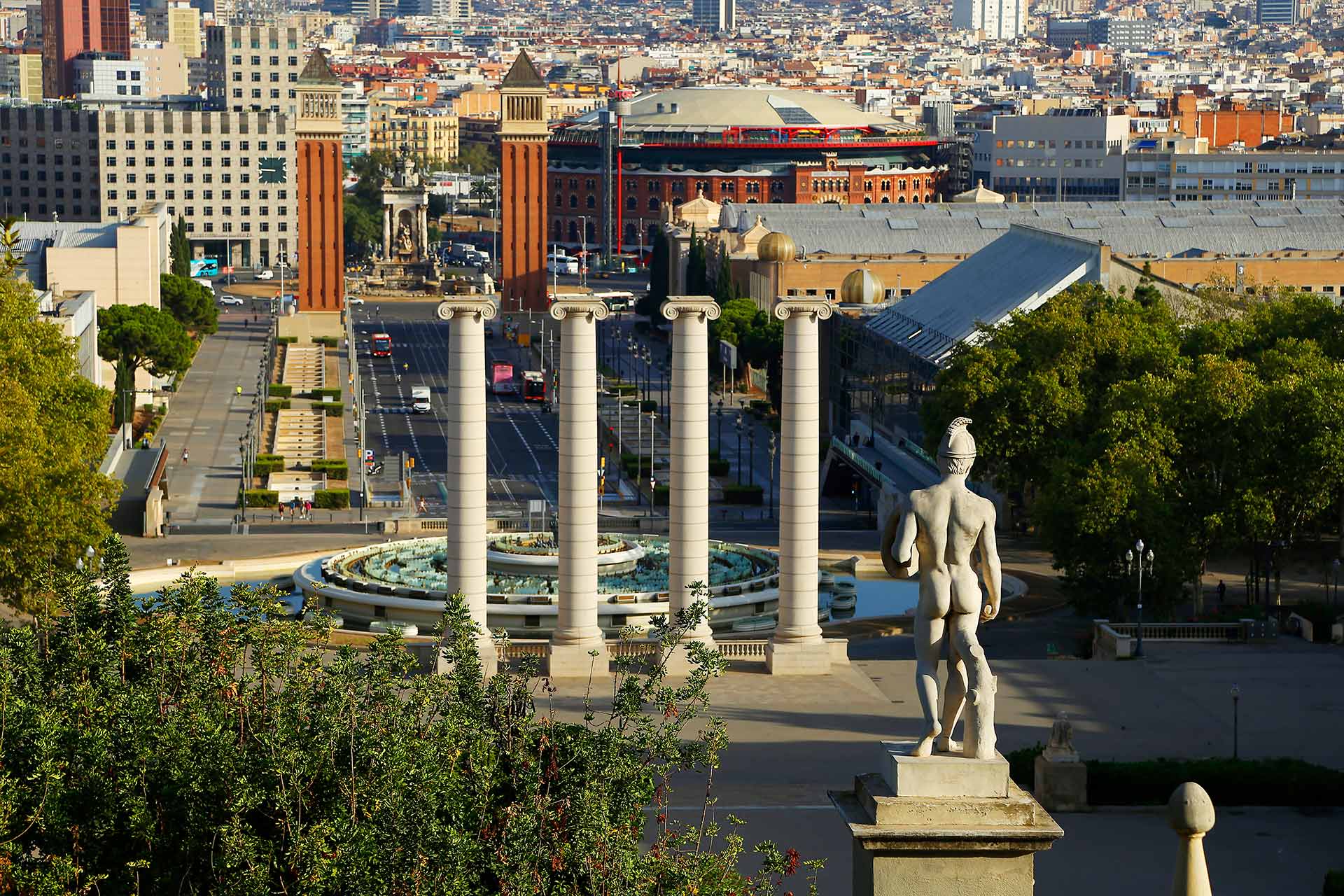
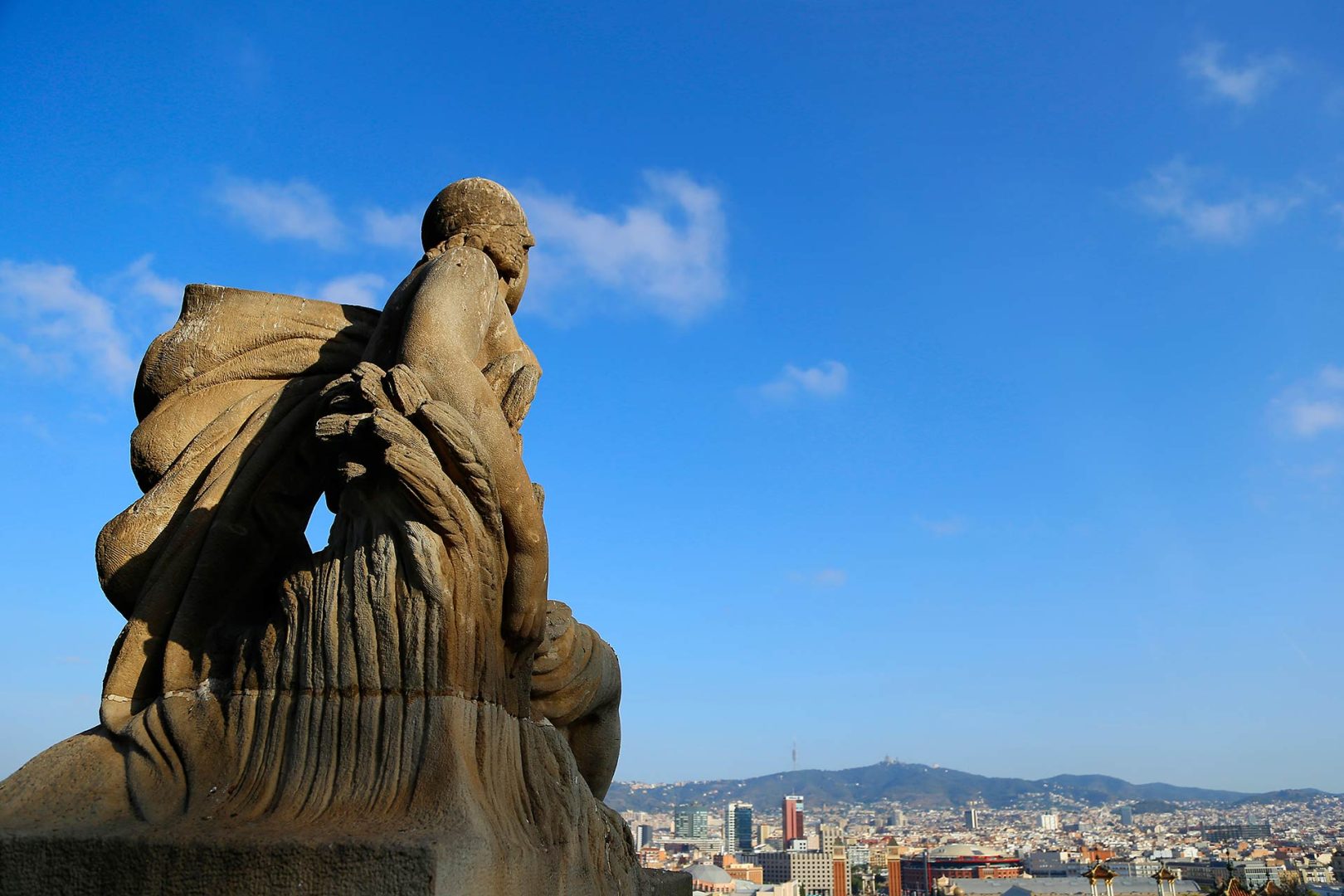
and well-being
suggestions
content
Start of the itinerary: from the MNAC to the Laribal Gardens
Transcript
Start of the itinerary: from the MNAC to the Laribal Gardens
We’re heading to the Laribal Gardens. You’re on the steps of the MNAC lookout point with the city at your feet. Go right towards Avinguda (avenue) dels Muntanyàns. Before turning right on the road, be sure to take in the fabulous views of the city from the lookout point. Once on the avenue, cross it on the pedestrian crossing and walk through the small square with benches surrounded by trees.
Go down the stairs at the end on the left and, once on the road, to the right you’ll see the Ethnological Museum.
Reach it via the pedestrian crossing. Go up about 20 metres and you’ll see the signpost for the entrance to the Laribal Gardens, where you’ll find the Colla de l’Arròs rose garden.
Map
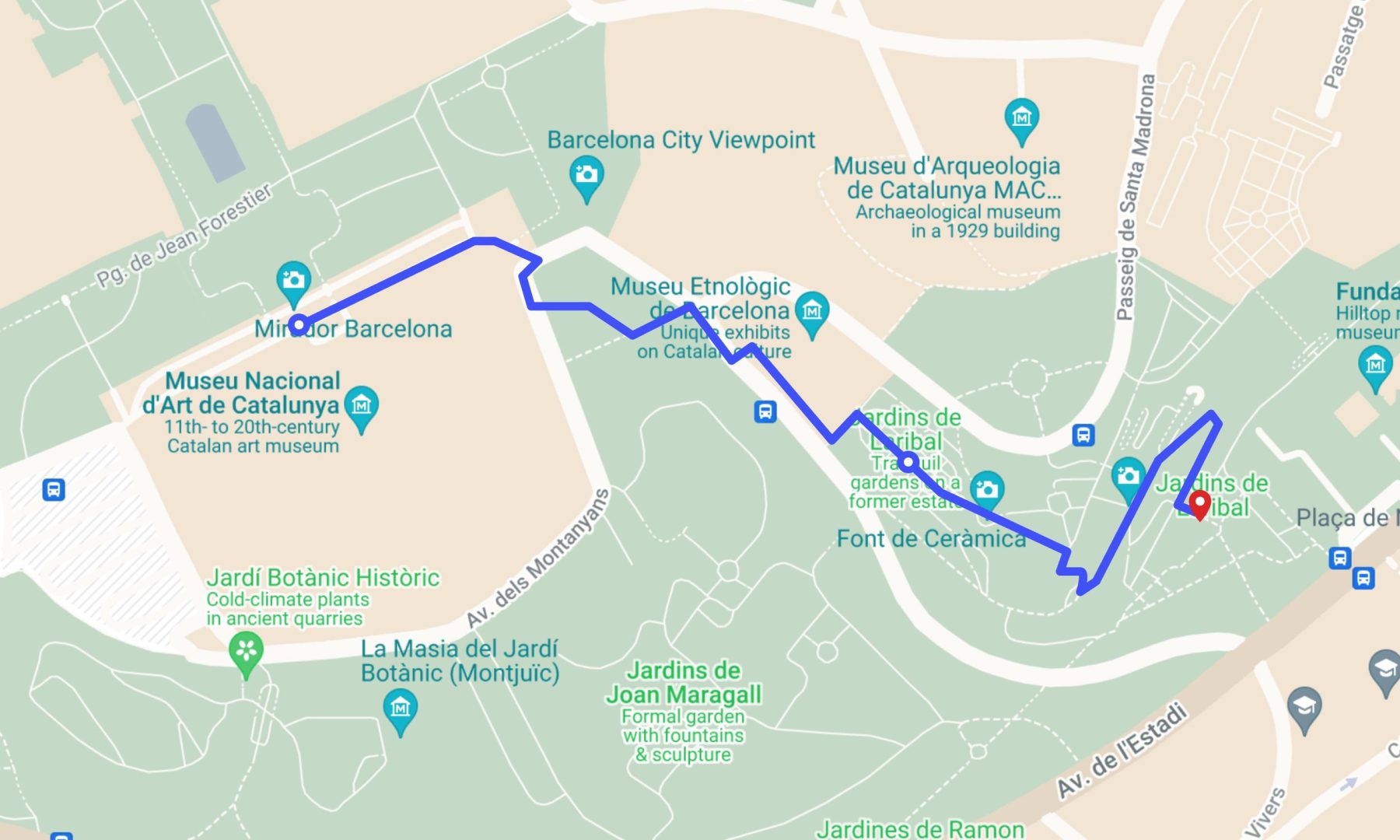
Prepare your body
Transcript
Prepare your body
Prepare your body for the adventure!
– Rotate your shoulders gently back and forth.
– Move your head gently from right to left.
– Move your head gently back and forth.
– Bring your hands together in front of you, interlace your fingers and make gentle movements with your wrists in one direction and another.
– With your legs slightly apart, place your hands on your hips and gently twist your waist to the right. Change direction and twist to the left.
– Bring your legs together, rest your hands on your knees and, without them separating, make circles with your legs to the right. Then make circles to the left.
– Put your body weight on your left foot. With your right foot, touch the ground with your toe and then your heel. Then repeat the process with the other foot.
Now you can set off!
Photography, the art of observing
Transcript
Photography, the art of observing
In this “The Art of Walking” itinerary you can also enjoy the art of photography while practicing it! Along the route we’ll give you brief photographic suggestions so that you too can experiment with your camera (or mobile phone) and become an artist!
Natural landscapes, sculptures and historical monuments, trees of a thousand shapes and flowers of a thousand colours, together with the best views of the city. These are the perfect settings either for taking your first photographs or perfecting your technique.
Photography is many things and is used for many more. But on this itinerary it will help us find moments of calm and make it easier to observe our surroundings. It will allow us to direct our attentive gaze, to marvel at the world around us and at all those things that Mercè Rodoreda referred to when she wrote that “the important things are those that don’t seem so”.
The art of photography is more than just clicking a button. You have to train your gaze and observe the landscapes in constant motion, decide what you want to photograph, how to portray it and, above all, why. Photography begins when you start looking at your surroundings and feeling them.
To take photographs you need a camera. You need to know its technical aspects such as the lenses, diaphragm, shutter and sensitivity. Today, however, automatic cameras and mobile phones make it very easy to begin taking pictures straight away and then gradually learn all the technical elements. That’s why these photography tips are designed for taking photos with your mobile phone.
But to get started, we’ll give you some very basic initial tips to keep in mind when taking photos:
– Clean the camera lens. It is through this small opening that the light enters to create your photograph; the cleaner and clearer it is, the more light can enter and the better the photograph. It’s very easy for the lens of your mobile phone camera to get dirty, especially as you can easily touch it while making calls. You can clean it with a soft, dry, smooth or microfibre cloth. If you don’t have one at hand, you can clean it gently with a cotton shirt, making circular movements.
– Avoid taking photos against the light. If you’re facing the sun, the objects you’re photographing will be darker and light aberrations may appear in the image. Whenever possible, you should have the light source (in this case the sun) at your back or to one side.
– You must bear in mind that daylight is of key importance to the result of your photo. Bright sunlight or a cloudy sky will make a big difference to the result. The textures, shadows and light temperature will change.
The best time to take photos is early morning or late evening. The light at midday causes sharp contrasts between light and shade, although this can also be used as a strong point if that’s what you’re looking for artistically.
From the MNAC lookout point you have an impressive panorama across the city to Tibidabo, a photo not to be missed! Or you can also start with small details of the sculptures you have around you. Along the various sections of the route we’ll offer you brief tips and techniques. But remember: once the techniques have been mastered, a good artist ignores them!
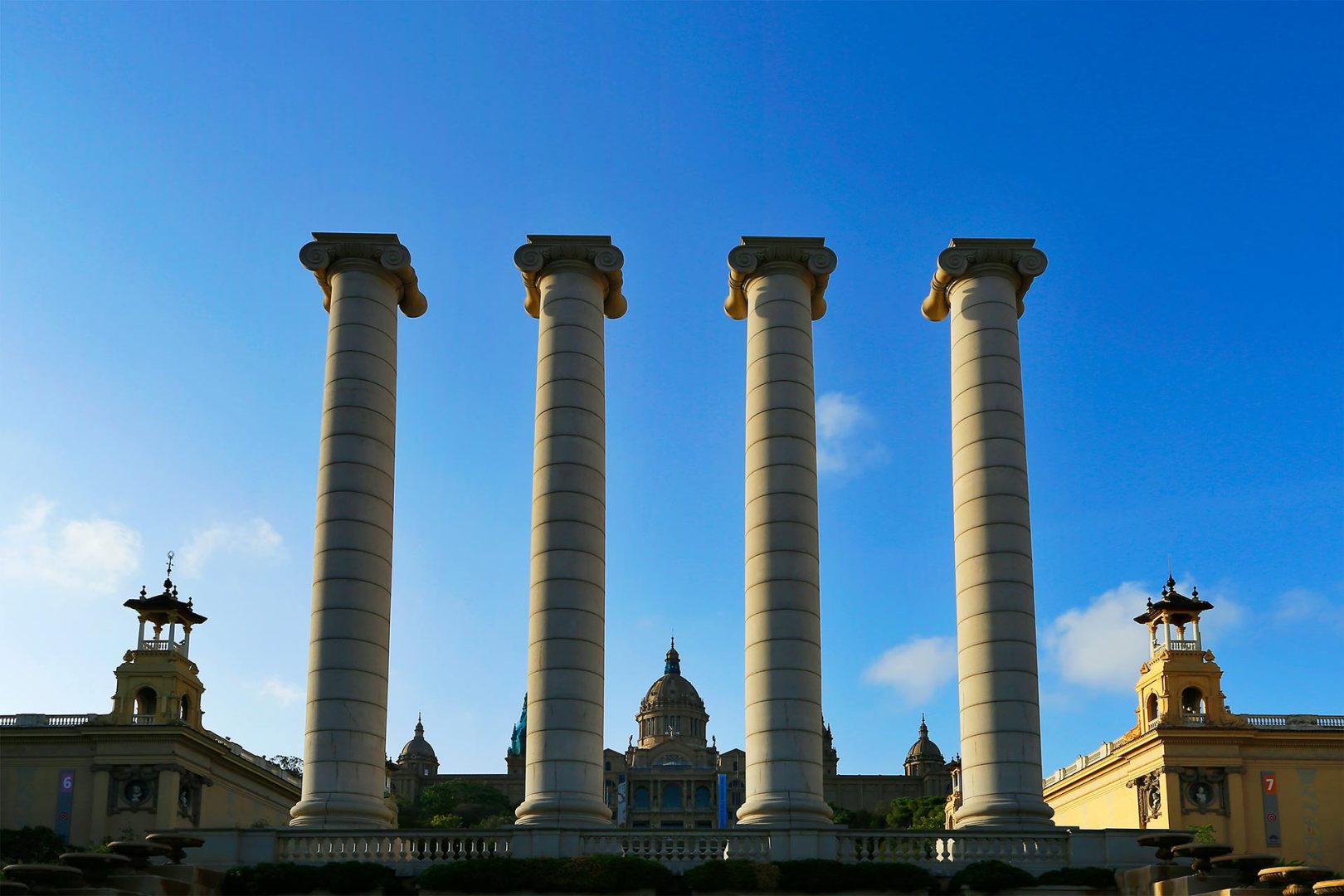
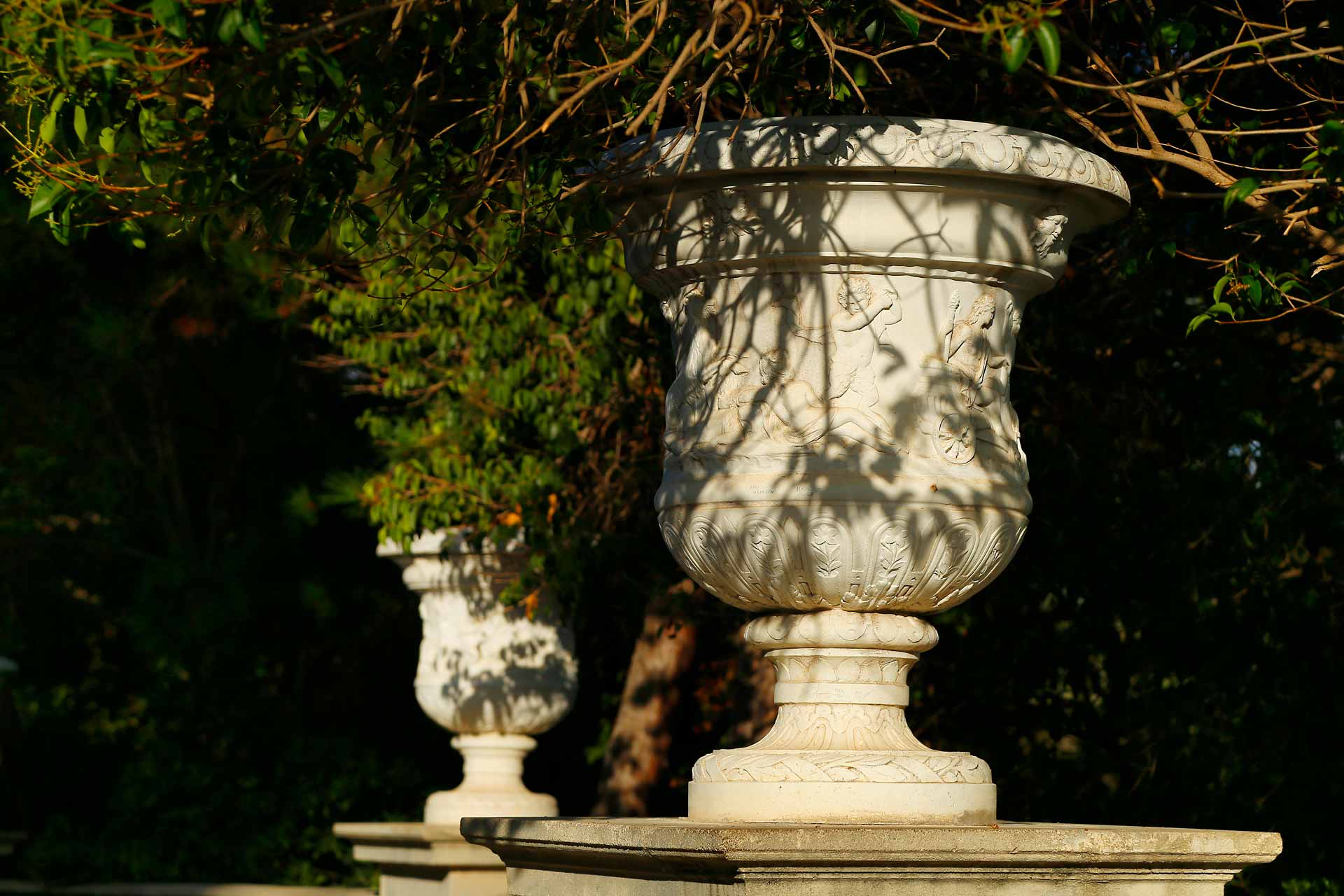
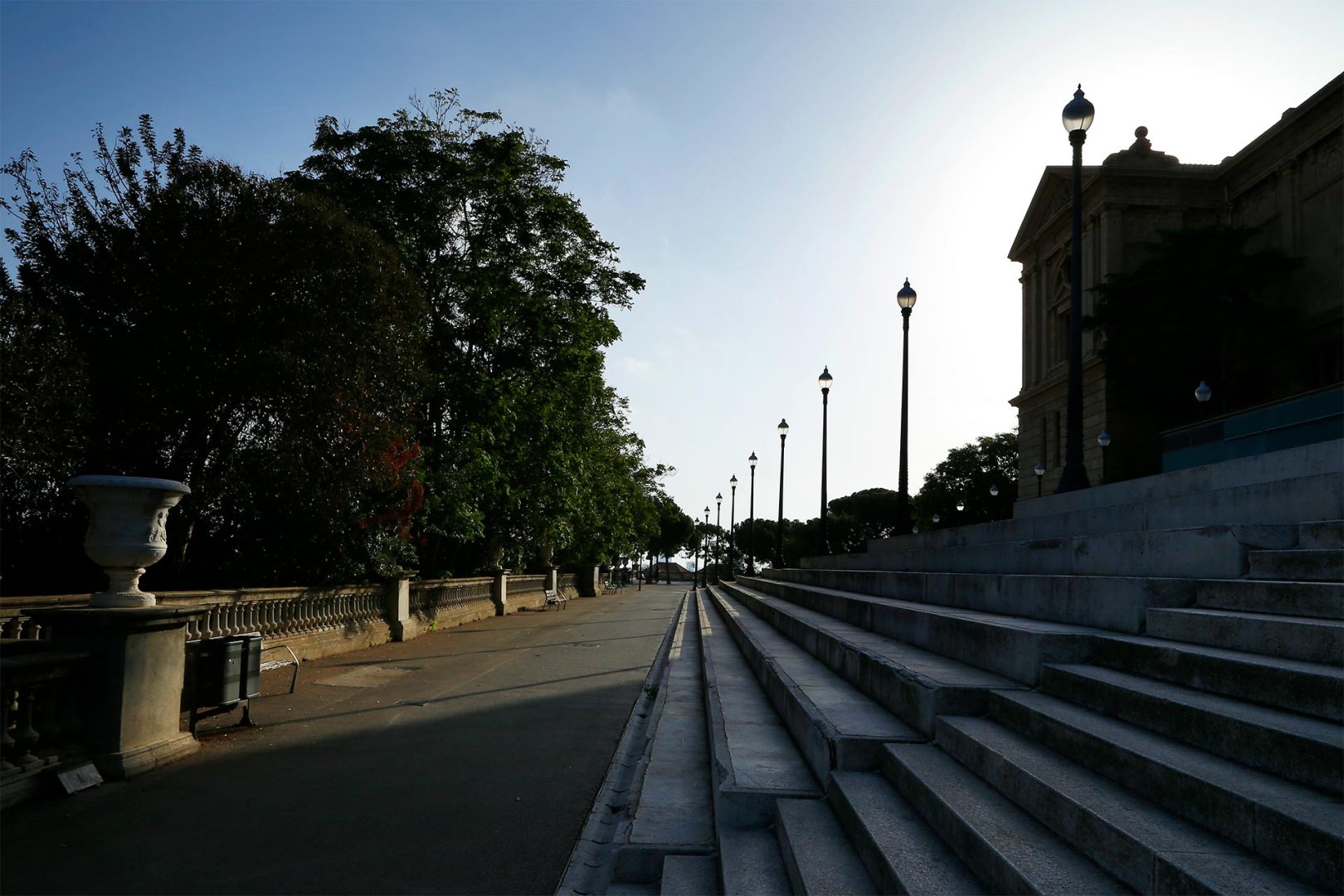

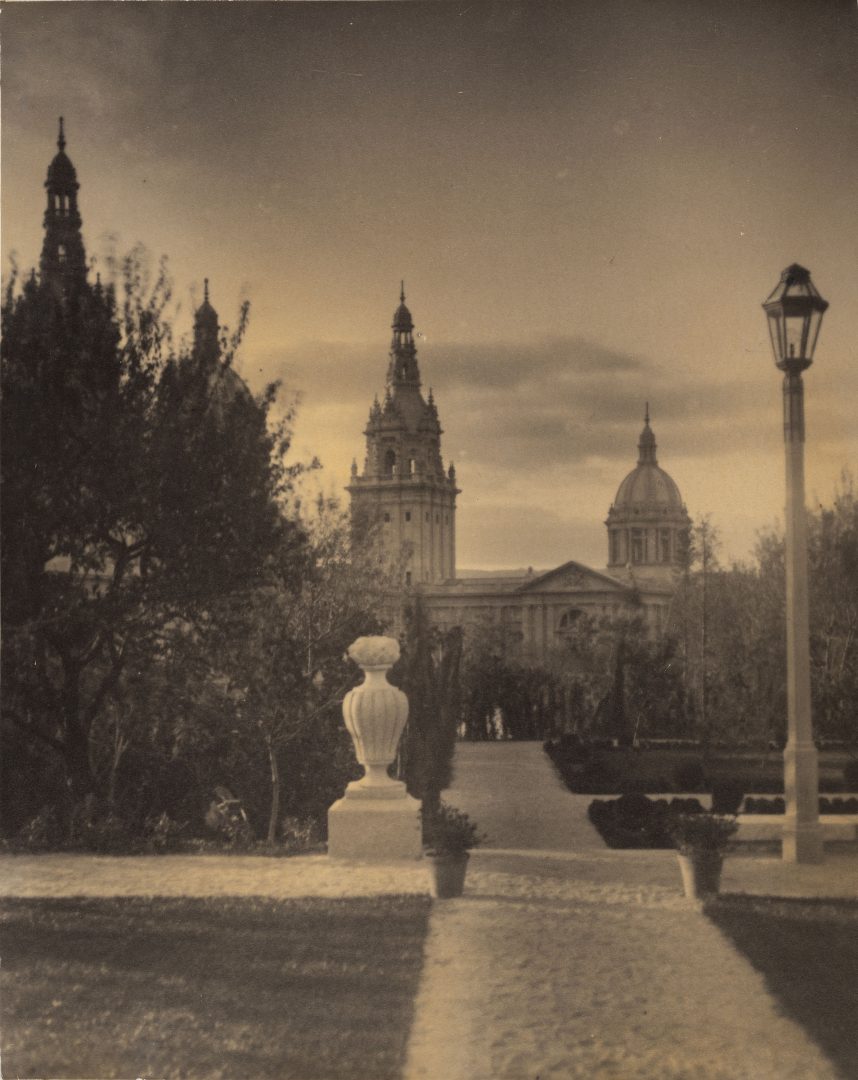
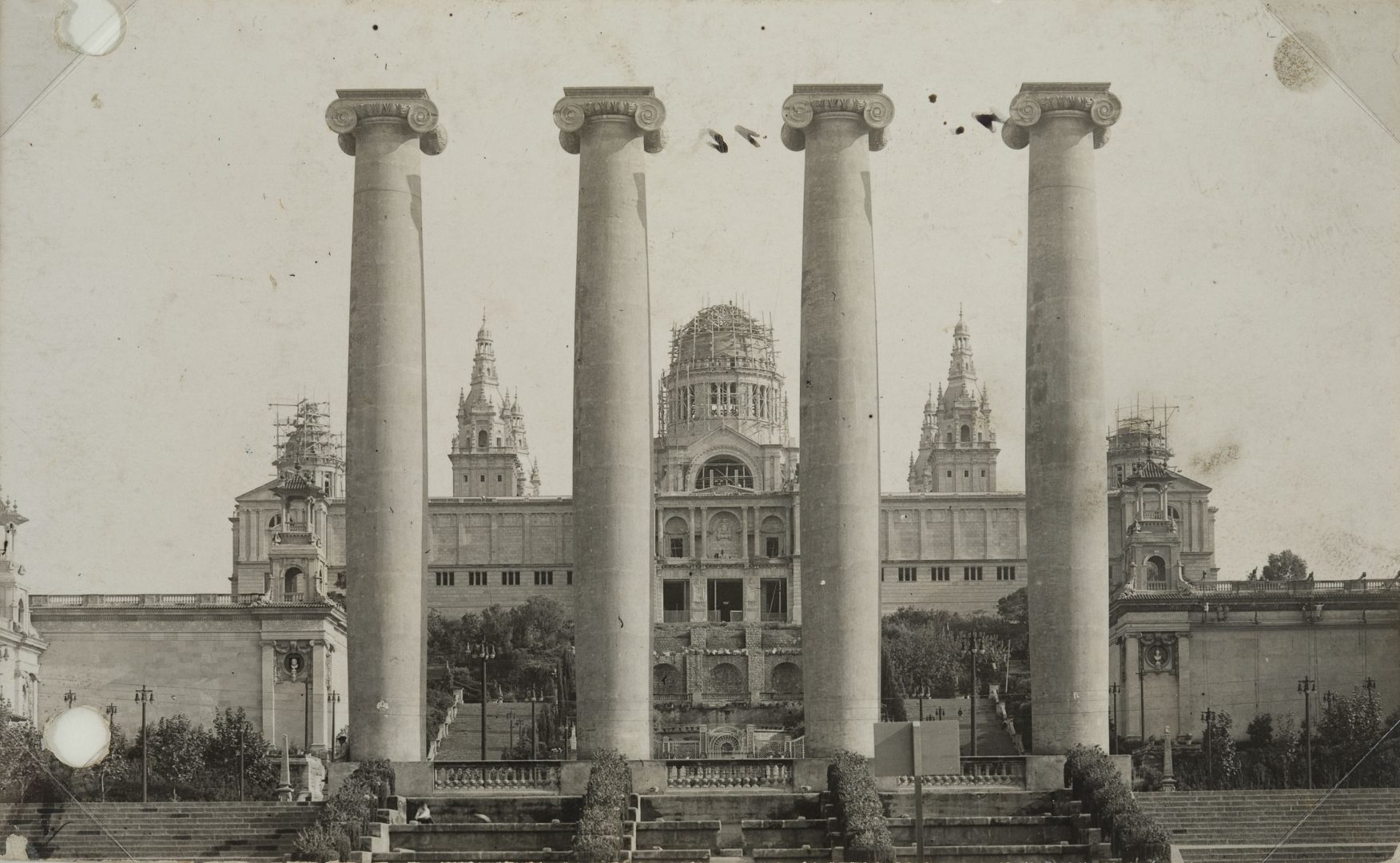
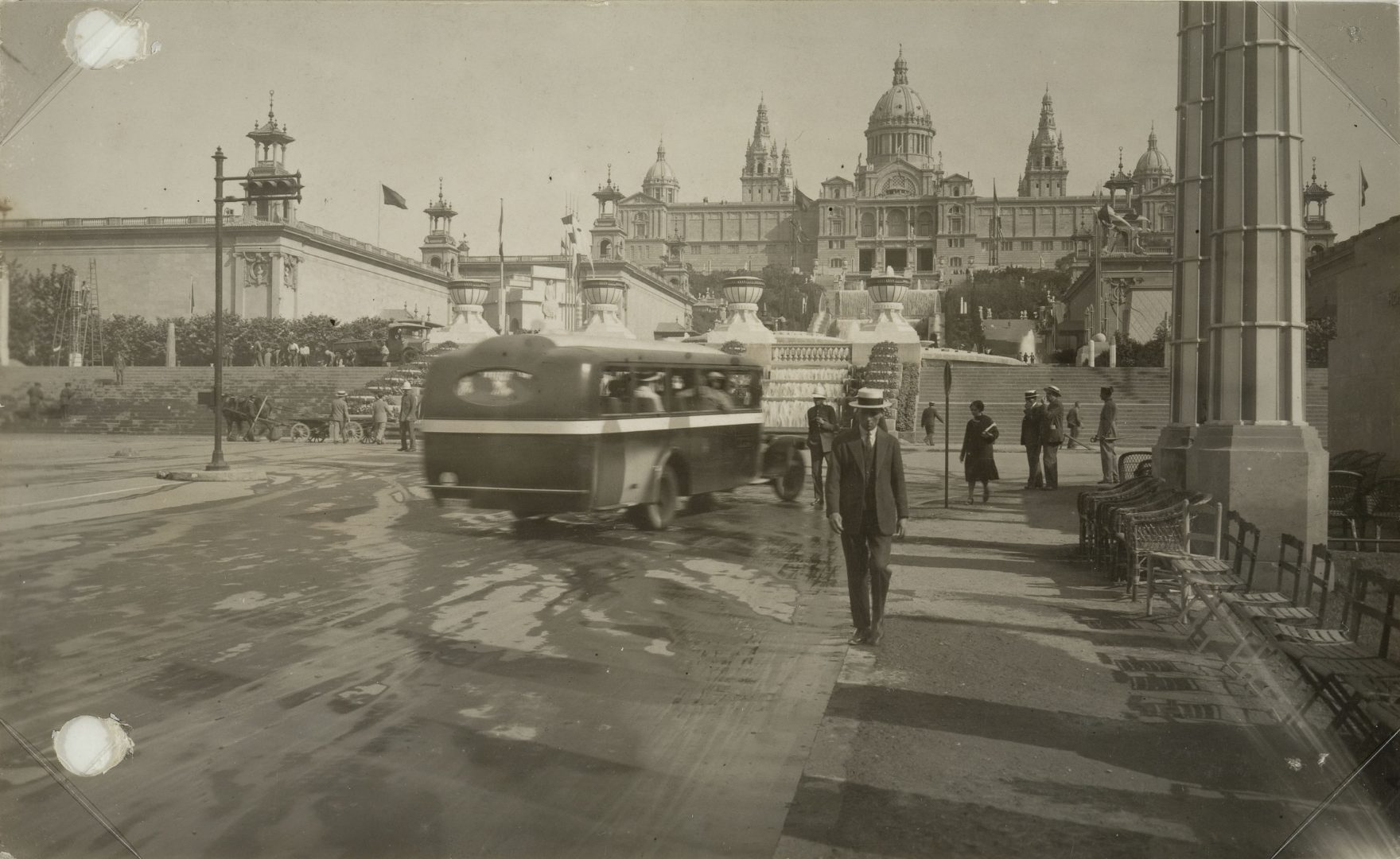
1st Section: Symmetry in Nature. The Laribal Gardens
The Laribal Gardens – From the “Colla de l’Arròs” Rose Garden to the Ceramic Fountain
Transcript
The Laribal Gardens – From the “Colla de l’Arròs” Rose Garden to the Ceramic Fountain
Passing the Ethnological Museum on the right, we enter the first gardens on the itinerary, the Laribal Gardens, a spacious, beautiful area of Montjuïc, full of harmony, natural springs and popular celebrations.
From this spot, we can see the rose garden where the “Colla de l’Arròs” Gastronomic and Political Society met in the late 19th and early 20th centuries. In fact, the land now occupied by the Ethnological Museum once housed the Balaguer Pavilion, built in 1917 by the Modernista architect Puig i Cadafalch. It was named in honour of Víctor Balaguer, a writer, journalist, politician and one of the main figures of the Catalan Renaissance, as well as a prominent member of the “Colla de l’Arròs”.
In general, however, it was frequented by the working classes who gathered at the numerous fountains on Montjuïc to celebrate certain dates, such as the St John’s Eve or the “Burial of the Sardine” at the end of Carnival. It was also customary to enjoy a Sunday of recreation around the water, an ancestral tradition that, in the case of Montjuïc, dates back to when the mountain was occupied by cultivated land, farmhouses and chapels.
The fontades, as these traditional gatherings were called, became even more popular during the city’s industrial boom. Montjuïc was an oasis of tranquillity in turbulent times; an opportunity to come into contact with nature and a place in which to share food, music and laughter with others.
Today, the garden is still a quiet and restful place where you can walk and get lost in its hidden corners, either alone or in company. It is a refuge from the bustle of the city in which to pause for a moment, to treat yourself, to feel the heartbeat of time. In Barcelona we are lucky enough to have Montjuïc, our mountain of gardens. So let us walk among these rose bushes while contemplating their splendour of green and colour.
Leaving the rose garden and the pergola behind us, we come to the Ceramic Fountain. It was designed by Llorens Artigas in the Laribal Gardens, which were named after the owner of the land who sold it to the city council in 1908 with the aim of beautifying the mountain for the International Exhibition. The gardens, designed by the French landscape architect Jean-Claude Nicolas Forestier, with the help of Nicolau Rubió i Tudurí, were laid out between 1916 and 1919 by order of Josep Cambó. They incorporated a landscape style with Mediterranean roots that drew heavily on both classical tradition and Arabic influence.
In various parts of the gardens you can also find several decorative sculptures that are in perfect dialogue with the tranquillity and calm of the surroundings.
- Look: At this point you can listen to the photographic suggestion audio and practice your skills at the Ceramic Fountain.
– Listen: Sit on one of the benches near the fountain to hear the soft murmur of the water flowing from the fountain or the spirited singing of the birds.
Laribal Gardens – from El Gat Fountain to the Generalife Waterfall
Transcript
Laribal Gardens – from El Gat Fountain to the Generalife Waterfall
Continue towards the path you will see next to the building on the right. Go straight on with the Ceramic Fountain to your back. Then climb the stairs on the right until you reach what is perhaps the best-known fountain in Montjuïc (with apologies to the Magic Fountain!): the Font del Gat or Cat Fountain.
This work by Josep Antoni Homs is next to a Neo-Moorish style building by Josep Puig i Cadafalch. Sculpted inside a pumice stone arch, the fountain has the shape of a cat’s head and hence its name. It is a cool space because it faces north, which makes it very popular in summer. There is even a traditional Catalan song that refers to it. You’ve probably heard it… “Going down from the Cat Fountain, a girl…” Sound familiar?
Leaving this emblematic space, turn right and climb the stairs until you reach the path. Once at the top, you will see the cattle trough. Turn left and keep walking until you come to the Generalife Fountains, with stairways on either side. These stairs were proposed by Forestier inspired by the Generalife and Los Cármenes gardens in Granada. You will see a series of overlapping terraces that bridge the difference in level and connect the Laribal Gardens with Ramon Reventós’ Greek Theatre. There are narrow paths, ponds, benches to rest on, a pergola decorated with flowers, etc. You’ll find it all in this corner of the mountain that exudes calm accompanied by the gentle sound of the water.
Climb the stairs and once at the top you will find yourself at one end of the pergola, a good place to stop and listen to the health tips audio clip.
Next, to go to the Sculpture Garden and activate the orientation audio clip.
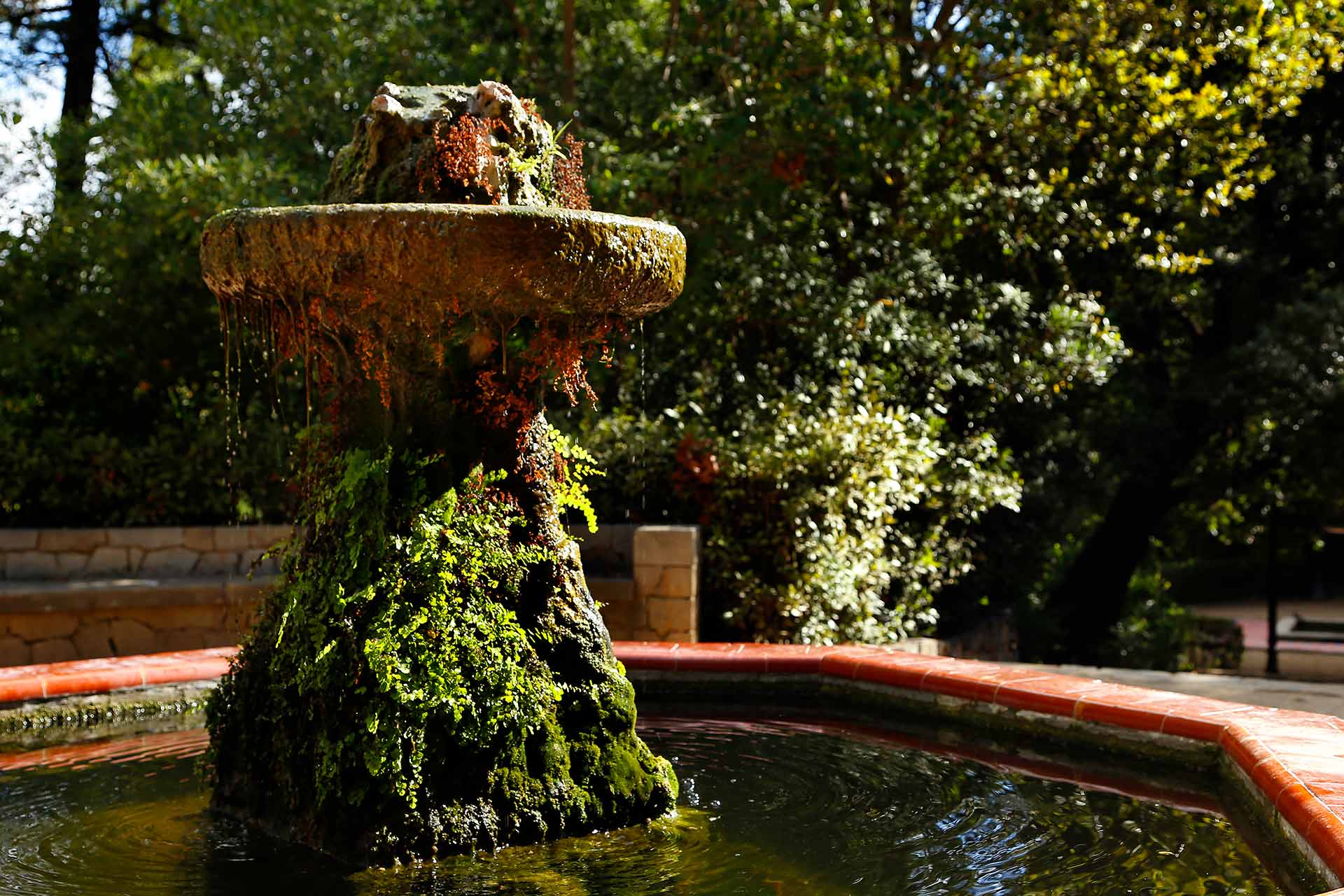
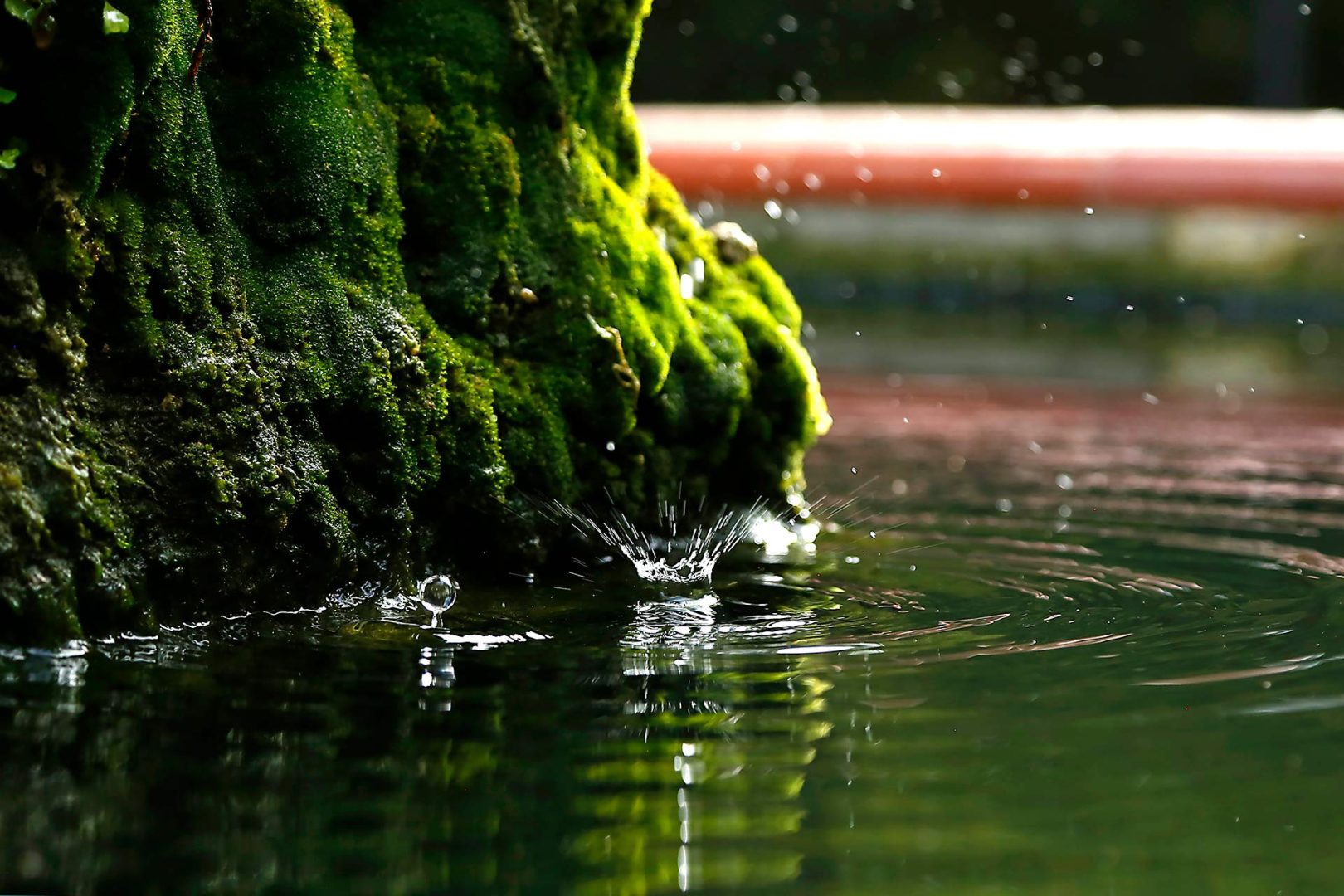
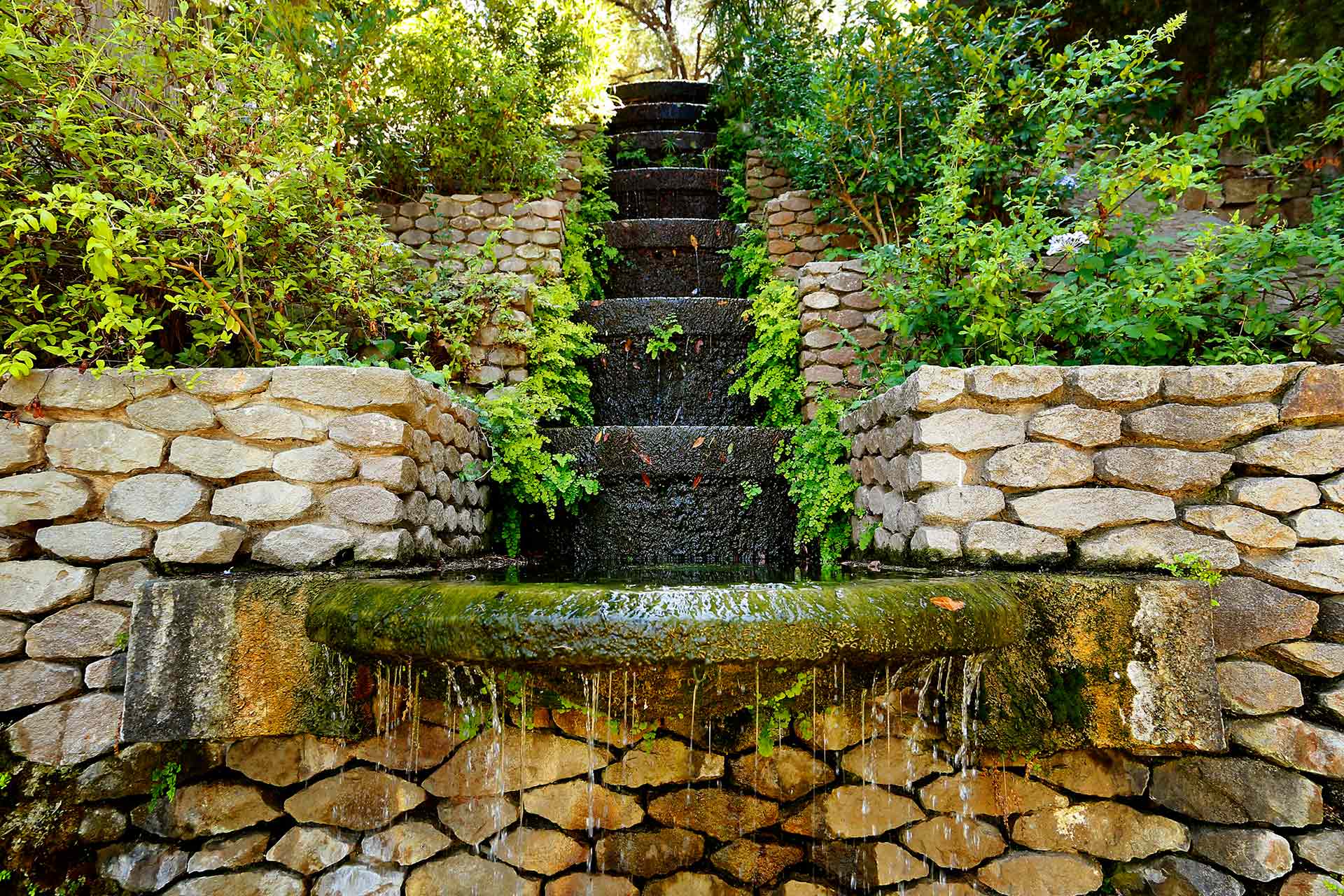

and well-being
suggestions
content
From the Laribal Gardens to the Sculpture Garden
Transcript
From the Laribal Gardens to the Sculpture Garden
To get to the Sculpture Garden head towards the centre of the pergolas and you’ll see some steps with a tree right in the middle of them.
Climb them and once at the top go to the left where you’ll find the “Repose” sculpture by Josep Viladomat. The building in front is the Joan Miró Foundation. The Sculpture Garden is behind it.
Map
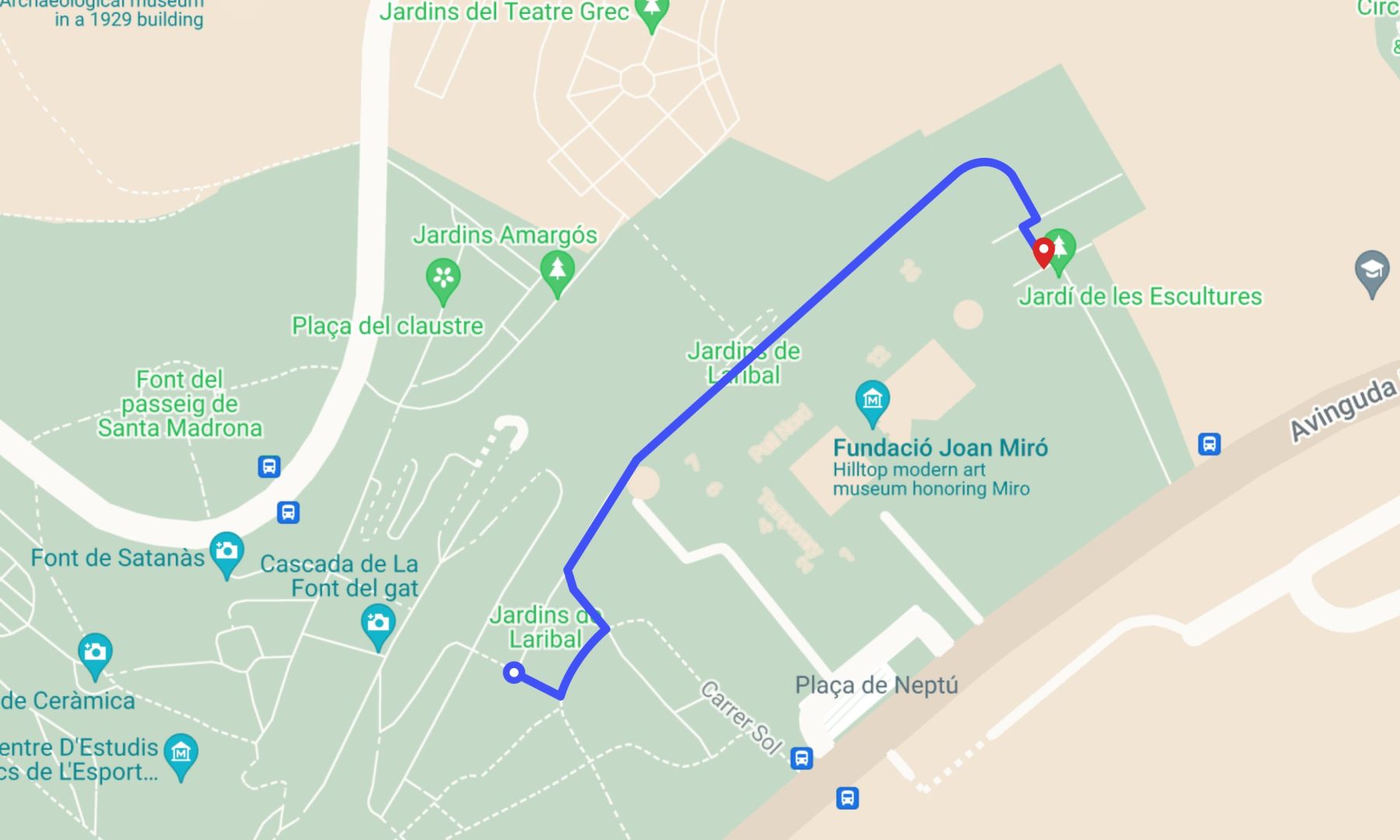
Relaxation exercise
Transcript
Relaxation exercise
When you reach the pergola, look for one of the benches in the shade. Make yourself comfortable and observe nature with the city in the background.
Then close your eyes for a moment. Feel your weight rooted in your feet. Let the sounds of nature come to you, without effort. Don’t judge, don’t try and change anything, just observe. Then, slowly bring your attention to your breathing. Count “one” when you inhale, “two” when you exhale, “three” when you inhale, “four” when you exhale, and so on until you reach the number ten. When you get to ten, gently open your eyes. What do you notice in your body? Is it the same as when you started this short meditation? Again, don’t judge, just feel if there’s been any change or none at all. Either way it’s fine. What about your mind? Is it the same as when you started this short meditation? Again, don’t judge, just observe if there’s been any change and also if there hasn’t. Both are fine.
Framing
Transcript
Framing
These lush gardens are an ideal place in which to experiment with your camera, photographing everything that’s there and going on around it. Observe the immense trees or the tiny creatures hiding behind the leaves or in the pools of water. Look at all the worlds that are hidden there, see them from another perspective. As the photojournalist Robert Capa used to say, “If your pictures aren’t good enough, you’re not close enough”.
On this section of the route we’ll talk about the importance of composition, the arrangement of the elements in a picture and how they are placed. This is one of the most creative moments of the process. It’s like when a painter decides how to arrange the features in a painting or when a musician decides which notes to play and in which tempo. Symmetry will help you create pleasing and beautiful images. Straight lines and frontal framing will give you static sensations, curved and diagonal lines and a sense of movement.
When you frame a shot through the viewfinder or the screen, you have to decide which elements will be seen. It’s as important to decide what will not be included and as what will. Do you want to show the whole garden or just part of it? Which will be the main features and which will be secondary, and how should they be highlighted?
At this point you can practice the rule of thirds, a basic rule for composing visual images: two horizontal and two vertical lines divide the image into nine equal parts and serve as a grid to position the elements of photograph. The main elements of attention are placed at the four intersection points, sometimes called the “power points”. Thus a balanced and symmetrical image is created (on most mobile phones the grid can be activated in the configuration section).
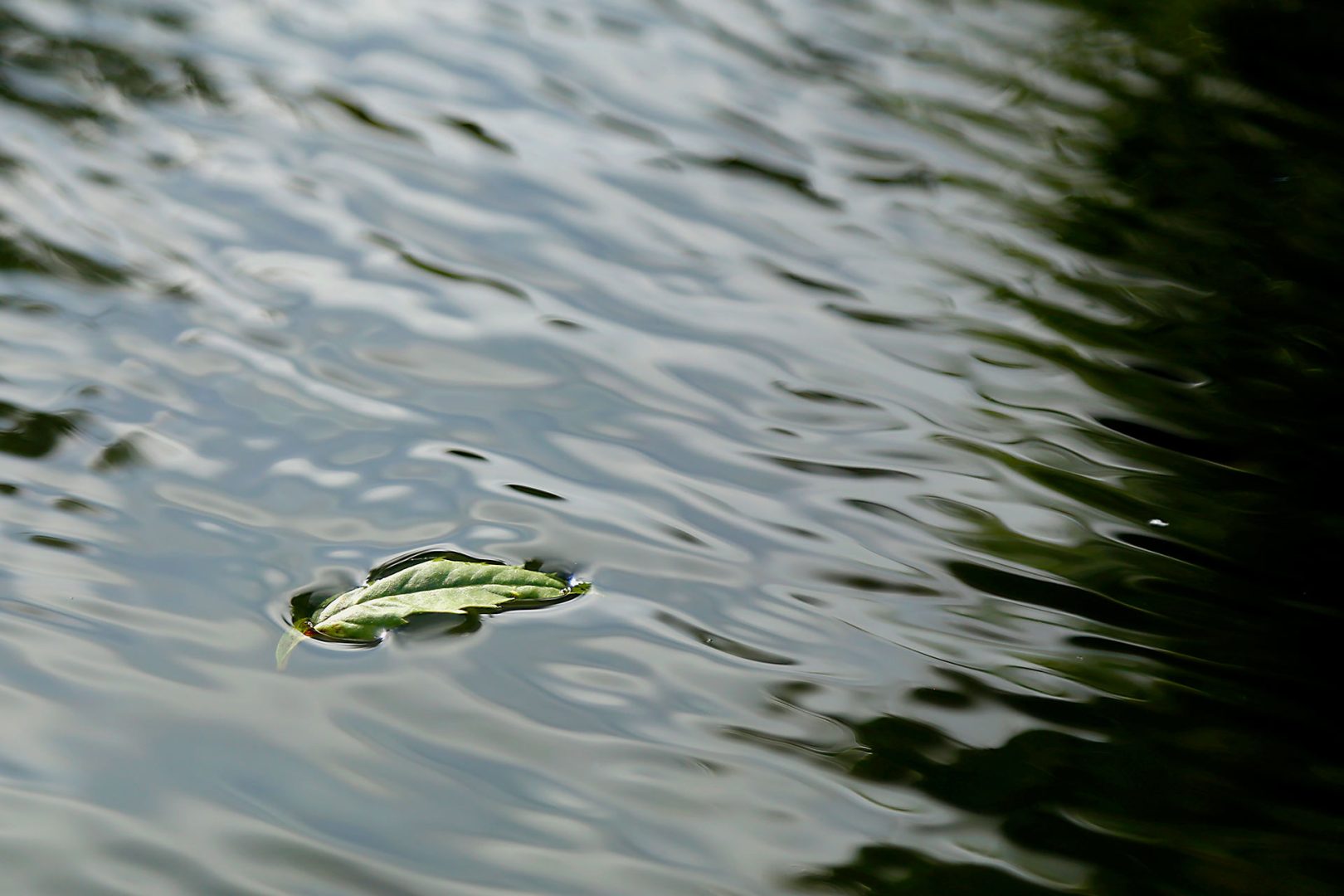
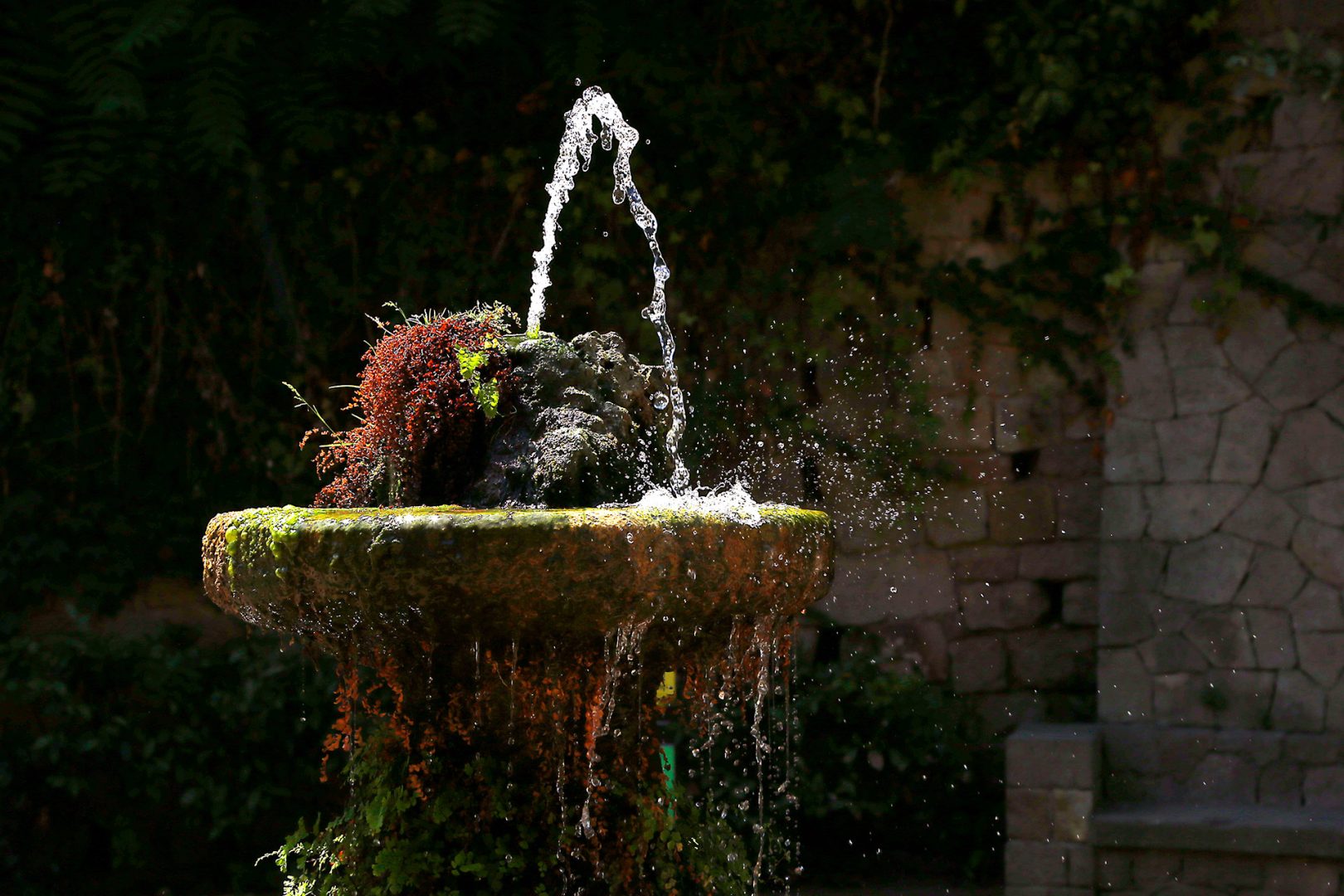
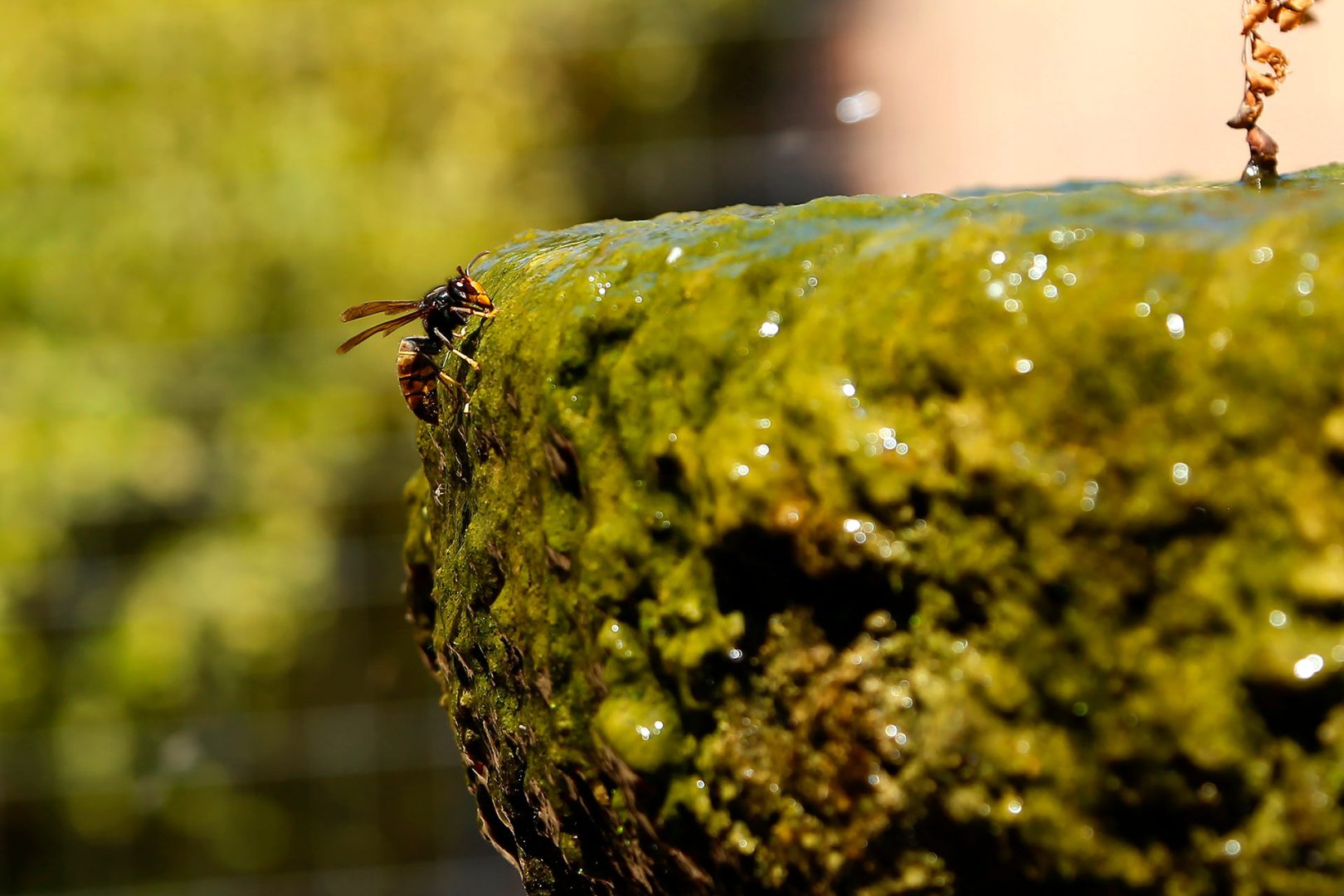

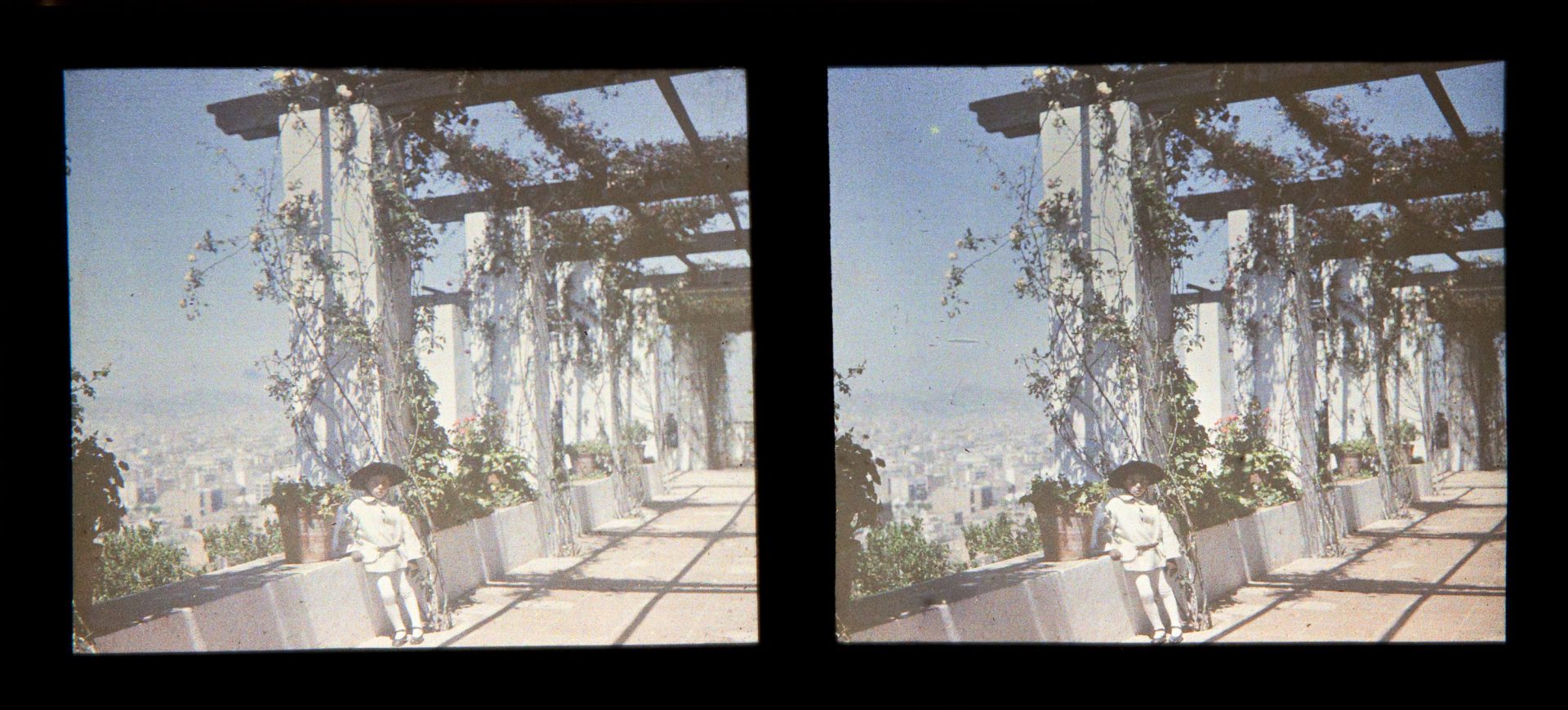
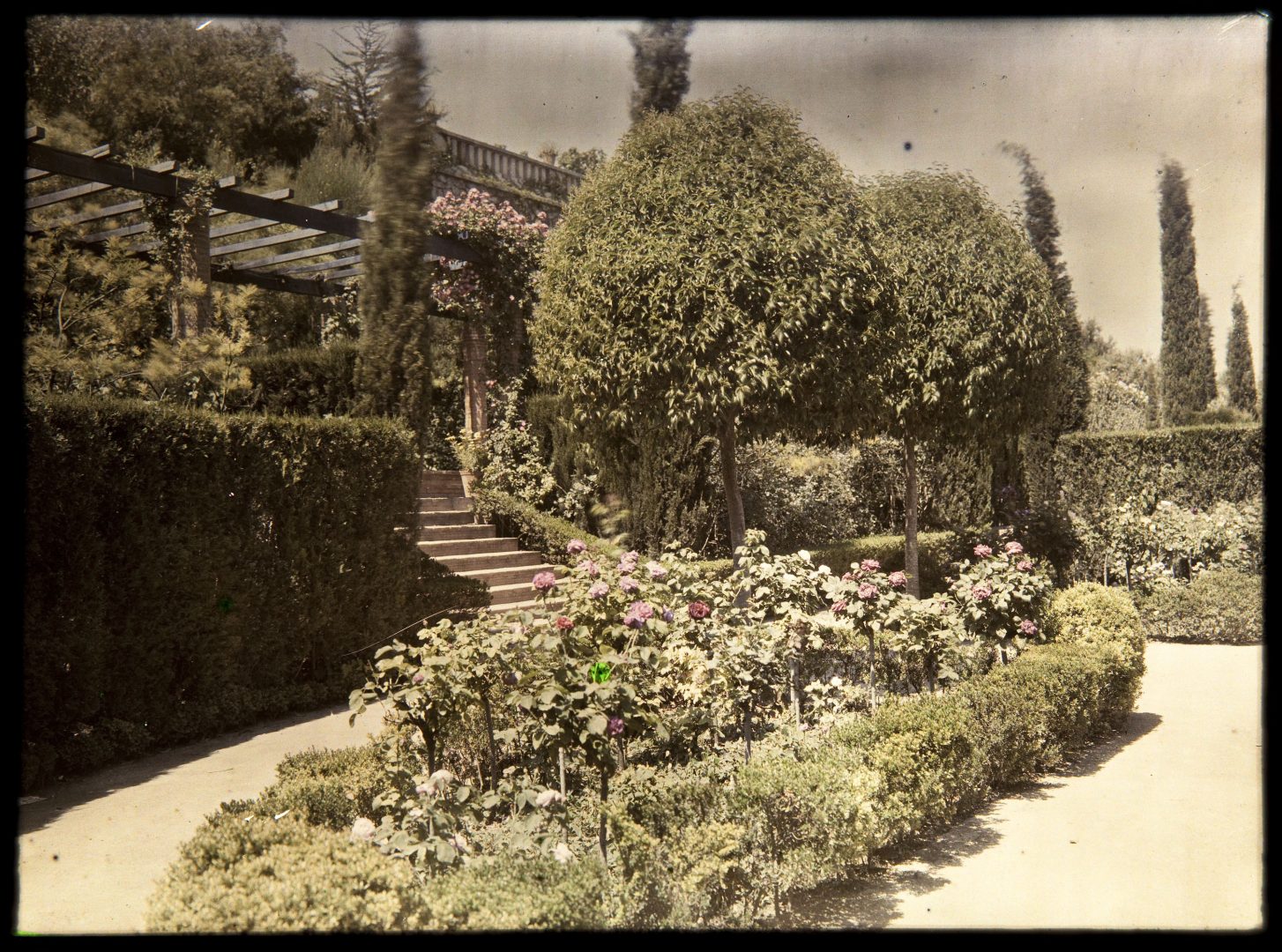
ITINERARI MONTJUÏC JARDINS
2nd Section: Change of perspectives. The Sculpture Garden
The Sculpture Garden
Transcript
The Sculpture Garden
We come to the rear of the Miró Foundation in the Sculpture Garden, an annex created in 1990 and rebuilt in 2002. The Joan Miró Foundation was established by the artist himself in 1975 and is a cultural reference both for his own work and for contemporary creation.
The building itself is a dialogue between Miró and his friend and architect Josep Lluís Sert, who designed a building in which light and nature enter to become part of the museum itself. Light, colour and the forms of nature are also a source of inspiration and a recurring theme in Miró’s work.
Here and now, art, architecture and nature help us switch off and reconnect. Art gives us tools to express emotions and thoughts, to see the world from another perspective, or simply to let ourselves be carried away by the enjoyment of beauty.
In this sculpture garden we can see how nature has also inspired artists to create and to wonder about their relationship with the world. For example, in his book Breviario de un viejo corredor (Breviary of an Old Runner) (Editorial Siruela), the artist and museographer Lluís Alabern reflects on one of the fundamental pillars of his life: his impulse to travel and follow directionless paths.
He tells us:
In his treatise Walking, Thoreau comments: “As a man grows older, his ability to sit still and follow in-door occupations increases. The old road runner breaks with this very human postulate, returns to the wild state that forces him to be always alert, always on the move. He embarks on a path he does not know to reach an unknown place. When I want to relax, I look for the darkest forest, or the swamp that, in the eyes of my fellow citizens, is most impenetrable and gloomy. I walk around it as if it were a sacred place; a sanctum sanctorum. There lies the force, the core of nature, concludes Thoreau. Trotting into the forest activates the springs of attention. We reconnect with nature. Only if we draw aimlessly, only if we enter a winter walk, the dense vegetation of the unknown, will the drawing take us to a new place.”
All over the garden we find diverse pieces of contemporary art by various authors. You can find the list in the additional contents section. Dominant in the centre, however, is the sculpture by Josep Montserrat of “Manelic”, the protagonist of the play “Terra Baixa”, a classic of Catalan theatre written by Àngel Guimerà. The play is a romantic tragedy and a realist drama in which symbolism and nature play a central role. It is also very representative of the context of Barcelona at the end of the 19th century, when social conflict and class struggle were strongly felt in the Poble Sec quarter and in Montjuïc.
“… When all of a sudden I hear a rush and a trample, and jumping like a devil, the wolf passes over me, snorting so hard that I felt its snout on my neck, and my hair stood on end, and here inside some stronger blows that suffocated me!… All at once, in the herd, a horrifying howling and barking and bleating of the sheep. And how angry I was at myself for not having tackled it, the huge wolf! And I do not know how it happened, that I am standing in the middle of the path where the wolf had to pass… And when the beast turns with the lamb in his mouth, it crashes into me and I into it, and I confront him, and plunge this whole blade into him. And it running or rolling down the hill, and I with it; we are in each other’s embrace; I biting it and it me, and both of us howling, I a hundred times more than it, like two wild beasts.”
In a temporal and geographical leap, from Guimerà we move on to Dante Alighieri, the great Italian poet of the 13th century. Have you ever imagined what the entrance to hell would be like? If you head towards the exit door you will find a contemporary interpretation by the artist Jaume Plensa entitled “Dell’arte”. It refers to the entrance to hell from the Divine Comedy.
Art can calm, excite, agitate, surprise or make us imagine new worlds: from lost paradises to unspeakable hells, passing through dystopian futures or new ways of facing the challenges that confront us.
- Look: Observe from another perspective by following the photographic suggestions.
– Listen: A sculpture garden may seem like a silent space, but if you listen carefully you can hear the world around it, always in constant motion.
Before continuing to the next section of the itinerary, in this large space you can stretch various parts of your body while listening to the health audio clip. Then, to continue the route, activate the “Orientation” audio.
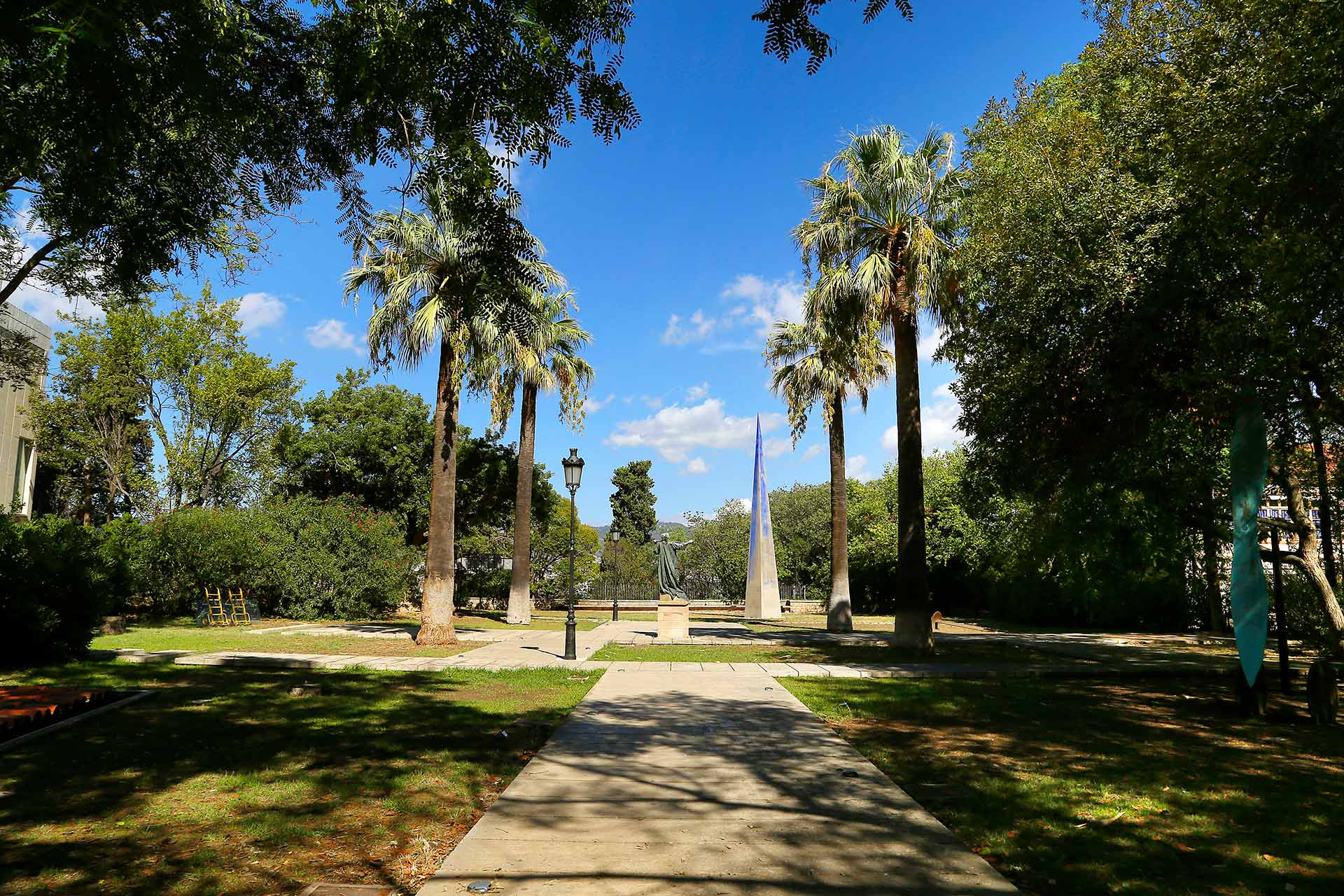
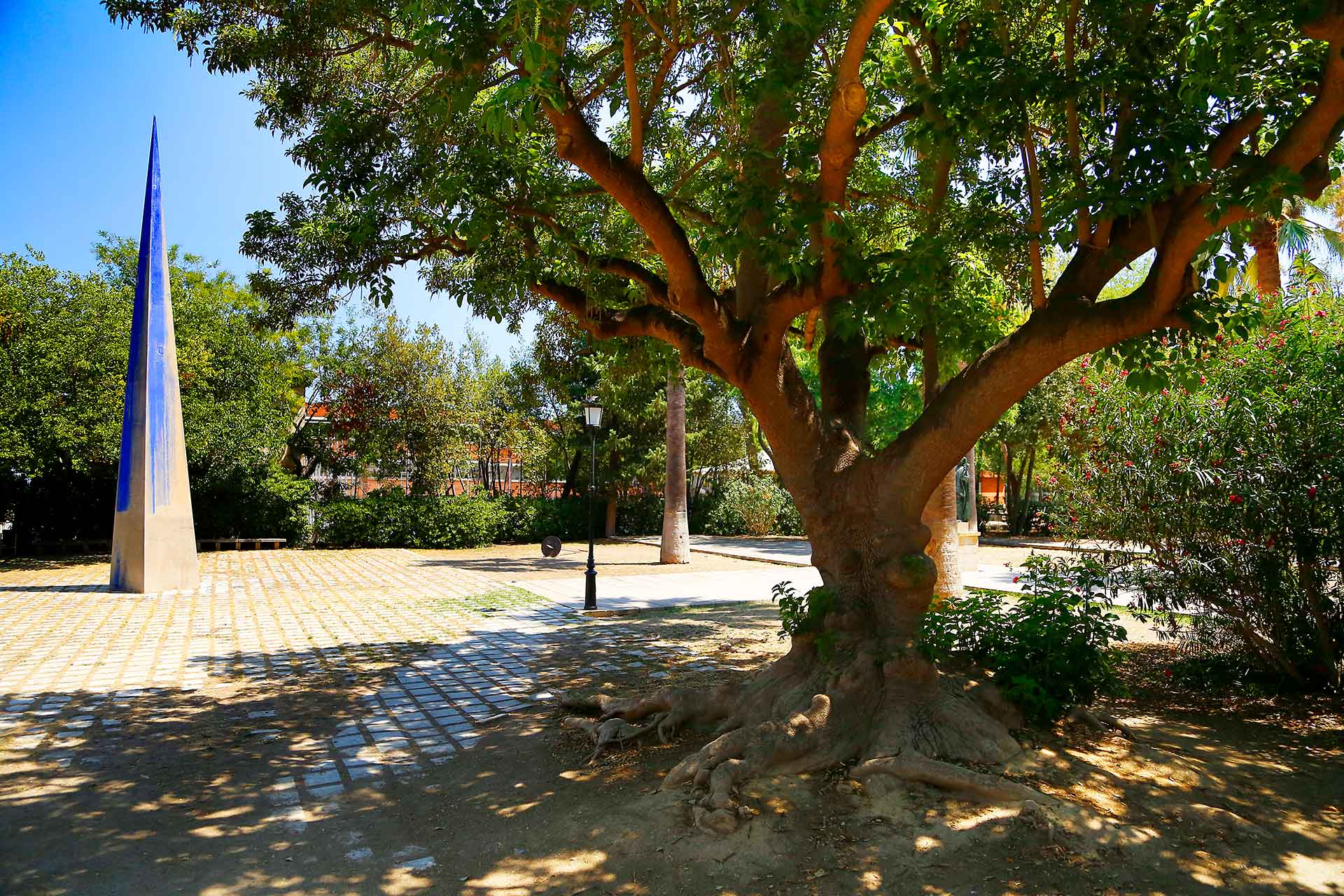
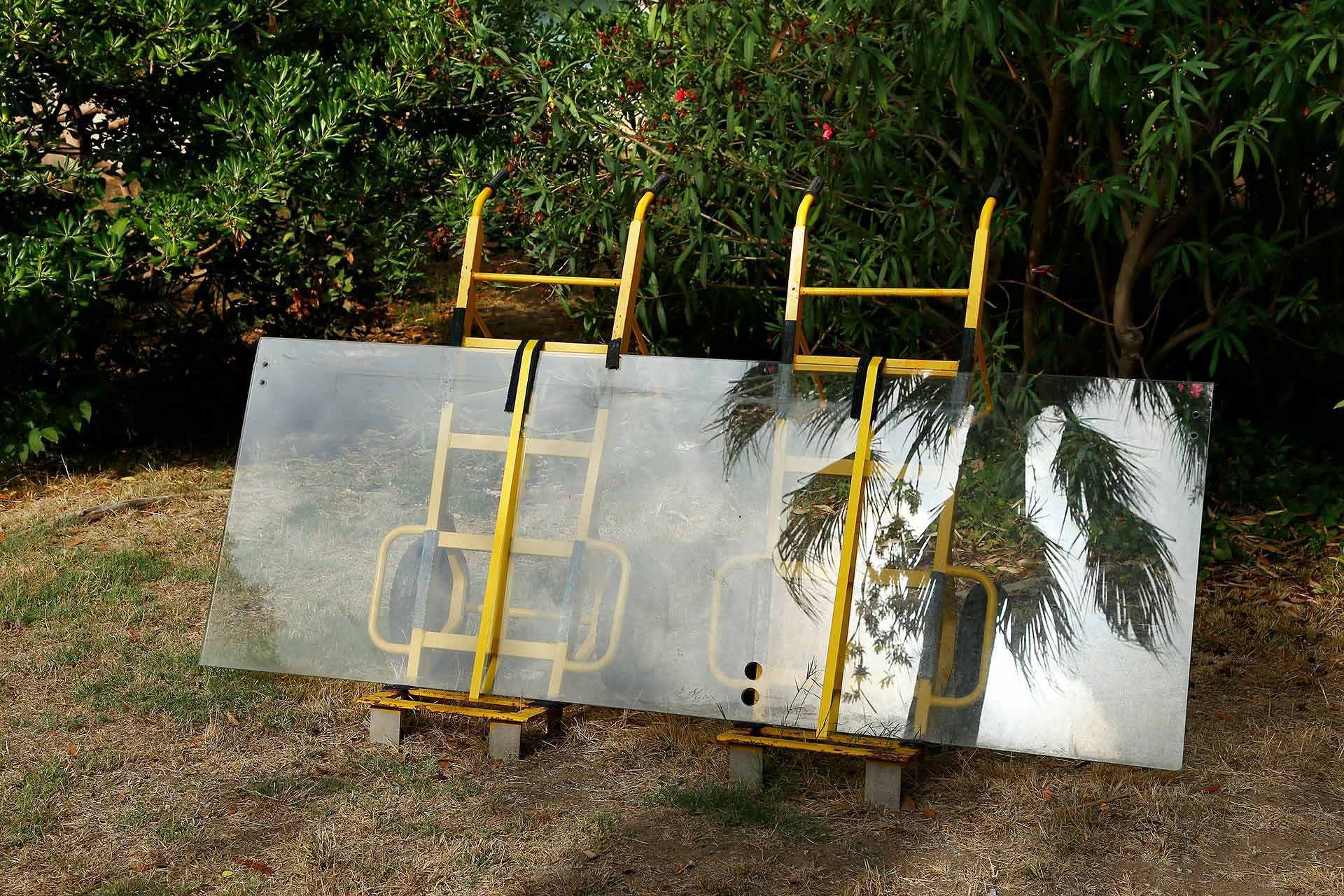
and well-being
suggestions
content
From the Sculpture Garden to the Mossèn Cinto Verdaguer Gardens
Transcript
From the Sculpture Garden to the Mossèn Cinto Verdaguer Gardens
Leaving the Sculpture Garden you come to the busy Miramar Avenue.
Turn left and follow the avenue until you come to the Cable Car station. Cross the pedestrian crossing in front of it. Continue along the pavement to the left and go up to the right towards Carrer dels Tarongers. After about 50 metres you’ll come to the main gate of the Mossèn Cinto Verdaguer Gardens.
Map
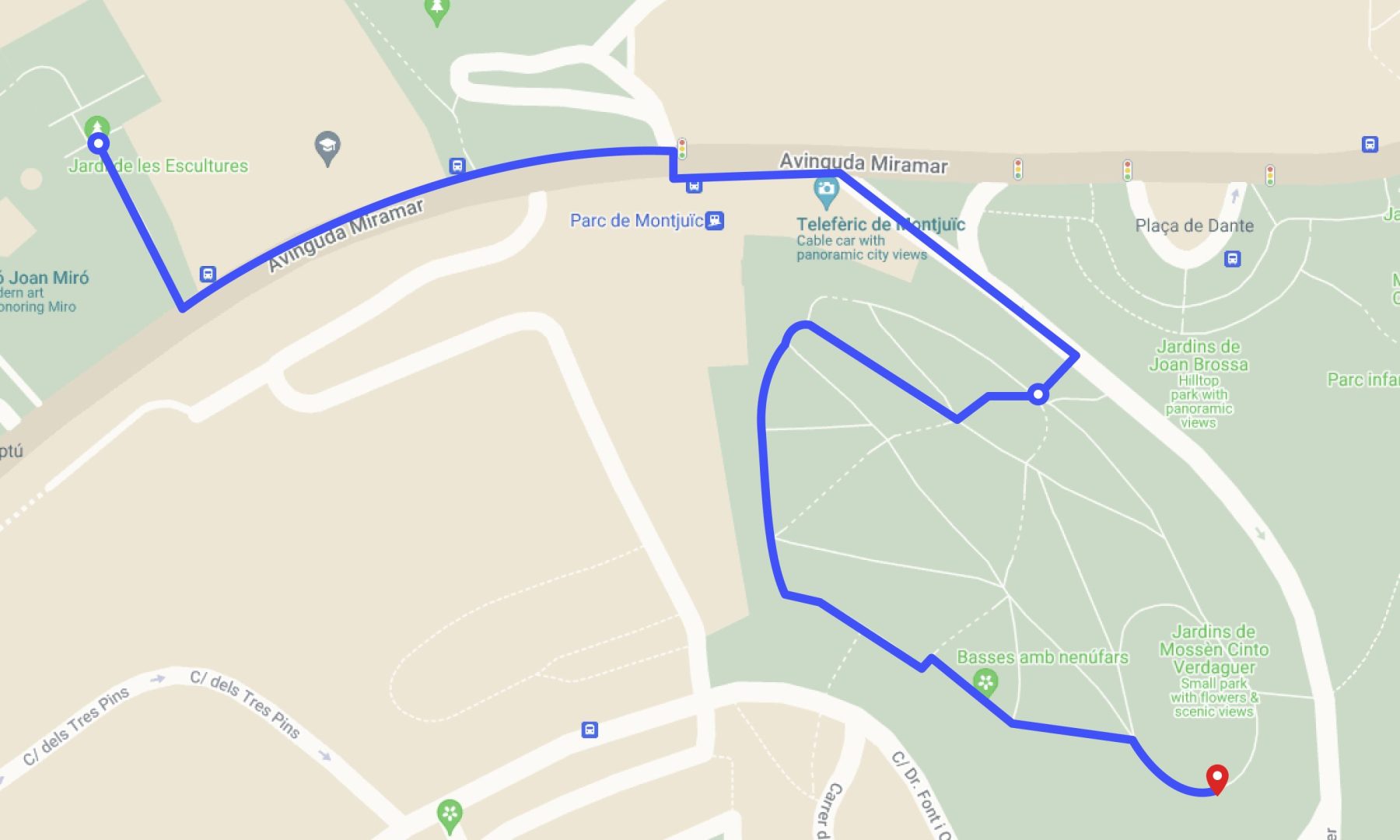
Body stretches
Transcript
Body stretches
You may notice that your body is a little tense at this point, so I suggest a series of tension-releasing exercises. Now you’re in the Plaça d’Escultures, look for a quiet spot. It can be on the stairs you’ve just come from, the benches on the side or next to the tree alongside the Foundation building. Any place you choose will be fine. Take it your own pace, don’t force it and do as much as your body can. Always remember to make gentle movements. Here we go!
Open and close your fingers wide. Once you’ve done this a few times, shake your hands downwards, as if you’re trying to loosen something stuck to them.
Pass your right hand over your head and bring it to the nape of your neck. At the same time, bring your left hand to your lower back. The movements should be gentle, not forced. It doesn’t matter where you end up, we just want to let your body relax and release any possible discomfort. Then, repeat the movements the other way round: your left hand goes to the nape of your neck and the right hand to your lower back. Repeat the exercise several times. We’re not looking for speed, but to make the movement wide and fluid, without straining yourself.
Rest your weight on your left foot and bring your right knee up. Again, it’s not about forcing your body or losing your balance, the aim is to give your legs some mobility. Then rest your weight on your right foot and bring your left knee up. Repeat several times.
Without moving your body, turn your head as if you want to look over your right shoulder. Gently and consciously, turn your head the other way as if to look over your left shoulder. It’s very important to make this movement slowly to avoid getting dizzy. As you do this, I want you to feel your neck muscles stretch in the direction of your gaze.
Once your body has been stretched, drink some water to make sure you’re properly hydrated before you continue with the itinerary.
Perspective
Transcript
Perspective
Now we’ve worked on framing, we also need to consider perspective when creating the image. Perspective is both the relationship of the objects with each other and the direction and position from which the photograph is taken.
We usually take pictures from our eye level. That’s understandable, it’s the point from which we see the world. But why not take a risk and change the perspective when taking photographs – and also in life! This helps you see things as you may never have seen them before. Take the photo from ground level or from the top of some steps looking down. Move around, look for different angles, you’ll see how your pictures will be much more creative!
The high-angle shot is when the camera is located above the photographed element, and the low-angle shot is just the opposite, with the camera at a lower level.
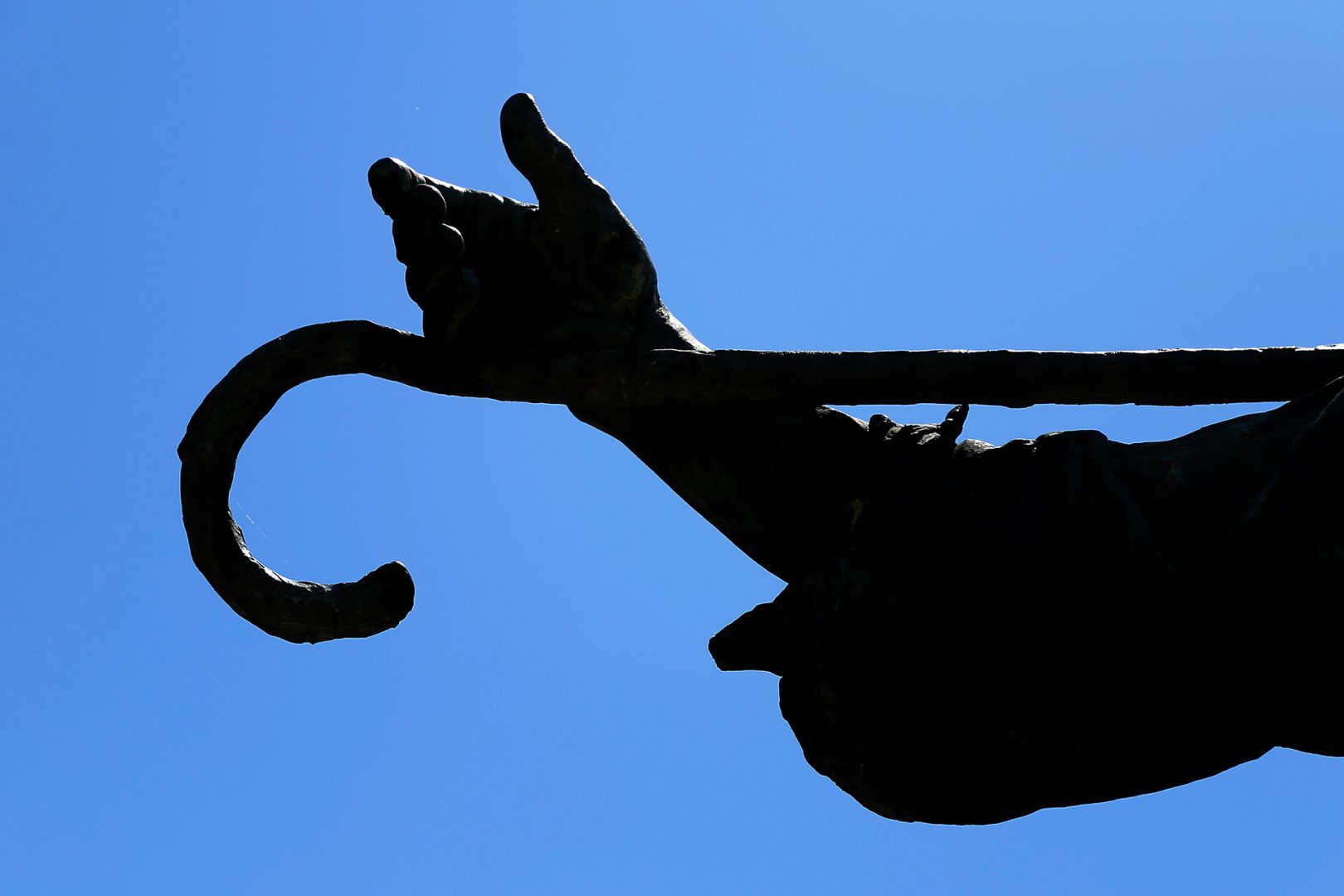
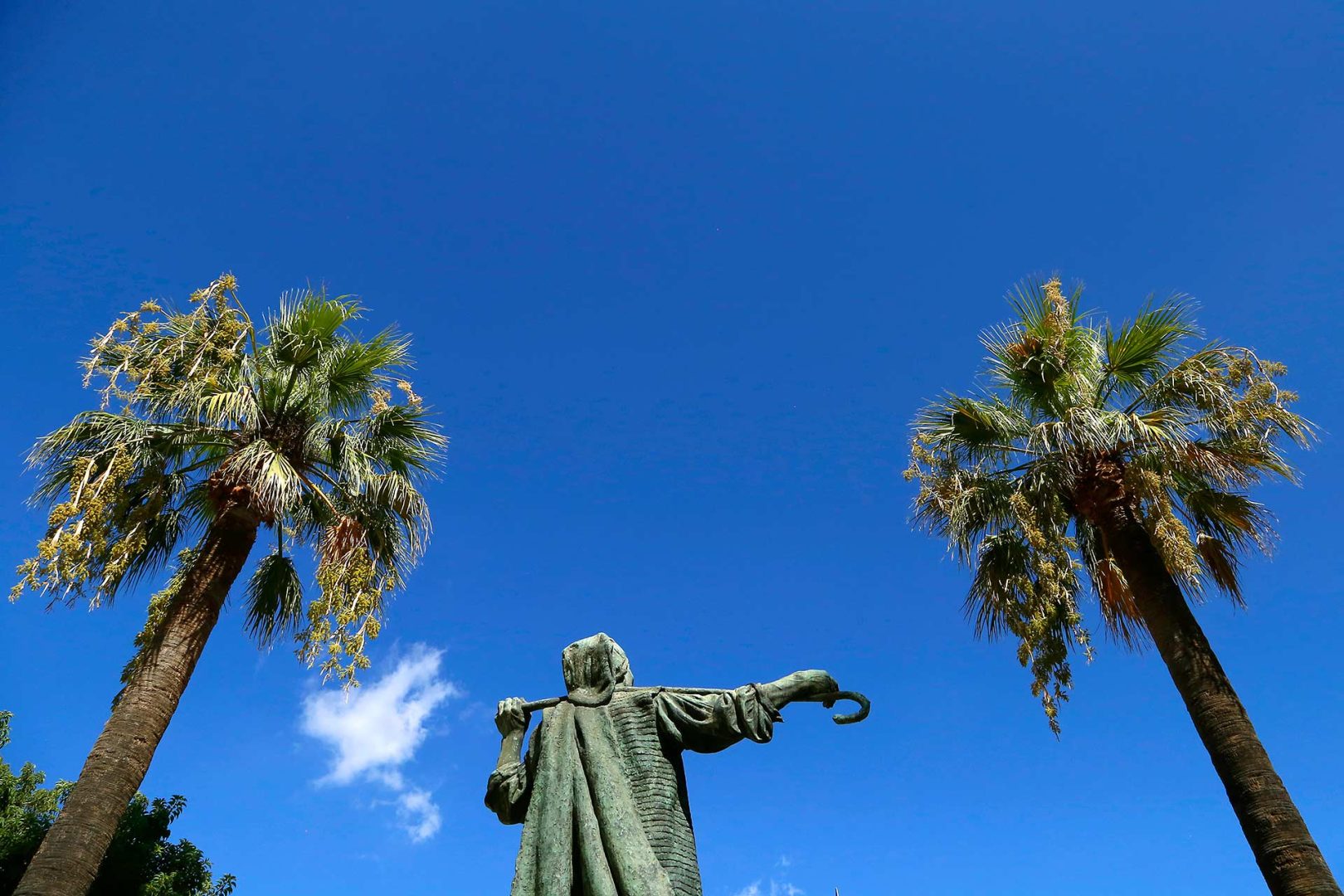
Extract from “Breviario de un Viejo Corredor” (Breviary of an Old Runner) by Lluís Alabern
In his treatise Walking, Thoreau comments: “As a man grows older, his ability to sit still and follow in-door occupations increases. The old road runner breaks with this very human postulate, returns to the wild state that forces him to be always alert, always on the move.
He embarks on a path he does not know to reach an unknown place. When I want to relax, I look for the darkest forest, or the swamp that, in the eyes of my fellow citizens, is most impenetrable and gloomy. I walk around it as if it were a sacred place; a sanctum sanctorum. There lies the force, the core of nature, concludes Thoreau. Trotting into the forest activates the springs of attention. We reconnect with nature. Only if we draw aimlessly, only if we enter a winter walk, the dense vegetation of the unknown, will the drawing take us to a new place.”
3rd Section: A burst of colour! The Mossèn Cinto Verdaguer Gardens
The Mossèn Cinto Verdaguer Gardens
Transcript
The Mossèn Cinto Verdaguer Gardens
You find yourself before the entrance to a little jewel in the heart of Barcelona, a feast for the senses: the Mossèn Cinto Verdaguer Gardens. They are one of the most peaceful and beautiful places in the city, but are not that well known. They are an oasis full of trees and vegetation, but above all of bulbous and aquatic flowers of intense and vivid colours.
The garden was laid out in 1970, together with the Mossèn Costa i Llobera and Joan Maragall Gardens, all three in Montjuïc and all three dedicated to Catalan poets.
Jacint Verdaguer or Monsignor Cinto, was one of the key figures of the Catalan Renaissance and enjoyed enormous popular support throughout his extraordinary life. An observer of nature and a great connoisseur of every mountain, bird, flower and tree, for him poems were like flowers, and this is how he talks about them:
”You are, O flowers,
the toys of angels,
the promise of heaven
the memory of paradise lost,
the pledge of paradise that awaits us,
symbol and image of the pure soul”.
And this is how he sees spring:
”The clouds move on,
the sky clears
the snow thins in patches,
and on the slope the ice.
The mountains and hills cast off their winter clothes,
Dressing in green satin studded with pearls.
Listening in the farm, you hear the swallow sing,
On its pillow of greenery the primrose awakens.”
But beyond his great works, such as Canigó or L’Atlàntida, Jacint Verdaguer also described the mountain of Montjuïc in his poem “To Barcelona”:
“And seeing that you always take rocks from your bowels
To build your houses, which grow like trees with good moisture in the ground,
It seems that I say to the wave and the sky and the mountains:
“Look at her [Barcelona]; bone of my bones, she has become as big as me!”
Climb the stairs to the top of the garden enjoying every corner. Follow with your eyes the traces of time embodied in the ivy that defines the steps; caress the bark of the trees with your fingers, it is like a relief map of their history, like a rough but warm skin. Magnolias, poplars, eucalyptuses, cypresses and Japanese acacias accompany you on this walk.
In the middle of the garden is the bulbous plant collection; you will find some all year round, but others only bloom in the two major flowering periods: from March to April and from the end of July to the beginning of September. Another good reason to enjoy “The Art of Walking” again during those months!
Make your way to the highest part of the park by taking the stairs on the right. Once you reach the top you will find a small pond with a Japanese-inspired wooden bridge that hides many secrets.
To continue your tour, activate Audio Clip 6.
Water lilies
Transcript
Water lilies
You are in the most spectacular part of the park: thirty basins connected by small waterfalls where aquatic plants of exuberant beauty grow. And the indisputable protagonists are the magnificent water lilies! A spectacle of shapes and colours that live and float to the rhythm of the water.
Come close and look at every petal, leaf and swirl. Do you see anything else? Several colonies of amphibians also live in these ponds. Look for the little creatures hidden among the flowers, listen to the refreshing water falling gently into the basins. And if you feel like capturing the explosion of colours of the water lilies, we recommend you listen to the photography suggestions.
At the foot of the steps to the ponds you will reach the large lake in the garden, a place in which to relax and enjoy the company of a good book or simply to listen to the sounds of nature while contemplating the gentle movement of the leaves in the trees to the rhythm of the wind.
- Look: Become intoxicated with yellows, greens, lilacs and blues by observing the water lilies. Capture this burst of colour by listening to the photographic suggestions.
- Listen: Listen to the sound of the water in the ponds, and how it creates a cheerful vibrant music along with the buzzing of the dragonflies.
To enjoy this moment and this garden even more, listen to the health audio clip.
And finally, find a nice corner to relax in. We would like to offer you a very special gift. Let yourself be carried away by the words of the writer Marta Orriols in this short story created especially for you from the life of the Mossèn Cinto Verdaguer Gardens.

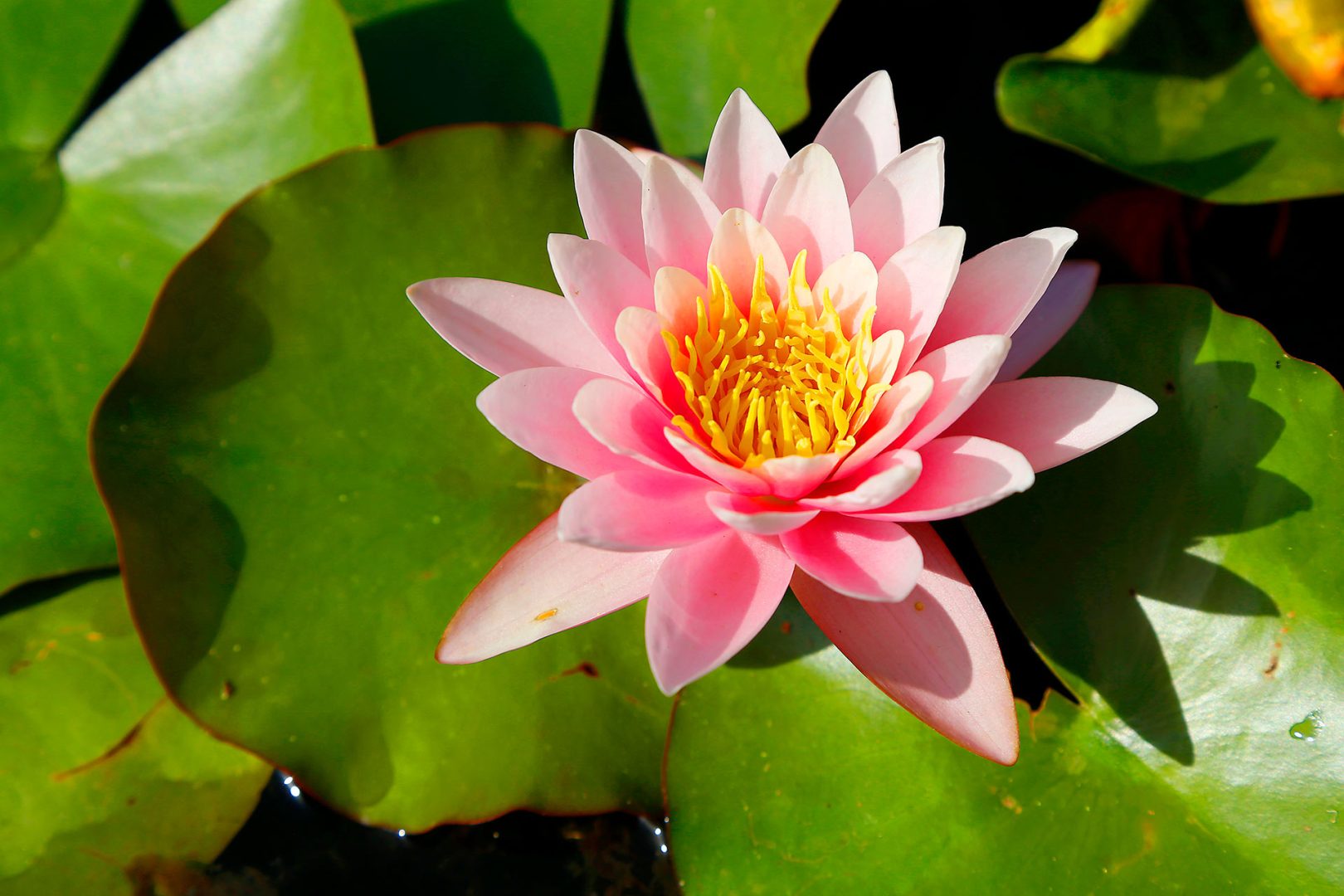
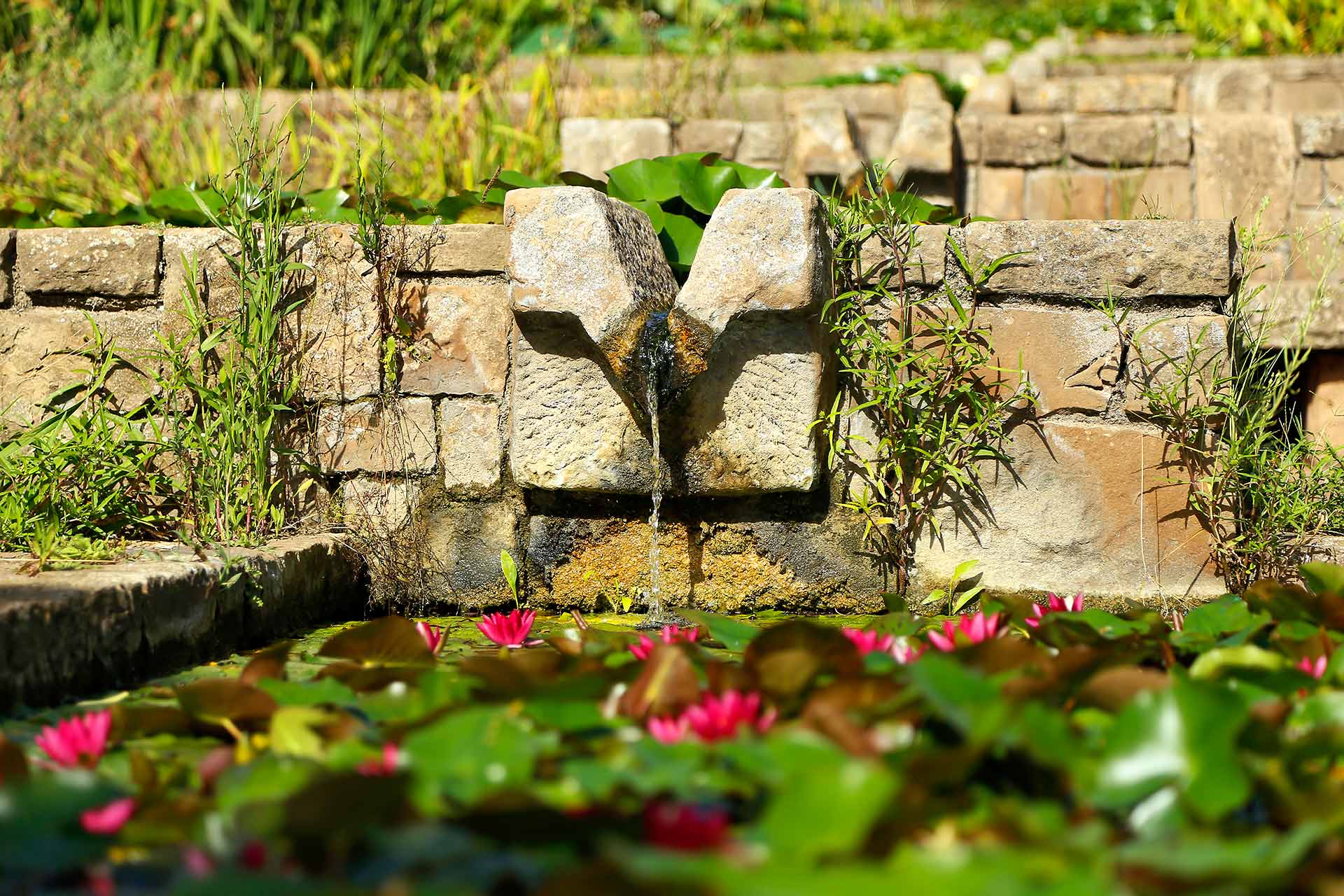
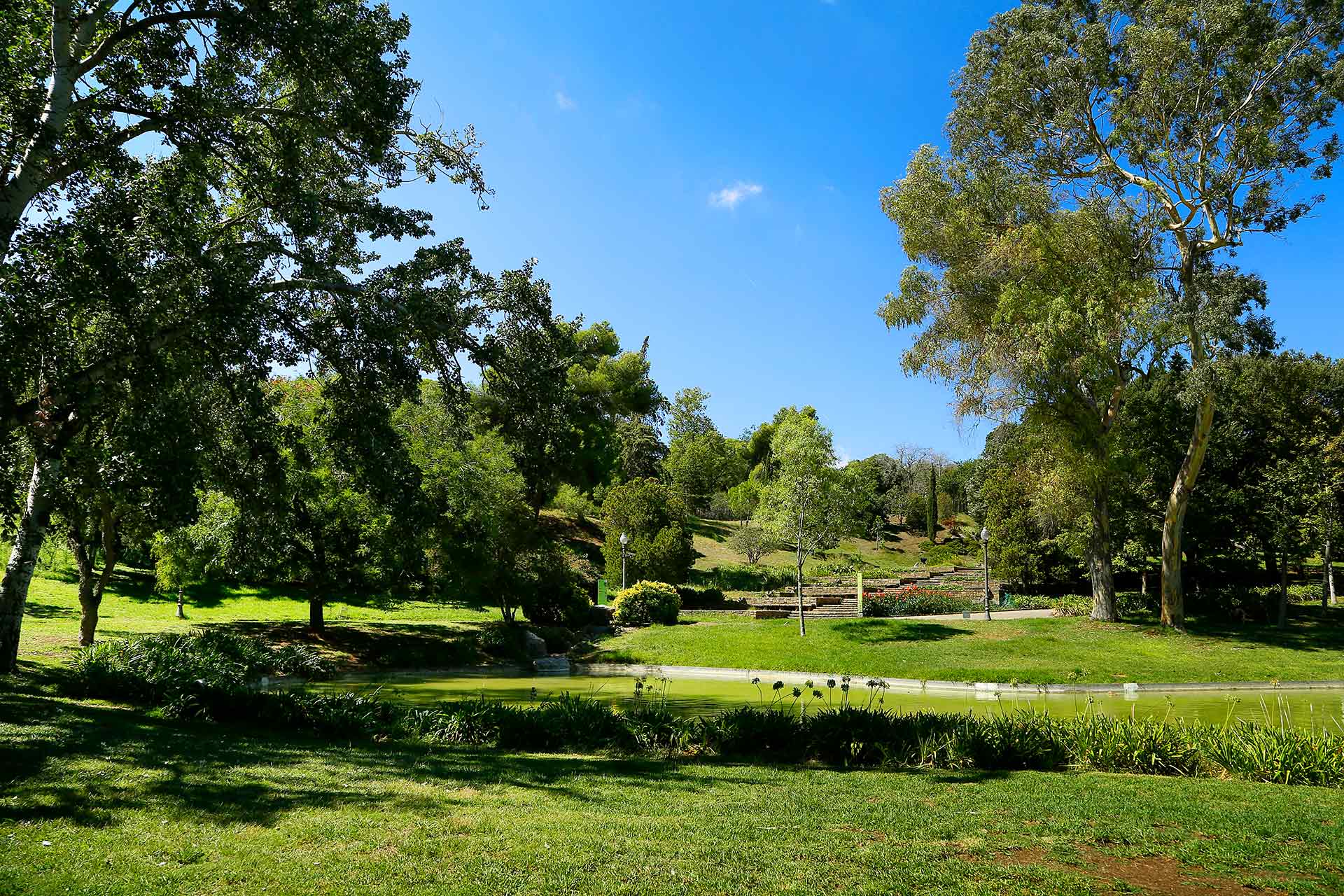
and well-being
suggestions
content
From the Mossèn Cinto Verdaguer Gardens to the Joan Brossa Gardens
Transcript
From the Mossèn Cinto Verdaguer Gardens to the Joan Brossa Gardens
To reach the Joan Brossa Gardens, go down past the aquatic plant ponds until you reach the small lake in the garden.
Right in front you will find the other entrance gate to the park, go through it, cross Carrer dels Tarongers via the pedestrian crossing and enter the Joan Brossa gardens.
Map

Sensations
Transcript
Sensations
As you walk through the green landscape of the Mossèn Cinto Verdaguer Gardens, I’d like you to pay attention to the pressure exerted by your feet on the ground. Note whether you lean asymmetrically on one and the other, or perhaps you support your weight equally on both feet. Again, we don’t want to judge or change anything, we just want to observe what’s there. What does the ground look like? Is it even or uneven? Are there any leaves on it? Is it wet or dry? Concentrate on these sensations. Remember, you’re taking a walk and you the aim is to enjoy the surroundings and its nature. Don’t run, don’t strain your body. Stop and admire the contrast of colours that nature offers us in contact with the light.
Bring your attention to the sensations on your skin. Can you feel a breeze? Perhaps it’s windy? Is it a rainy day and raindrops are falling on your face? Is it humid? Or, on the contrary, is it a dry day? Focus on all this, again without wanting to change it, accepting the day and the weather as it is.
Now I want you to become aware of any special smells; just let them come to you, without forcing them, without putting too much effort into it, paying gentle attention to your nose.
The magic of colour
Transcript
The magic of colour
At this point on the itinerary you’ll be able to use your cameras to capture the explosion and wealth of colours and textures that nature offers us with the bulbous flowers, water plants, the streams of water in the ponds and the magnificent trees of the Mossèn Cinto Verdaguer Gardens.
– To take close-ups of small insects or the texture of flowers, activate the “macro” or “supermacro” mode on your mobile phone (the flower icon). Nowadays almost all phones have this option. With this mode you can get very close, as near as 2 to 3 cm, and capture very sharp images.
– On many devices you can adjust the focus point by directly touching the screen and centring the part of the image you are most interested in focusing on.
– The colours of the flower petals are very intense and stand out very well against the green background of the leaves and stems. In this case, take advantage of the backlight of the sun’s rays on the petals (let the light come from behind the petals) and you’ll see how the colours are brighter and look like brushstrokes of light on the flowers.
Here you can also play with the reflections on the water. Look for symmetries and reflections both in the water lily ponds and the garden’s central lake. If it’s a sunny day, the reflection of the sun’s rays on the water can add a very creative touch to your images.
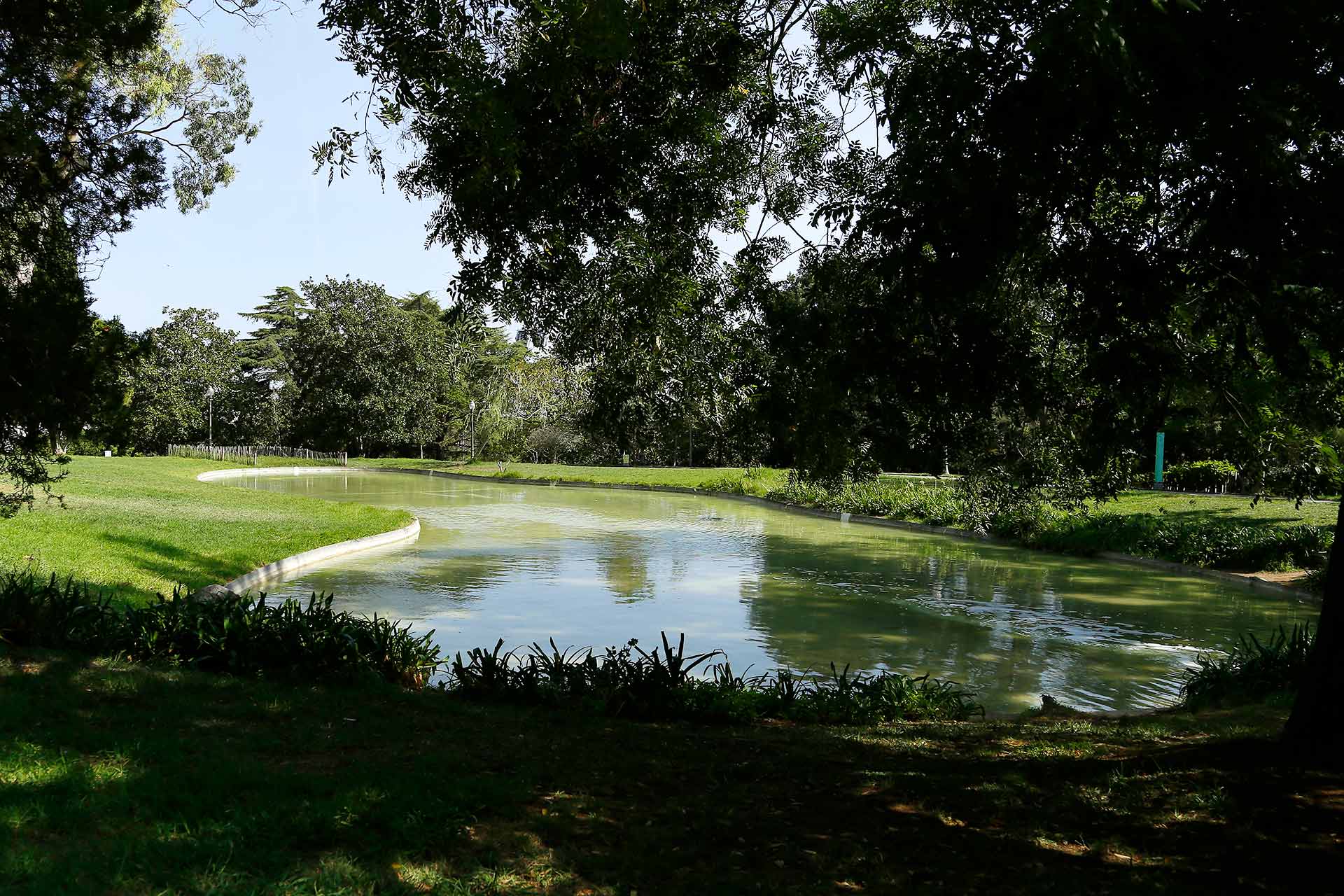
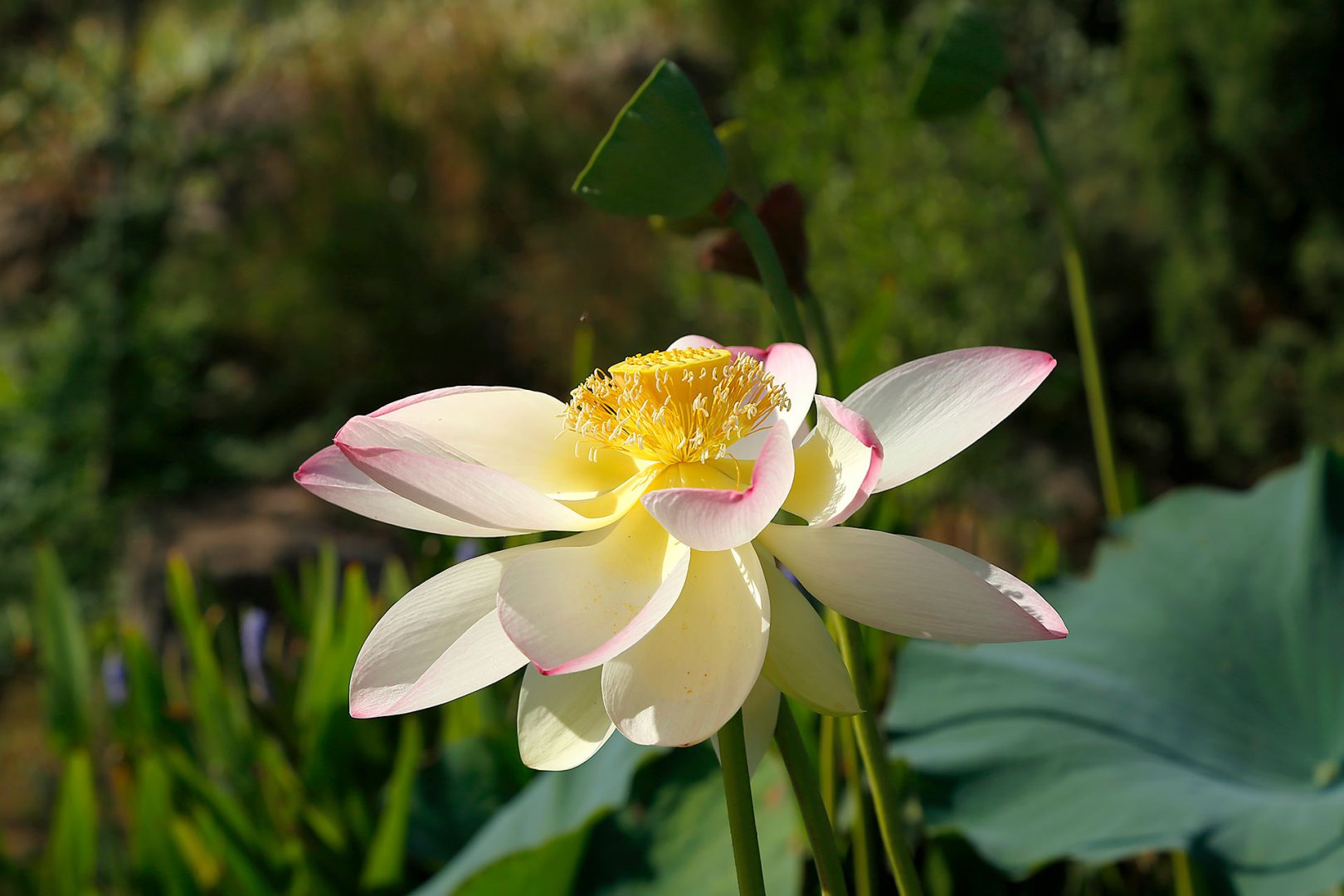
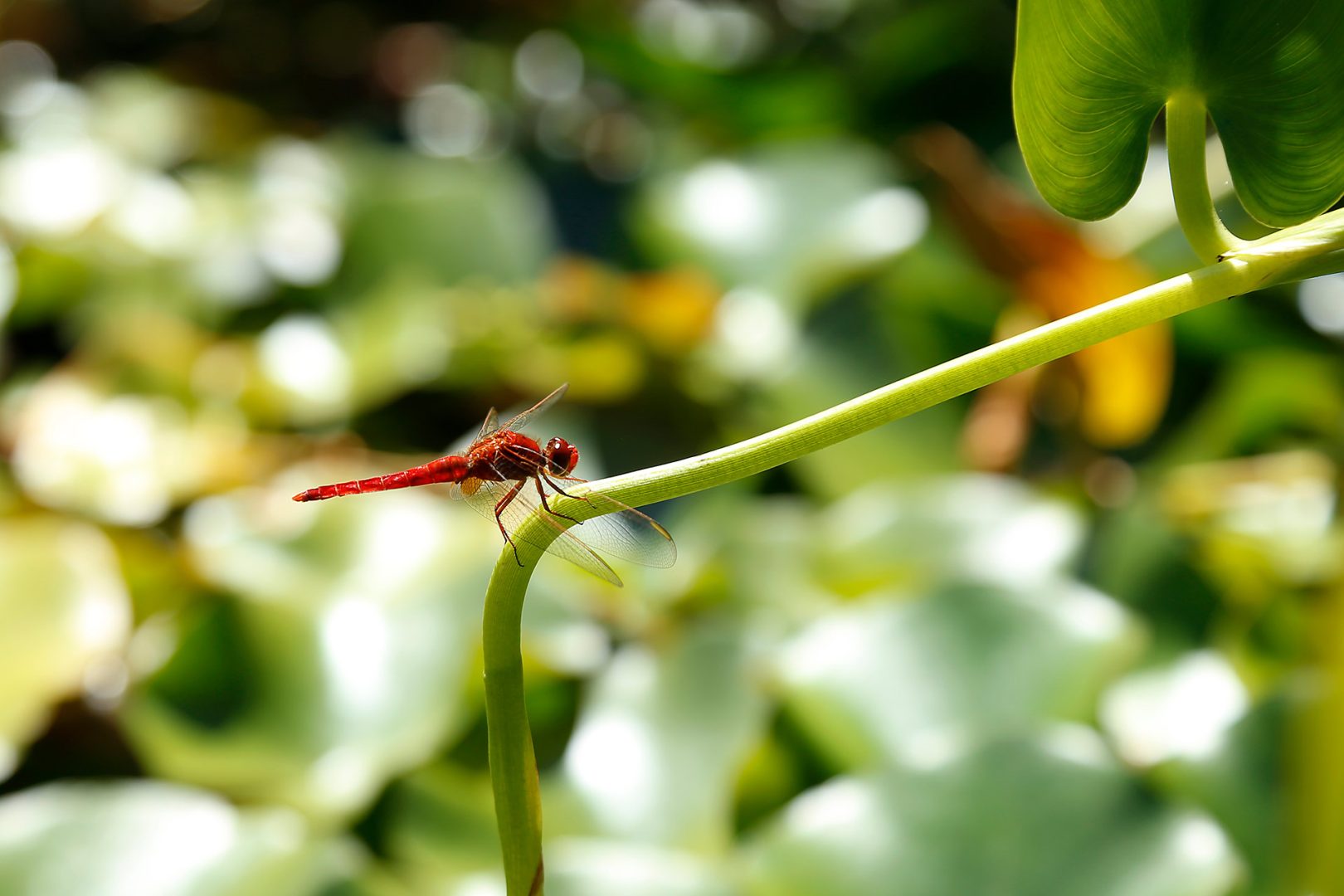
Transcript
Water Lilies
by Marta Orriols
Water lilies
The association is easy amidst the water lily ponds: surround yourself with beauty to cover everything that is not right. Expose an immediate experience of nature when the truth takes on the trembling texture of a convulsion. Perhaps it is me, I tell myself. Perhaps it is these dog days and the common threat from multiple fronts that I normalise, perhaps it is in this corner of the world and at this point in the day and the calendar, far from the narrowness of routine and the limitations of circumstances, that beauty bends under an excessive weight.
I think about it staring at the scandalous stamens of the white water lilies, inevitably recalling the series of water lilies painted by Monet beginning in 1914. While he planted his easel in front of a pond in the garden of his house and prepared to paint the exuberance of the water lilies, the First World War was breaking out around him. A world of peace in a world of war. The unyielding desire to want to be somewhere else when reality becomes frightening and exhausting and for that other place to be home.
On a personal note, I should say that it has always seemed to me that the beauty of the water lilies, those of Monet and the real ones, hides something cruel, that contains a kind of indifference towards all of us who do not achieve the absolute luminosity these floating nymphs radiate. Since childhood my eyes have interpreted them as a kind of synchronised choreography, as if they were aquatic ballerinas, drawing circles and figures while moving their legs and arms with stylised and confident movements. I envy the strength, endurance and flexibility of aquatic dancers and water lilies everywhere. I envy them that innate beauty. They seem to exist for perfection and to be admired, like love when it is still just desire. Love had to come out, of course. How do you avoid love? How can you flee from it? I often pride myself on thinking that my feelings are genuine, but all I have to do is descend the stairs, with the faint sound of running water in the background, to come face to face with the water lilies, and all of a sudden I become aware that what is happening to me is not real at all.
By now, I should have a clear account of my life, but I am still right there, at that crossroads. Nobody said it would be easy. And the fact is that in any edifying story we tell ourselves, even one with perspective, love plays an important role. I only know a few things about it; it, of me, even fewer. Taming desire with these minimal measures, with just the decorum that we both publicly display in this new way of relating, seems easy enough. For now we are two water lilies that rub up against the perfection floating in low water, boasting of the best version we can offer each other. The problem will come when, as time approaches us, time demands to know more about me, more about you; questions will be fired that will bring us both down into the depths, to where the roots, fragile and long, are entangled with the past of each of us. Down there we will have to battle with colonies of amphibians that have always been there, wise creatures that know how to camouflage themselves and jump far when they want to be alone.
I try to shrug it off and tell myself that, after all, love isn’t everything in someone’s life, but a voice rushes to remind me that maybe it is everything in someone else’s life. Do you see? You start out looking at sweetened water lilies of such beauty and end up losing control of your destiny.
And here ends the first part of the route! If you would like more, you can enjoy the second part on another day. But if you want to keep walking, let’s head towards the Joan Brossa Gardens, where we will talk about sounds, volumes, textures, etc. If you decide to continue to the next section of the route, listen to the orientation audio.
4th Section: Sounds, volumes and textures over time. The Joan Brossa Gardens
The Joan Brossa Gardens
Transcript
The Joan Brossa Gardens
We are in the Joan Brossa Gardens, named in honour of another poet. In this case, it is a multifaceted creator enamoured of word games and a reference figure of the Catalan artistic avant-garde.
Today it is a quiet place surrounded by nature and ideal for rest and recreation. The native Mediterranean vegetation gives it a wild air that can really make you feel as if you are in a forest, far from the traffic of the city. But in the past, this side of the mountain was full of music, lights, shows, rides and laughter. It was the site of Montjuïc’s fairground. Opened in 1966, it was not the first amusement park on Montjuïc; in fact, it was the third! In the 1930s, Maricel Park was built in this same place, and during the 1929 exhibition a temporary fairground was built on the old Foixarda quarry. The inauguration of the amusement park revolutionised the leisure of the city. It had thrilling rides, a flamenco show, restaurants in the shape of a whale… It even had a discotheque, the Lord Black. In the 1970s it witnessed the emergence of psychedelia and pop and was cutting edge thanks to its revolutionary innovative facilities with coloured lights that synchronised with the sounds. The music became a driving force for fun in an age of repression and containment. Musicians such as Joan Manuel Serrat, Lola Flores, Peret and Los Tarantos, and comedians, including Gila and Eugenio, performed in the park. The fair was a benchmark for fun until it closed in 1998. However, throughout the area we can still find remains of the fair that made Barcelona dream. And if we stop and listen, perhaps we can still hear the echoes of those sounds that marked so many generations in so many ways that overlap in time.
– Look: We suggest you lose yourself among the paths and seek out the sculptures that used to decorate the park. Keep your eyes wide open and pay close attention. You may find some more surprises on the way, like an insect hotel or musical pillows! If you come across the pillows, jump on them and listen to the sounds they make! You may also find some letters hidden in the garden. They are a visual poem by Joan Brossa, the wizard of words. - Listen: On this part of the mountain you can find many birds that fill the park with their song. Can you hear any of them? Or perhaps you can hear the gentle rustle of the wind in the trees.
If you click on the “More Content” icon, you will find the link to the Joan Brossa Foundation. You can also take part in the health and photography activities by listening to the audios of this section. Before leaving the park, find a quiet spot to listen to Marta Orriols’ text dedicated to this garden: Joan Brossa Gardens There are feelings that are not written anywhere. While they are formed they create an illusion similar to that of throwing fictions into the air. It doesn’t always happen, it doesn’t happen everywhere. But it happens here and now. It happens in the midst of silence and restful distance. Perhaps it is only an illusion generated by the views of the big city in the background. It becomes a hum that contains the nerve of rush hour or the gathering up before the dark night, but in any case the views seem to belong to another reality and not to this ephemeral moment of intimacy. In The Lonely City: Olivia Laing writes, “I began to realize that solitude was a very populated territory: a city in its own right.” I walk among sculptures that are the memory of what this place used to be, a place of leisure that still breathes with little splashes of families here and there. I’ve become used to going around the world alone. I like it, or perhaps it’s something I need to affirm to myself. Believe me, too: one can feel lonely anywhere, but high on this mountain, halfway between a forest park and a city garden, where some corners are a true forest, the isolation drives you to avoid gloomy thoughts. Perhaps it is the contrast of the distant rush and the present silence that accompanies and instigates a loneliness shared with others, even with others who are no longer there. In fact, it was you who explained to me that trees have memory and that they can even store information for decades. The explanation had the charm of a fairy tale and the aftertaste of a youthful conquest, and yet it was convincing enough to make me smile and capture my attention. Basically, at that time, few words could define us better than this: young people. I didn’t like the way it sounded then, and I still don’t like the way it sounds now. It happens to me often with words that lump too many people under one category. But there were a lot of us, young people, when we were young. You took a more serious stance to make it clear to me that trees communicate through their roots, and that they do so differently with trees that are in their own clan—with which they share information about the quality of the soil, the water and air— than with the rest of the vegetation, that they only warn of dangers. I remember being captivated by that. It is very powerful, the feeling of knowing that we are not the only ones with things to do and say on this planet, that trees are here, among other things, to illuminate our human condition.
I would not want to be a risk, so I enter a forest path surrounded by carpets of grass, cautiously, stealthily, far from representing any danger. I recognise the unmistakable trees. I am someone who spent the summers of her childhood surrounded by woods: pines, oaks, dwarf palms. I, who long for the sea and salt, although I have played with logs and earth, I have adorned my fingers with the domes of acorns, I have collected pine cones and river pebbles. I caress the scaly bark of an oak tree and wonder what she will retain from my gesture, from me. I wonder how she will keep me in her memory, which details, which impressions. Then, one of those feelings takes place that cannot be written anywhere, and it is good that it is so. To continue to the next section of the route, listen to the orientation audio clip.
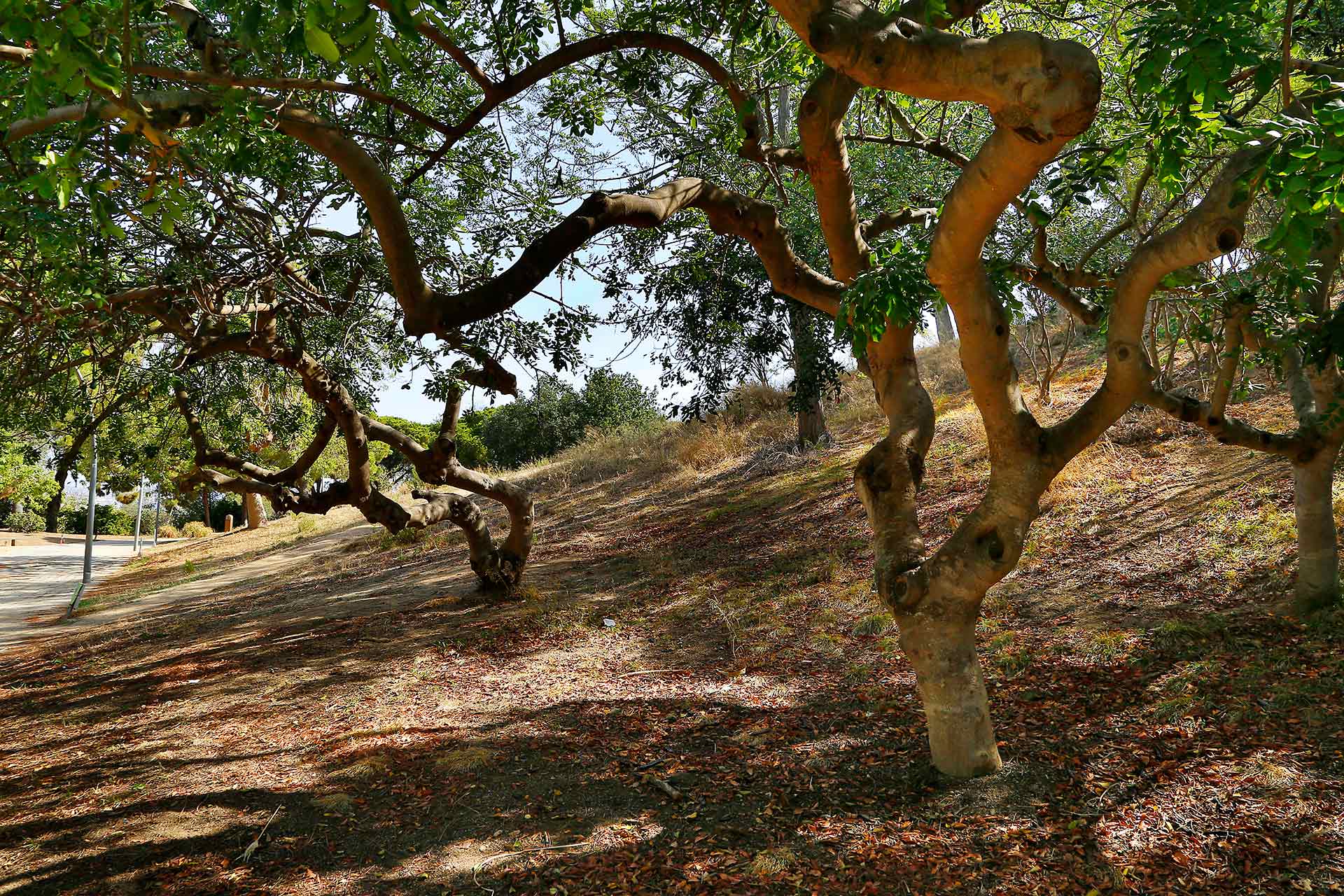
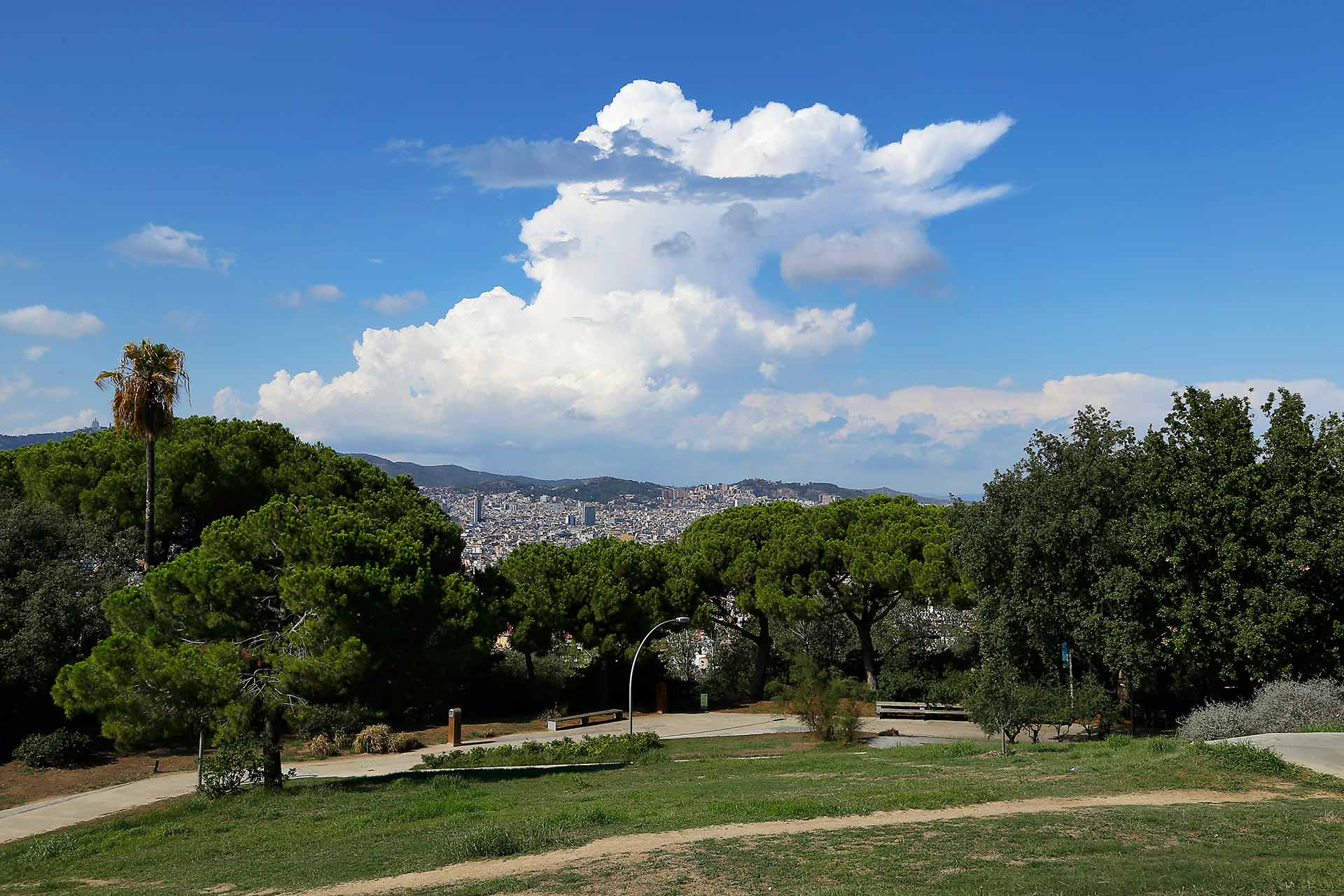
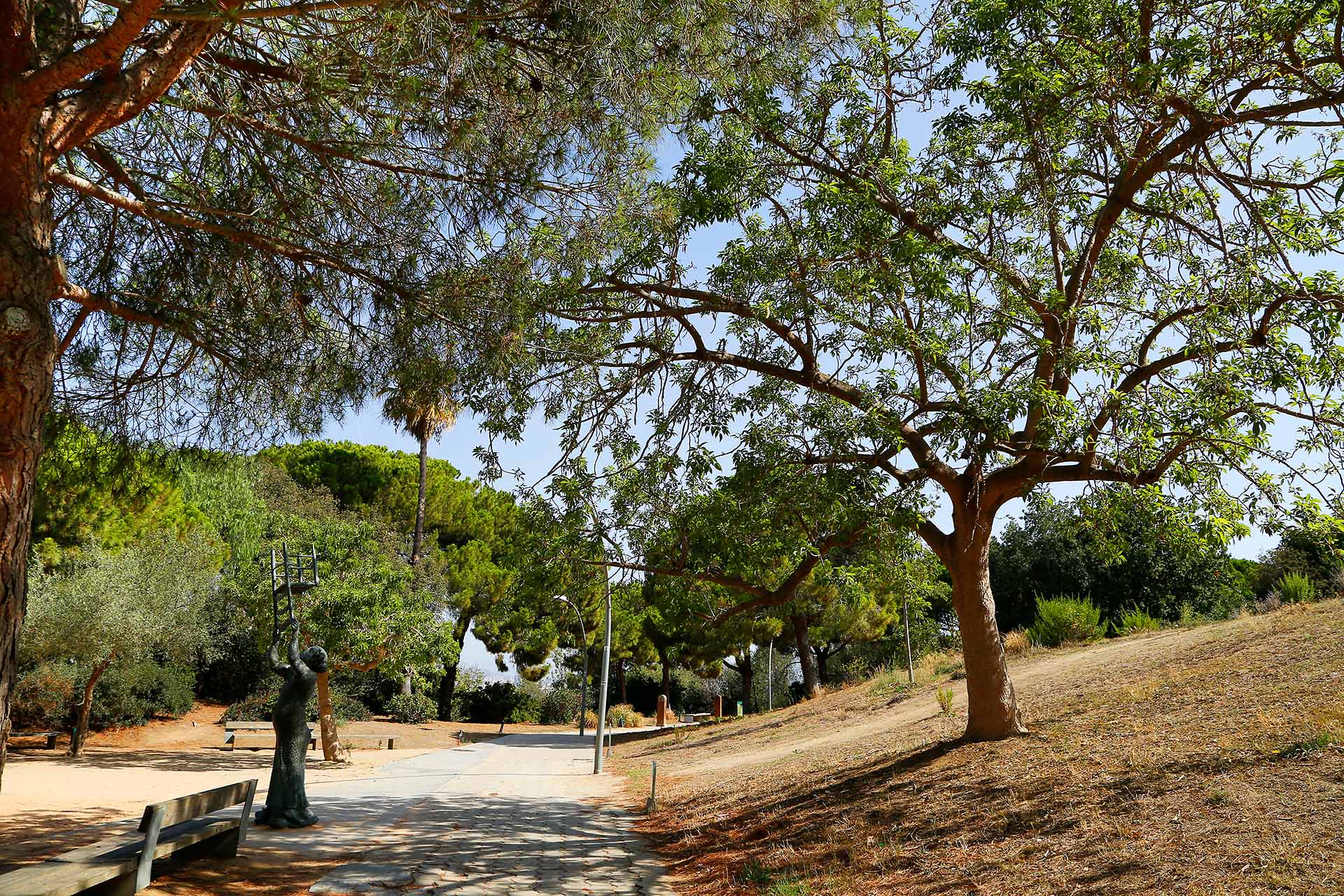

and well-being
suggestions
content
From the Joan Brossa Gardens to the Mirador de l’Alcalde
Transcript
From the Joan Brossa Gardens to the Mirador de l’Alcalde
To go to the next section of the route, the Mirador de l’Alcalde, leave the Joan Brossa Gardens through one of the upper exits and you’ll come out on the Montjuïc road. ` Once there, go up the road about 50 metres, cross over the pedestrian crossing, and you’ll be at the Mirador de l’Alcalde (lookout point).
Map
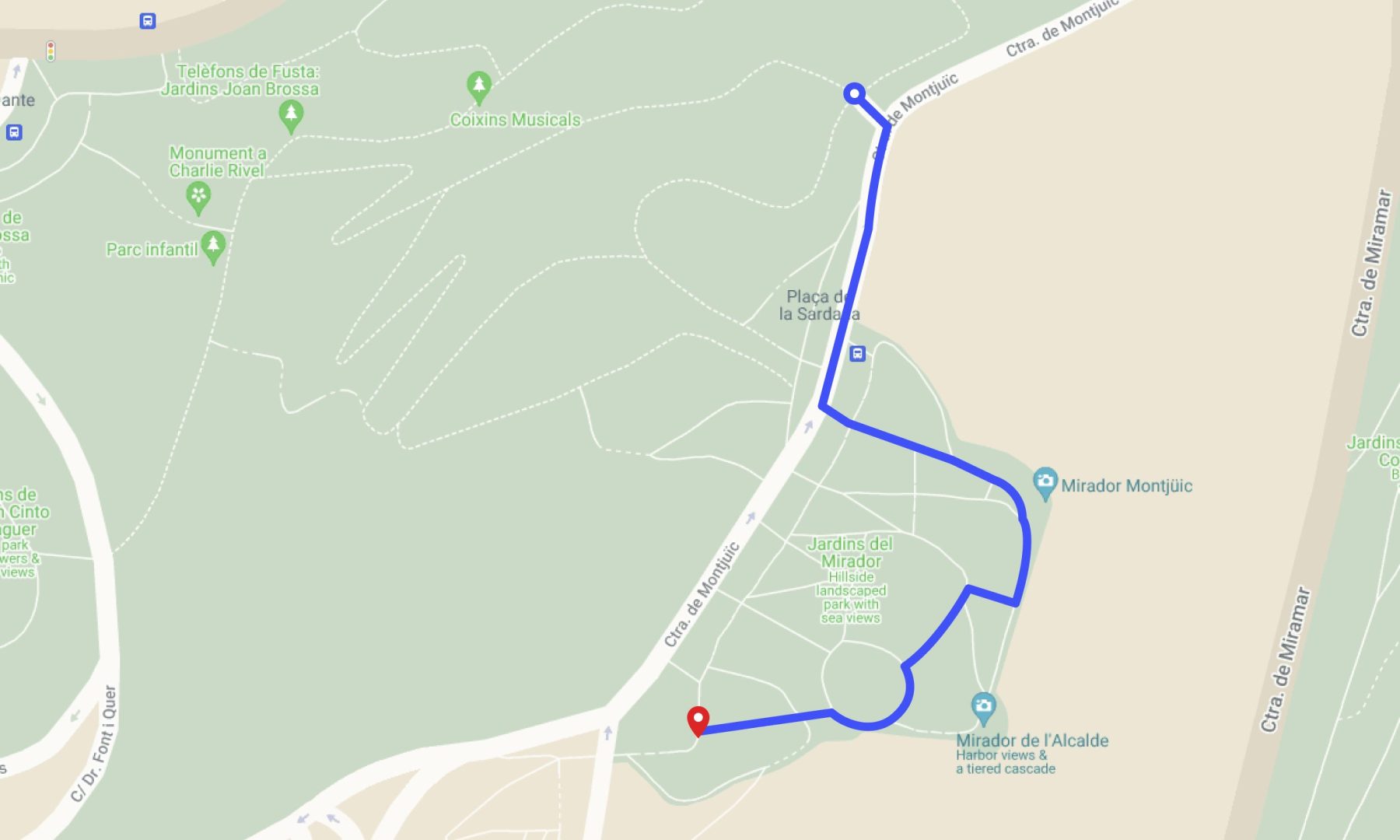
Full attention
Transcript
Full attention
If you would like to continue enjoying this moment, I invite you to bring your attention to your surroundings, to the here and now, to the present moment. Pay attention to the people around you, the surrounding nature, the clouds in the sky and how they are moving, observe your hands, your waist, your legs, your feet.
For a few moments connect to the present moment. Let your thoughts go, don’t be distracted by your mobile phone. Focus your attention on a specific point that catches your eye, its colour, shape, intensity, movement, etc. Everything is fine, no matter what has happened so far, no matter what will happen from now on. Focus on the moment you are living. Enjoy it, experience it; it’s unique, it won’t be repeated. Stay a while enjoying your moment.
The mountain landscapes
Transcript
The mountain landscapes
From close-ups and the beautiful flowers of the Joan Brossa Gardens we come to the grand panoramas. Walking along the paths of Montjuïc you will have noticed the marvellous landscapes they have to offer. To capture them, follow these recommendations:
– Landscape photographs are usually taken with the camera horizontally to be able to capture a wider angle, especially if you have a horizon line. You can also take the photograph vertically if the features that appear have vertical lines, for example trees, or diagonal lines that help give dynamism to the image.
– The lens used to capture a large landscape is a normal or wide angle aperture. But be careful if you use a wide angle, because if it’s wide open it distorts the sides of the image.
– Almost all mobile phones have a very limited optical zoom and use digital zoom. Never use it, it will reduce the quality of the image.
– Our eyes are able to perceive details and balance light contrasts that your camera cannot perceive. In this case, you can activate the HDR option in the menu, which will help photos with a high contrast to be more balanced and not show very dark or “burnt” areas with too much light.
– Sometimes you don’t need to include many elements in the picture. Less is often more.
– Even if it’s landscape photography, have in mind what you want to convey, what feeling or idea you wish to capture in your photograph. This will help you decide what the image will look like and what elements will appear in it.
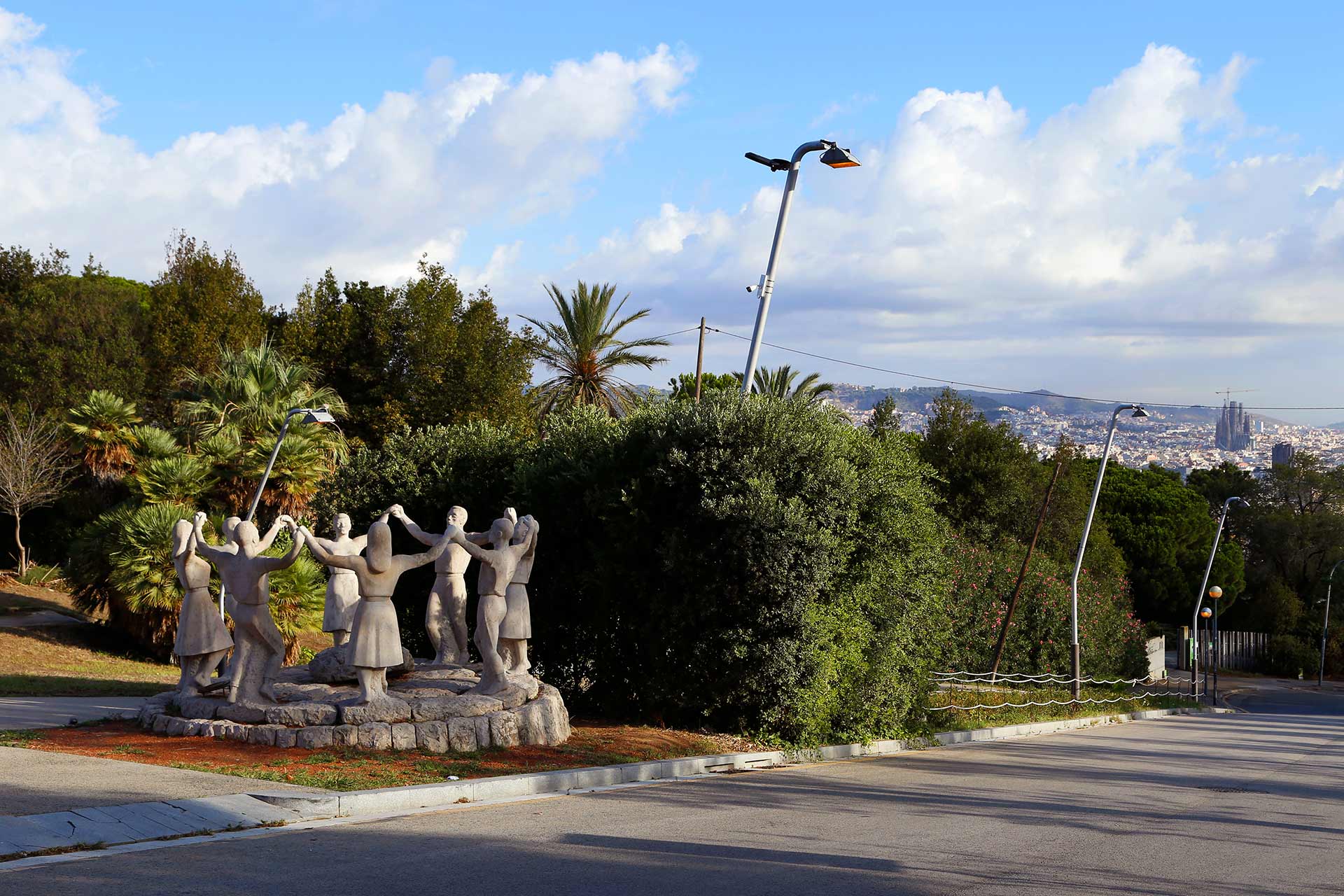
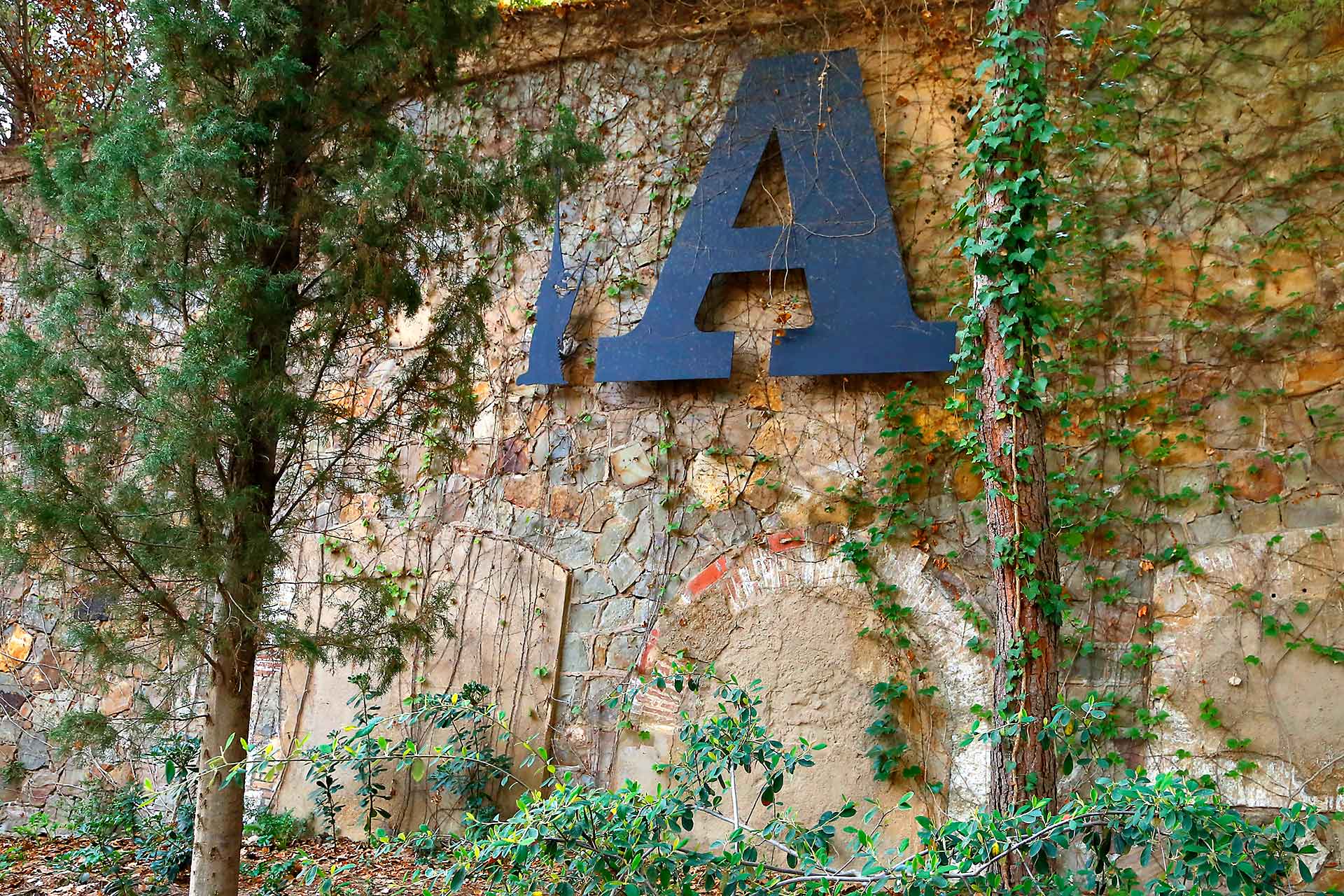
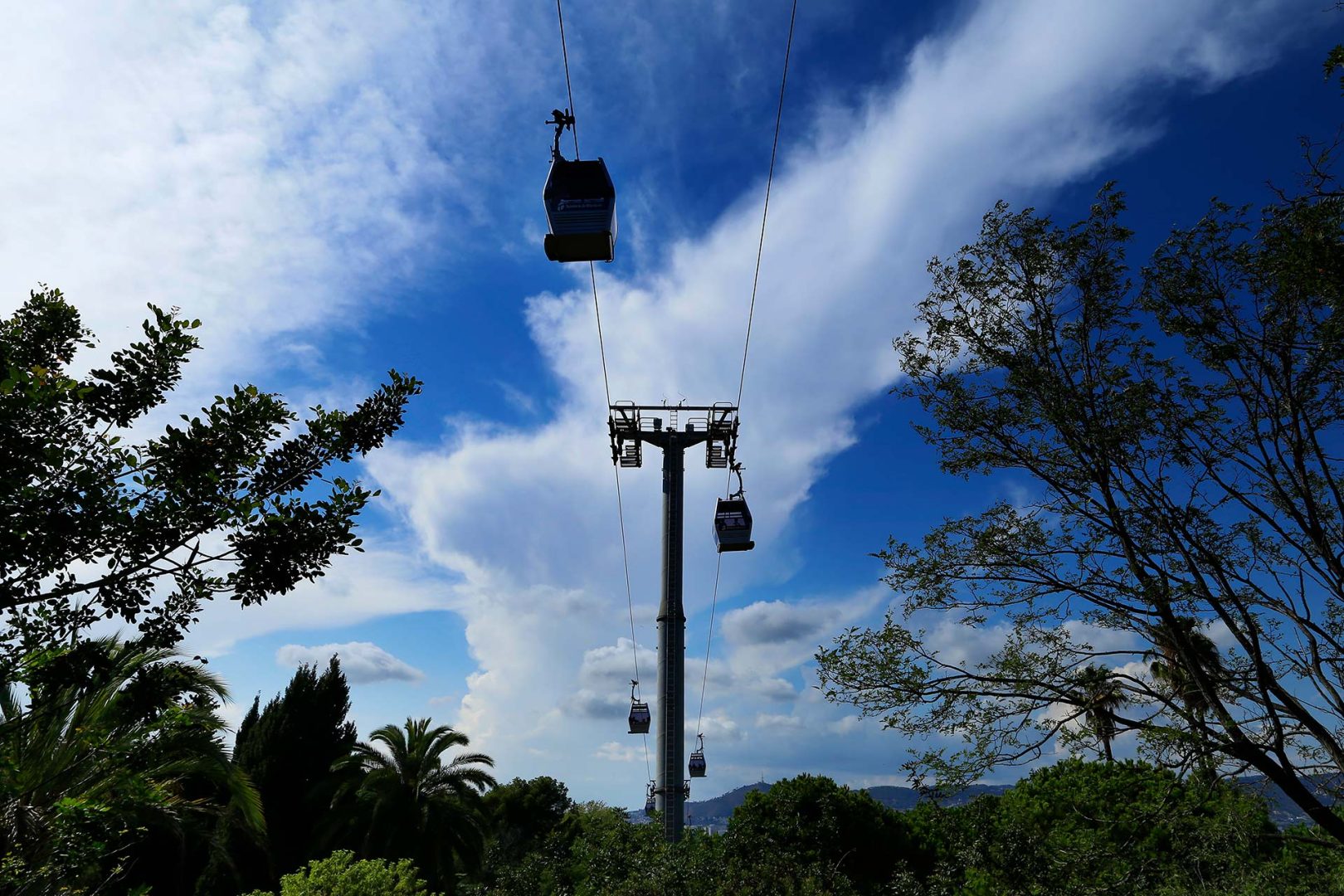
Imatges antigues Parc d’atraccions (Filmoteca)
Transcript
Joan Brossa Gardens
by Marta Orriols
There are feelings that are not written anywhere. While they are formed they create an illusion similar to that of throwing fictions into the air. It doesn’t always happen, it doesn’t happen everywhere. But it happens here and now. It happens in the midst of silence and restful distance. Perhaps it is only an illusion generated by the views of the big city in the background. It becomes a hum that contains the nerve of rush hour or the gathering up before the dark night, but in any case the views seem to belong to another reality and not to this ephemeral moment of intimacy. In The Lonely City: Olivia Laing writes, “I began to realize that solitude was a very populated territory: a city in its own right.” I walk among sculptures that are the memory of what this place used to be, a place of leisure that still breathes with little splashes of families here and there. I’ve become used to going around the world alone. I like it, or perhaps it’s something I need to affirm to myself. Believe me, too: one can feel lonely anywhere, but high on this mountain, halfway between a forest park and a city garden, where some corners are a true forest, the isolation drives you to avoid gloomy thoughts. Perhaps it is the contrast of the distant rush and the present silence that accompanies and instigates a loneliness shared with others, even with others who are no longer there. In fact, it was you who explained to me that trees have memory and that they can even store information for decades. The explanation had the charm of a fairy tale and the aftertaste of a youthful conquest, and yet it was convincing enough to make me smile and capture my attention. Basically, at that time, few words could define us better than this: young people. I didn’t like the way it sounded then, and I still don’t like the way it sounds now. It happens to me often with words that lump too many people under one category.
5th Section: Brushstrokes on land and sea. Mirador de l’alcalde (viewpoint)
Mirador de l’alcalde (viewpoint)
Transcript
Mirador de l’alcalde (viewpoint)
We are coming closer to the top of Montjuïc. A mountain that has seen the birth and, thanks to its quarries, has literally built the city of Barcelona.
We are at the viewpoint known as the Mirador de l’Alcalde, a spot that was built in the 1960s as part of the redevelopment plan for the mountain, which included Montjuïc Castle, the Military Museum and the fairground.
Once you have entered the lookout area, stop and look at the ground. What you see is a fantastic pavement created by the artist Joan-Josep Tharrats that covers the entire area of the viewpoint. If you look closely it is a work with thousands of details. Tharrats used all kinds of materials, including pebbles, stones, machinery metal filaments, screws, cobblestones, bottle tops and bricks. Like brushstrokes, they draw together various patterns of warm colours to create a collage similar to an impressionist painting. It is like walking on a painting.
Now, slowly look up and marvel at the spectacle of nature. Every step you take brings you closer to our sea, the Mediterranean, where all the blues of the sky and the sea shine to fill your eyes with light. And the horizon appears as a fine delicate stroke; a clear, infinite line.
The sea has always been a source of inspiration for envisioning stories, legends and myths. Like the love story of Madame Butterfly and the protagonist’s eternal wait, with her eyes fixed on the horizon, for someone who will never arrive. In this aria you are listening to, you can perceive the melancholy of hope that fades away over the years.
Or stories of eternal travellers like Ulysses, looking for his particular Ithaca, immortalised in Homer’s epic, Cavafy’s poem and the music of Lluís Llach:
”When you leave on the journey to Ithaca,
pray that the road is long,
full of adventures, full of knowledge.”
Every path, every route, is a journey. Whether by land, air or sea. It is an opportunity to discover new horizons and landscapes, real or imaginary. To understand that, in the end, every path, every journey, is a path towards oneself.
”Ithaca has given you the beautiful journey.
Without her you would never have set out on it.
There is nothing else she can give you.
And if you find her poor, it is not that Ithaca has deceived you.
Wise as you have become, with so much experience,
You will have been able to understand what the Ithacas want to say.”
We continue the walk towards the top of the viewpoint. This area is divided into several overlapping terraces connected by various paths, waterfalls and trees of tempting shapes. By the way, the central fountain was designed by Carles Buïgas, the creator of the Magic Fountain.
– Look: The grand panorama of the viewpoint is an incredible place to observe and feel the immensity of the sea.
– Listen: The din of the port of Barcelona reminds us that it is one of the busiest in the Mediterranean. It is time to walk around the viewpoint until you reach the top, where you will find a small square. Once there, listen to the health audio clip to end with fabulous views of the Mediterranean.
To continue to the last section of the route, listen to the audio guide.
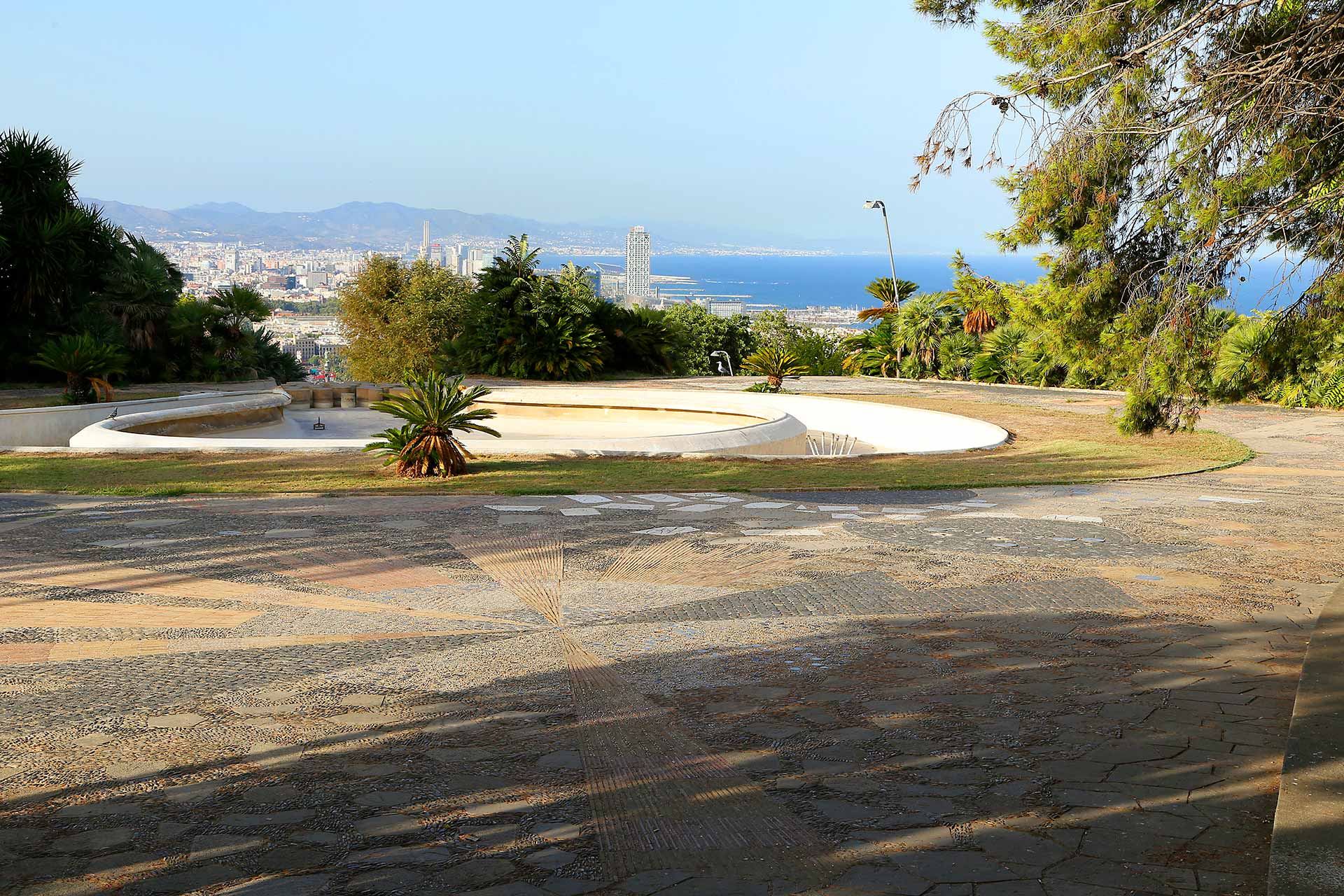

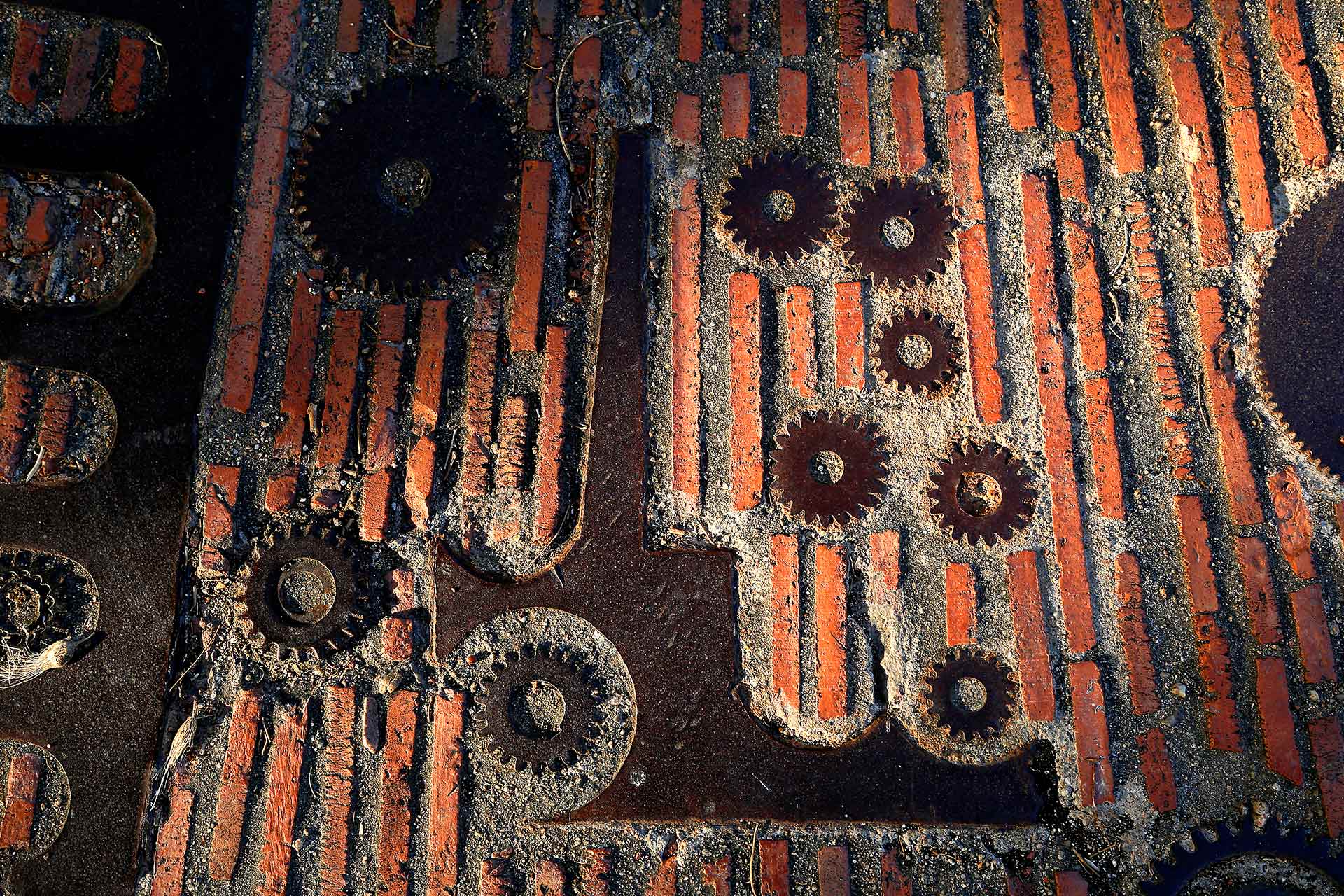
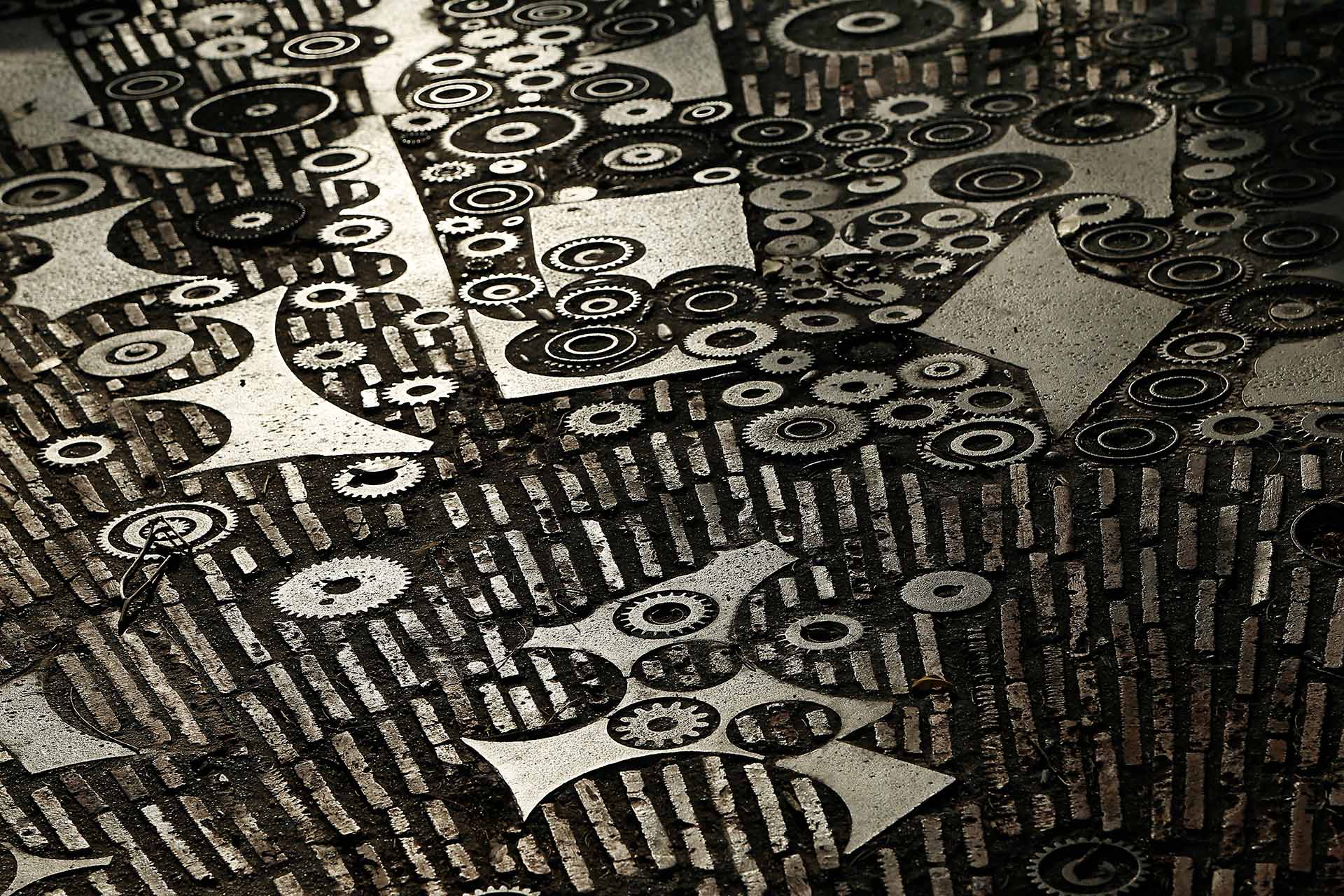
and well-being
suggestions
content
From the Mirador de l’Alcalde to the summit and castle of Montjuïc
Transcript
From the Mirador de l’Alcalde to the summit and castle of Montjuïc
To reach the top of the mountain and the castle, head to the highest part of the lookout, where there is a path lined by pine trees. A few metres further on you’ll see some steps on the right. Take them to reach the top of the mountain and finish the itinerary at Montjuïc Castle.
Map
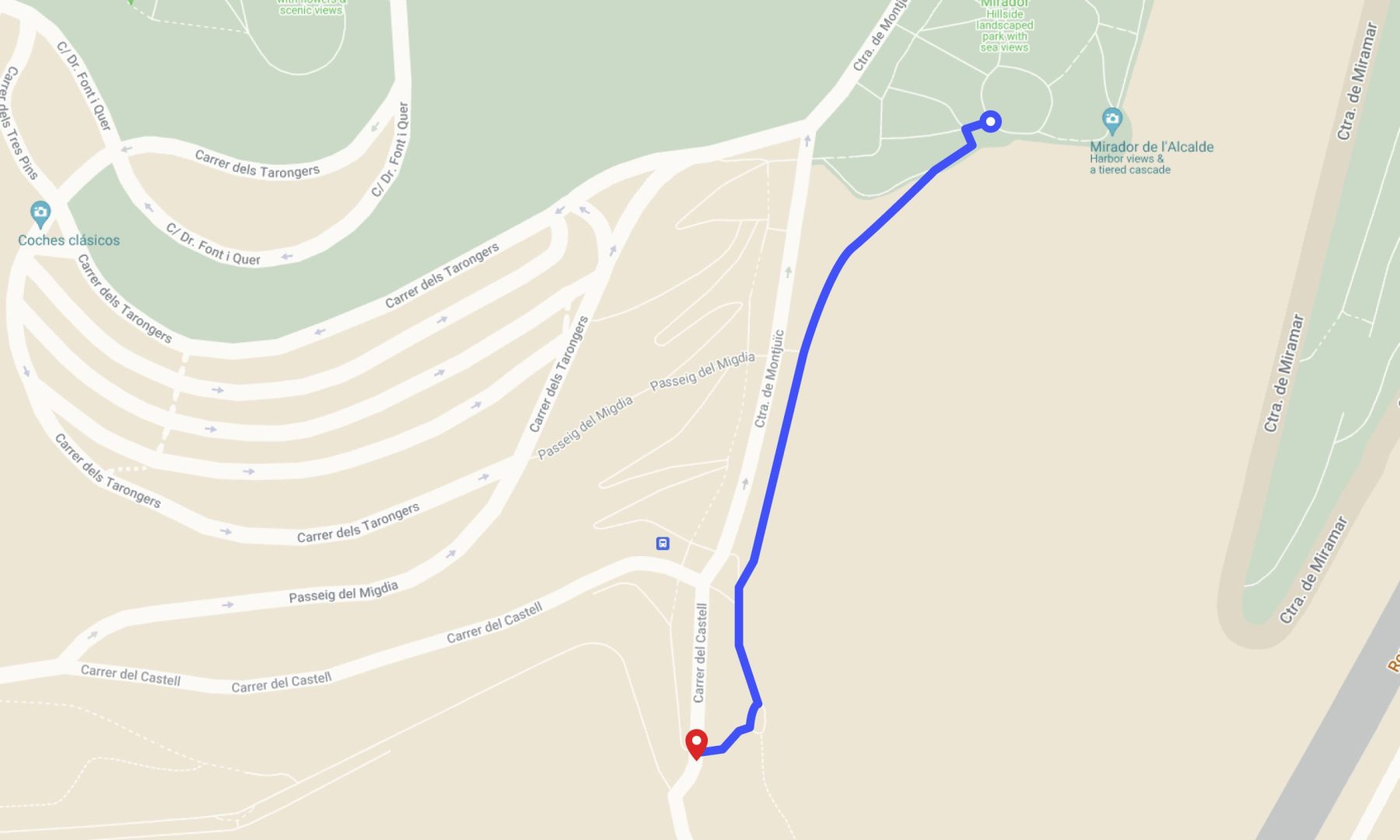
Exercises to release tension
Transcript
Exercises to release tension
After strolling through the Joan Brossa Gardens and maybe playing with the musical pillows, you begin to feel a little tired. That’s normal. I propose some simple exercises to restore your energy and, at the same time, release tension. Remember, don’t make any movement that hurts or causes physical discomfort.
When you inhale, raise your arms above your head and, as you exhale, drop your arms to the sides of your body, release them and let yourself droop as if you were a rag doll. Repeat the exercise a few times.
With your arms relaxed at the side of your body, rotate your right shoulder to the right and the rear, turning your waist. You’ll notice how your left shoulder goes forward. At the same time, let your arms sway, again, like a rag doll. Remember that what we’re aiming to do is release tension. You’ve been carrying your rucksack for a while now and you might notice a little fatigue.
Jump up and down, lifting both feet off the ground at the same time. It doesn’t have to be very high, we just want your legs to relax a little and, at the same time, activate them.
Rest your weight on your left foot and shake your right leg. Then switch sides. Rest your weight on your right foot and shake your left leg. If you have poor circulation or varicose veins, this exercise will bring you considerable relief.
The horizon line
Transcript
The horizon line
The horizon is a recurring element In landscape photography, like a thin line when we look towards the sea or a steep line in the mountains. To be able to create images where this line has compositional force, it is advisable to follow the horizon rule.
When you’re framing the picture, whether it’s horizontal or vertical, imagine two parallel horizontal lines dividing it into three equal parts. Place the horizon line on one of these two lines depending on the element you want to highlight: the sky or the land, the sea or the mountains.
It is also important to keep the horizon line completely straight to take a good photograph. If it is slightly uneven, it can unbalance the image, although, in some cases, the unbalanced horizon effect can be purposely sought for a more creative image.
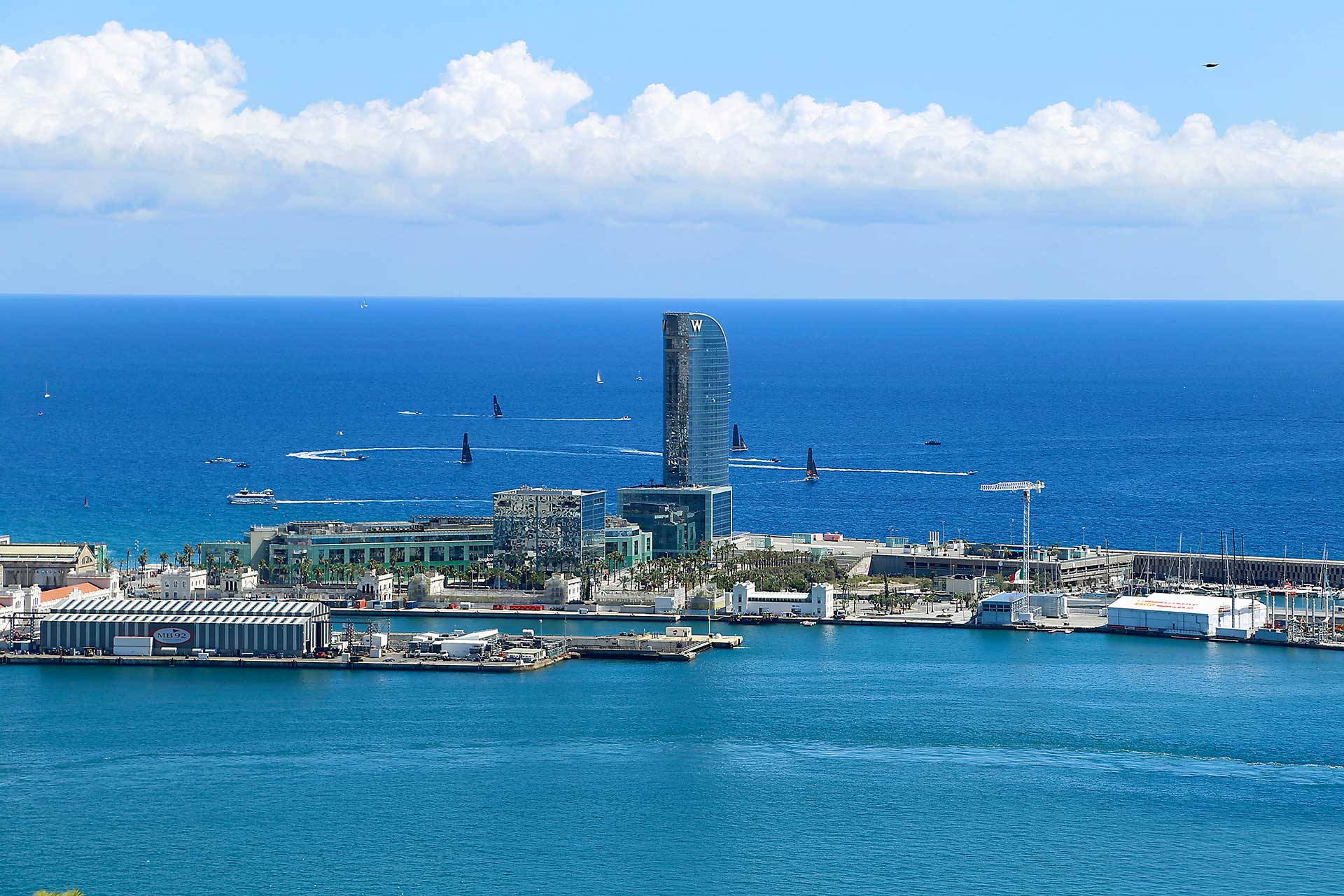
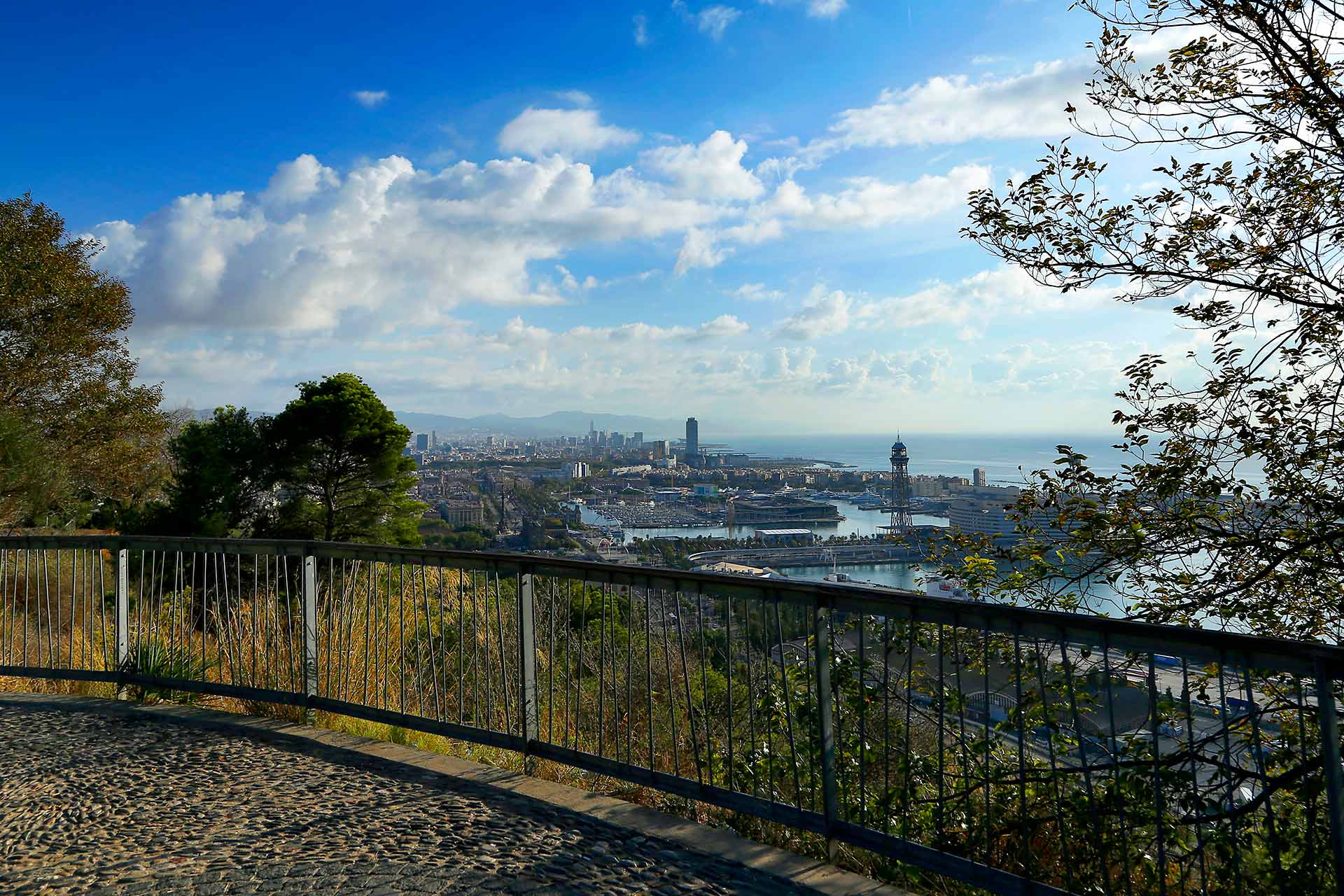
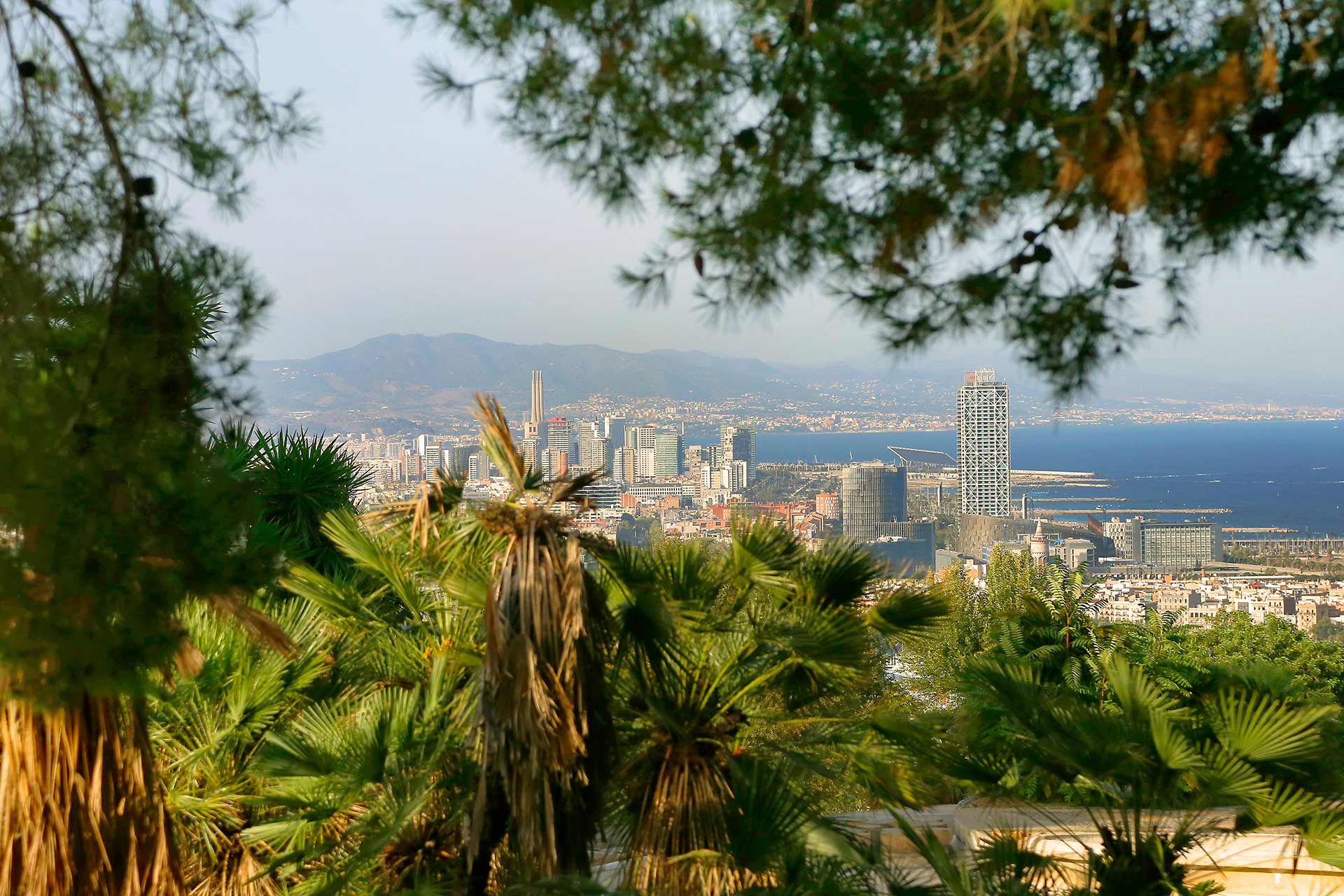
Un bel dì vedremo
6th Section: Line and point. Summit and Castle of Montjuïc
Montjuïc Castle
Transcript
Montjuïc Castle
We’re coming to the end and none other than the summit of Montjuïc Mountain and its castle. With more than 300 years of history, the fortress has been the protagonist of some of the most important, and also dark, episodes of the city.
Documented as far back as the 11th century, it was originally a beacon. It warned of the arrival of hostile vessels using a system of sails during the day and fires at night. Later, during the War of the Reapers in the 17th century, a small fort was built to defend Barcelona.
However, the great expansion, which transformed the castle into what we know today, was the reform undertaken by the military engineer Juan Martín Cermeño after the War of the Spanish Succession in the 18th century. This reform shaped the structure you see today with the various straight lines, bastions, moats and embrasures.
In the 19th century, the castle was used to bombard the city and became a place of repression of an incipient workers’ movement. At the end of that same century, it was the site of the Montjuïc military trial, which took place after the attack on the Corpus Christi procession on 7 June 1896. More than 400 people were tried and it stirred strong internal and international opposition due to the lack of legal guarantees.
In the early 20th century, this place continued to witness the social and political changes of the time. During the turbulent Tragic Week of 1909, the very important La Canadenca strike of 1919 and the Spanish Civil War, the dark legend continued to expand with penitentiary uses and executions, such as those of the pedagogue Francesc Ferrer i Guàrdia and the President of the Catalan Government, Lluís Companys. The castle was used as a prison during the Franco dictatorship until the 1960s.
In 1963, it was remodelled and opened as a military museum. In 2008 the building was returned to the city. From then on, it became a heritage and living memory space, looking to the future and hosting a diverse cultural programme at the service of all citizens.
- Look: The grandiose fortress born of the same Montjuïc stone, a heritage space full of memory.
– Listen: The steps that go around the summit of Montjuïc, yours or those of all those people who walk for sport and health or who enjoy the mountain and its magnificent natural and cultural heritage.
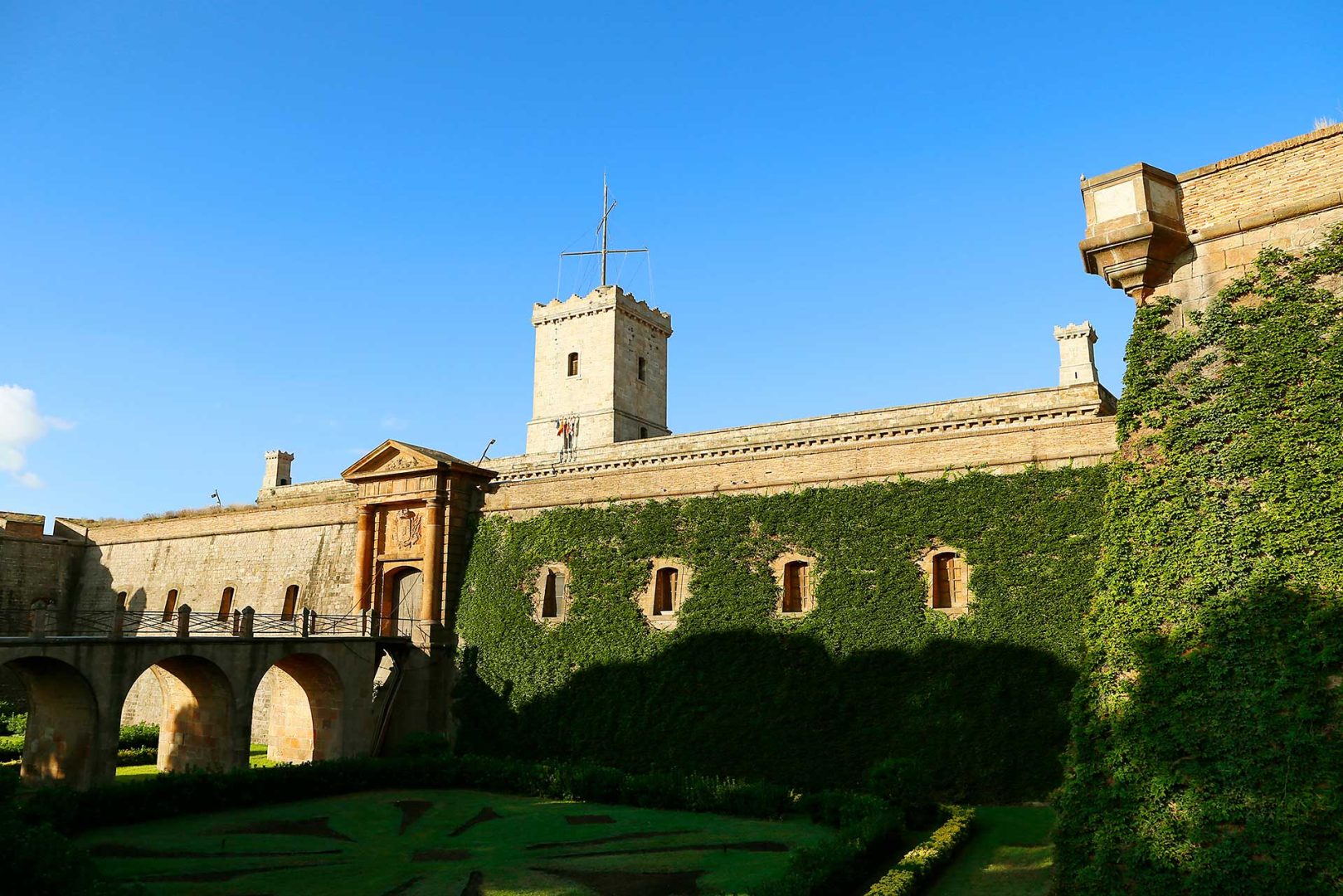
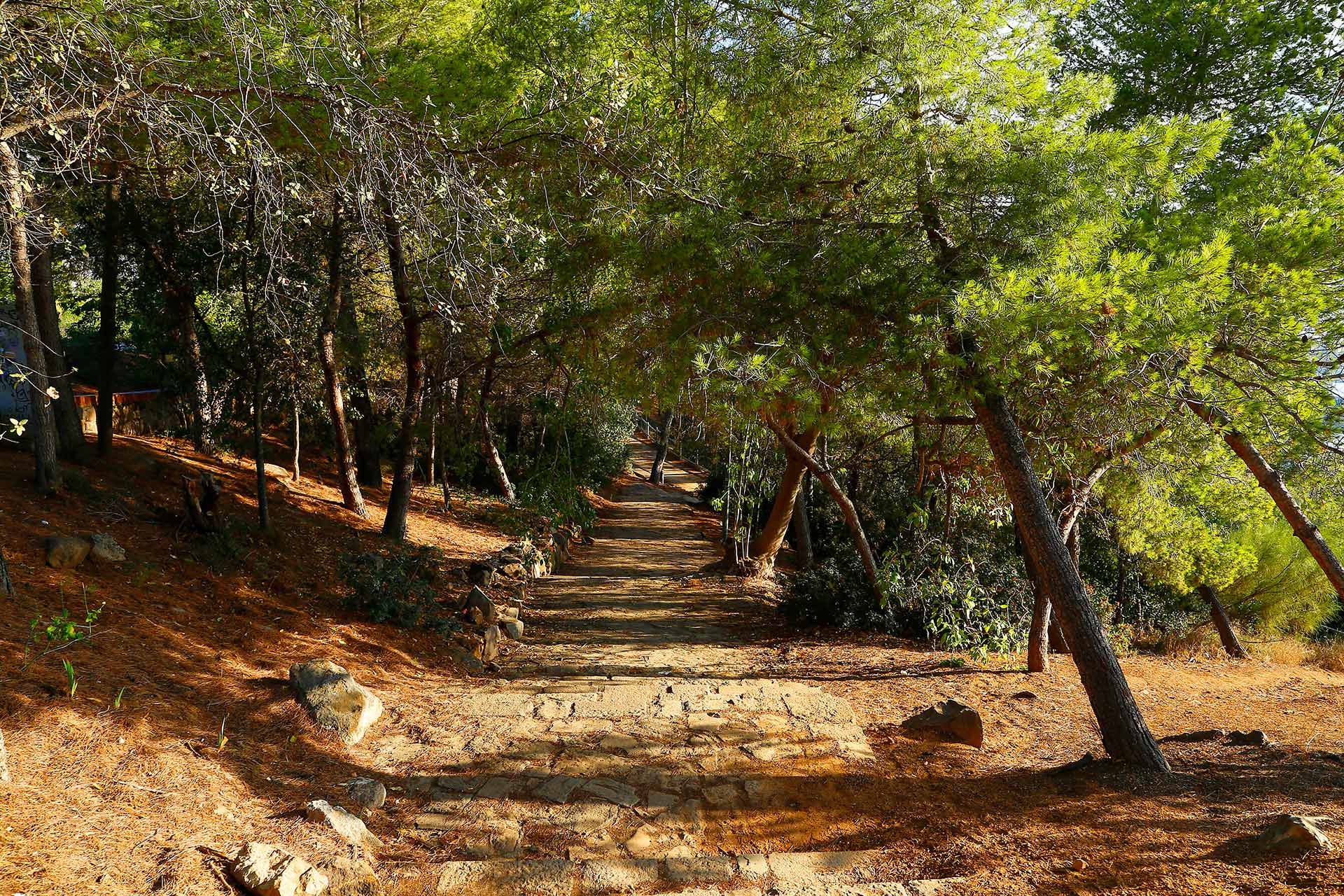
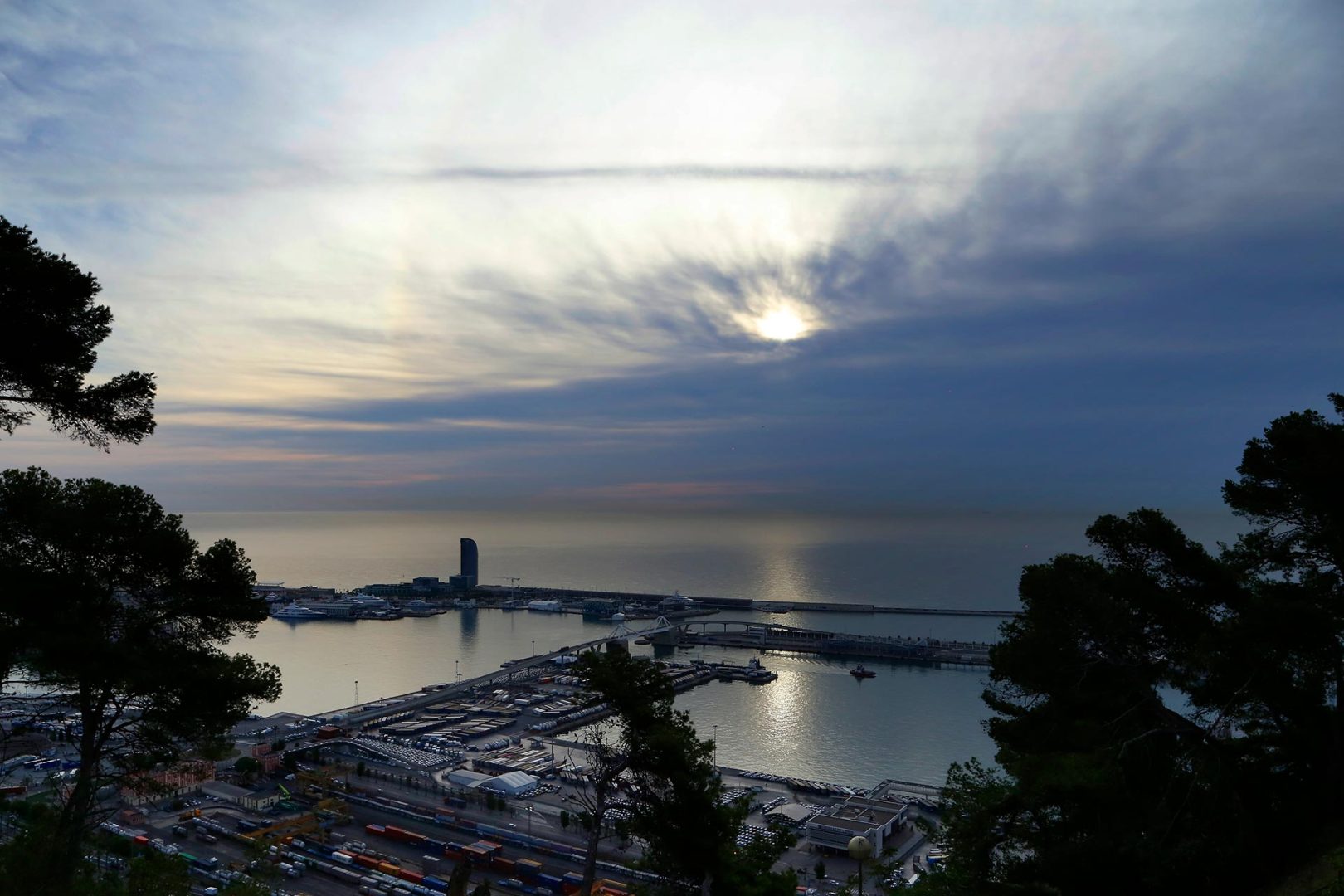
and well-being
suggestions
content
Camí cobert and descent of the mountain
Transcript
Camí cobert and descent of the mountain
You can finish the route by walking along the entire camí cobert (covered path) of the castle. Just follow the dirt path that runs around its entire perimeter. It is a circular route.
To get down from the mountain by public transport you can take bus 150. The bus stop is at the bottom of the stairs just before you reach the castle. You can also take the cable car and enjoy one of the best panoramic views from the sky over Barcelona.
Map
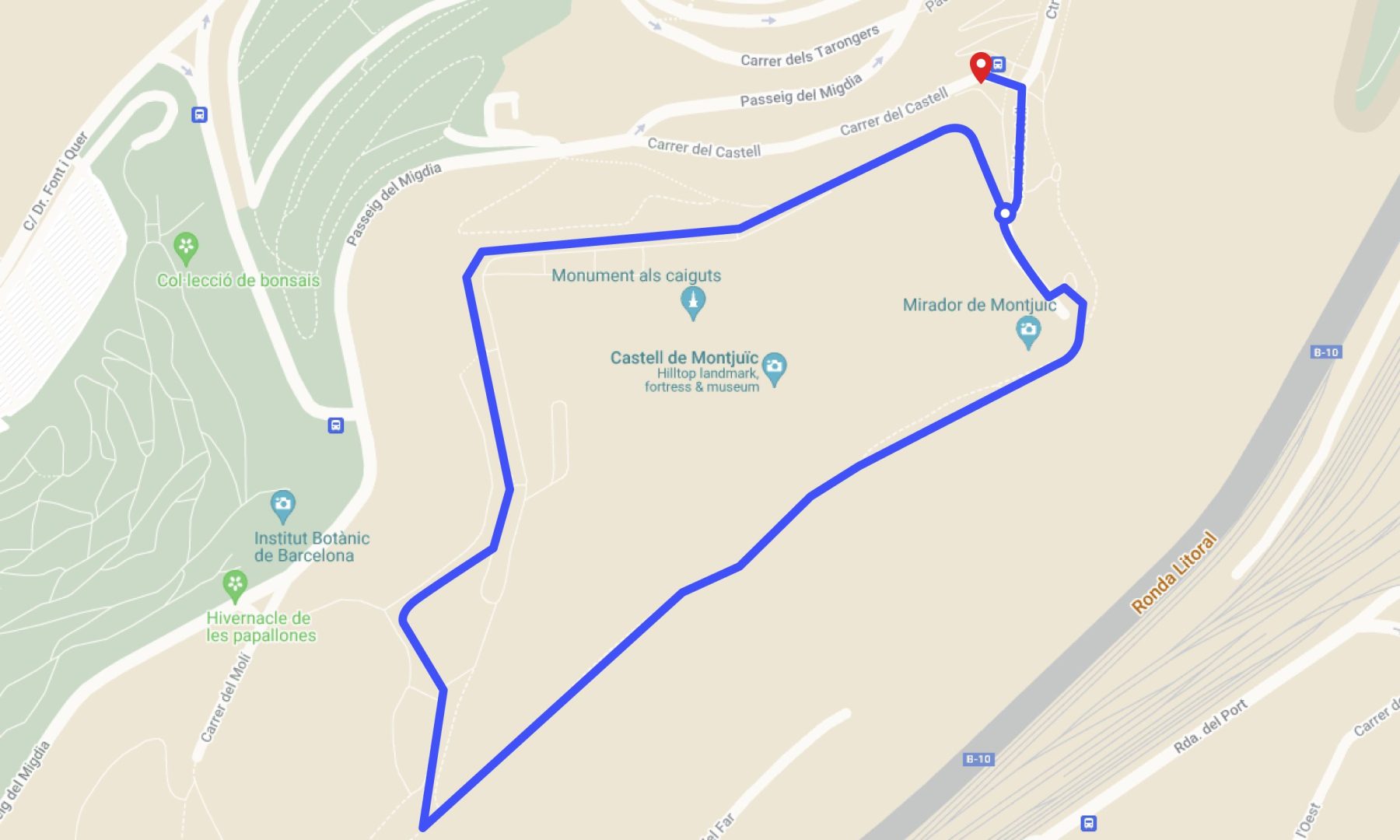
The end
Transcript
The end
When you finish the walk, I’d like you to find a place where you feel comfortable. It can be standing or sitting. When you’ve found it, close your eyes. Bring your attention back to your breathing and repeat the breath-counting exercise from before. Count “one” when you inhale, “two” when you exhale, “three” when you inhale, “four” when you exhale, and so on, until you reach the number ten. When you reach ten, start again at one and do another round.
When you’re done, bring your attention to the middle of your chest. Visualise a ball of golden light rising from the middle of your chest and slowly growing larger. The golden light covers your body and goes beyond it. It illuminates and envelops the people you are with, the space you are in –Montjuïc, Barcelona, Catalonia, Europe– until it illuminates the whole world. Notice how you are inside this light, it’s a magical light that dispels worries and gives you a feeling of peace. Little by little, it gets smaller and comes back towards you. It becomes a light in the middle of your chest that generates gratitude for all the experiences you’ve had today.
Give thanks for everything that has happened and also what hasn’t happened. Thank your body for bringing you this far and for allowing you to feel all the emotions of today, both positive and negative.
With a big smile, open your eyes and take this experience with you.
Create and share!
Transcript
Create and share!
Finally, our last photographic suggestion is to keep creating and sharing your pictures, because photography is also the art of telling stories!
We photograph the world to capture the beauty that surrounds us, to capture the moment, to recall experiences, to express emotions or to tell stories – and to share them.
You can create a narrative by combining several images and creating a whole story. The images speak for themselves and also converse with each other; and they take on greater meaning or transform it when grouped together. Experiment with combining them to create sets of images that go beyond a single photo!
On this itinerary you’ve found many special spots at which take great photos, but keep in mind that they can be taken anywhere! Photography is more about how you look at things than about the things you look at.
We hope you’ve enjoyed taking pictures along the route. If you like, you can share them on social media with the hashtag:
#ArtdeCaminar
#LartdeCaminar
#lartdecaminarMontjuïc
We encourage you to keep taking photos wherever you go, on any of the paths you travel, always with your eyes open and with an attentive look at every flower, landscape, gaze and gesture.
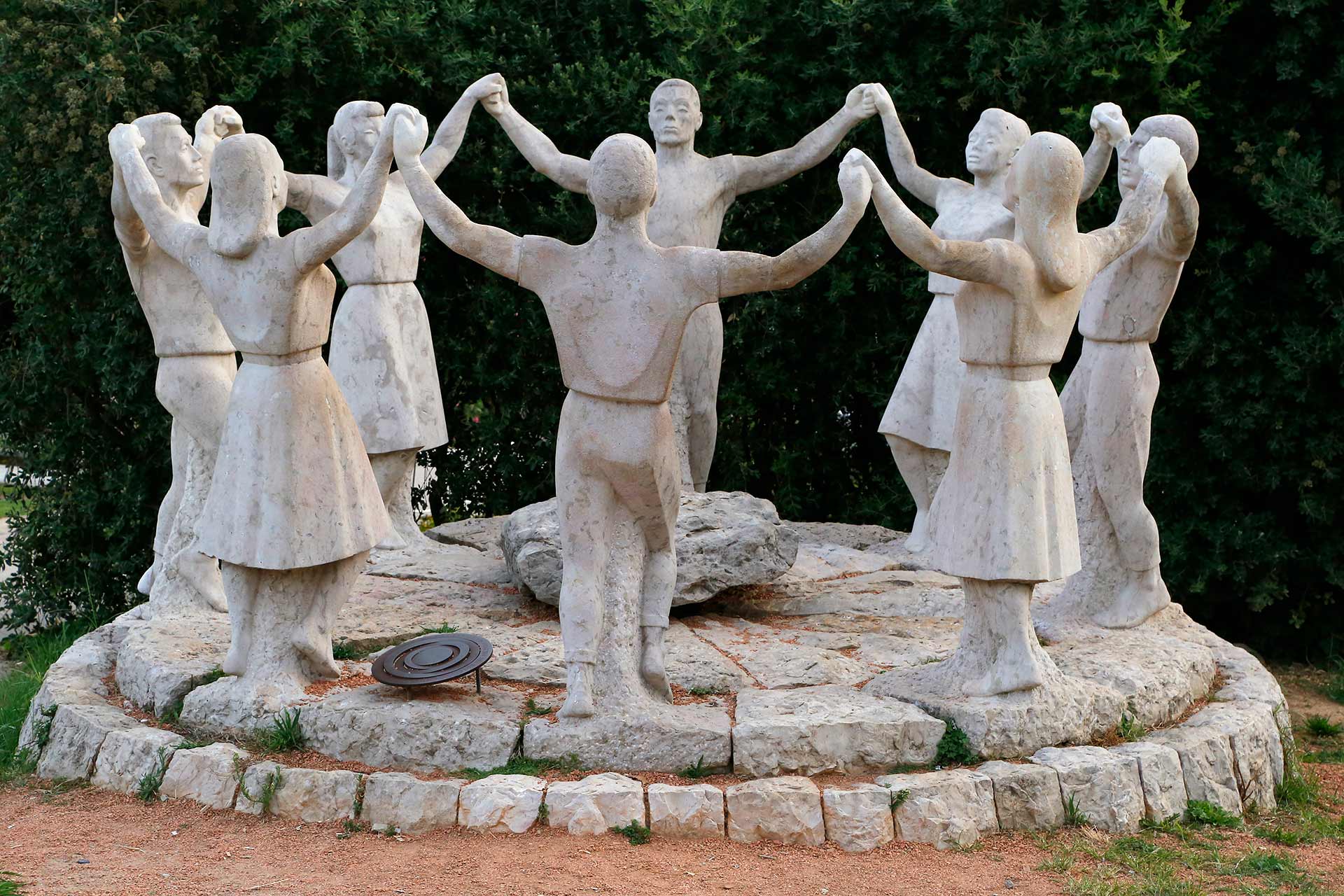
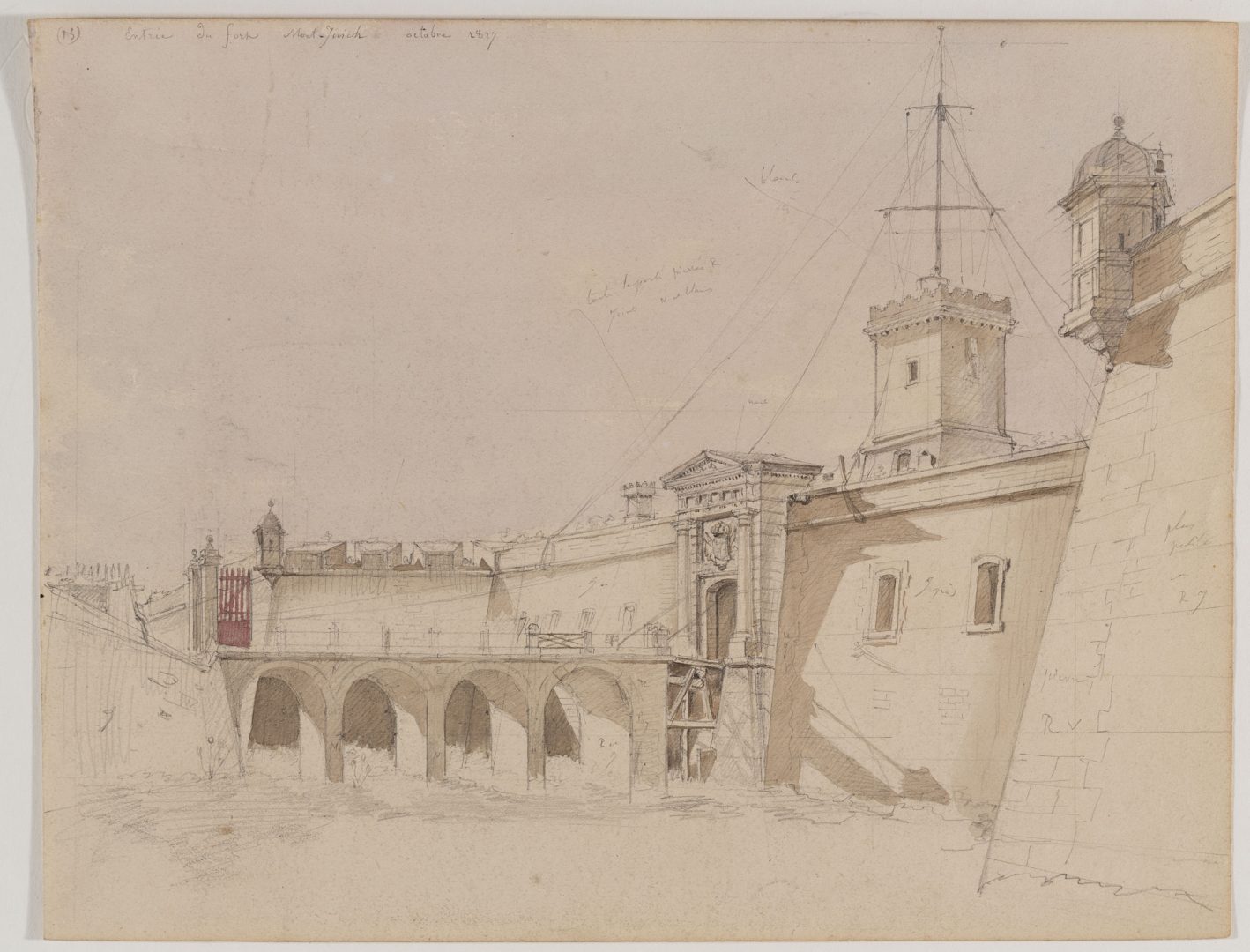
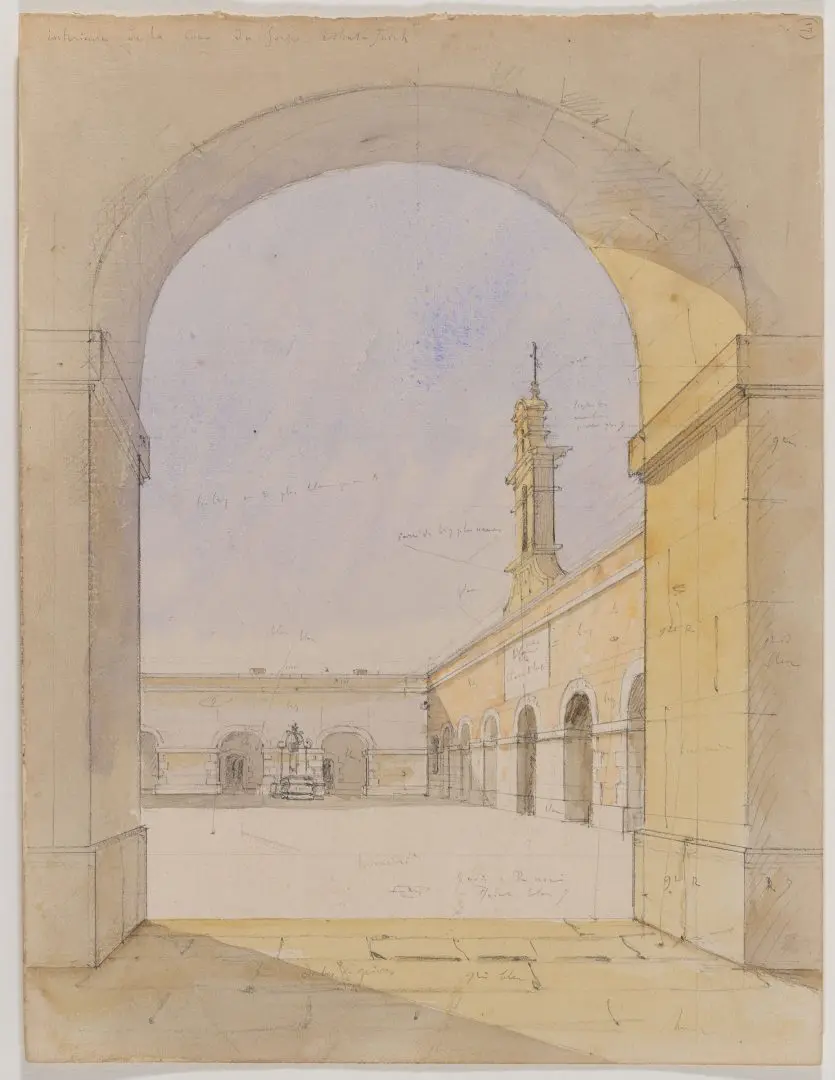
Share your view
Good bye
Transcript
Good bye
We hope you have enjoyed the itinerary and the time you have gifted yourself.
Come back whenever you like, whenever you need. Walking helps maintain a good state of health, and Montjuïc Park, a mountain full of gardens and art, is a fantastic place to walk. You can write a few words about your feelings today, draw a picture or frame some of the photographs you have taken. You can also share these with the community through social media under the hashtag #LArtdeCaminar. We are sure the itinerary has inspired you to create, think or imagine.
”The Art of Walking” is exactly that: knowing how to enjoy the present moment wherever your steps take you; observing with full attention the world around you and being part of it. And making art a wonderful travelling companion along the various paths of life.
And remember, recalling the words of the poet Antonio Machado: In reality there are no roads, you create your own path by walking.
Savouring the experience: after the route
About the MNAC
Transcript
About the MNAC
At the National Museum of Art of Catalonia you will find more than a thousand years of art, from the Romanesque period to the present day. You can see the best collection of Romanesque mural paintings in the world and the most representative artists of Catalan Modernism, such as Gaudí or Casas. Completing the collection of Gothic art are great European Renaissance and Baroque painters (such as Titian, Velázquez and Canaletto). There are spectacular galleries focusing on the Spanish Civil War, as well as an extensive photography collection.
The MNAC organises several first-class temporary exhibitions throughout the year, as well as a specific weekend activity programmes that we invite you to discover.
Credits
The Art of Walking is a project of the National Art Museum of Catalonia Arts+Health Hub-Lab in collaboration with Montjuïc Castle, the Catalan Health Institute and the Film Library of Catalonia.
Concept and design: Guillem d’Efak Fullana-Ferré, Norma Vélez, Marina Castillón Prat
Script: Marina Castillón Prat
Texts: Marina Castillón Prat, Guillem d’Efak Fullana-Ferré, Norma Vélez
Water Lilies and The Joan Brossa Gardens: Marta Orriols
Extract from Breviario del viejo corredor, Editorial Siruela, 2023: Lluís Alabern
Health advice:
CAP Numància (ICS – Catalan Health Institute):
Yolanda Herreros Herreros (Family Doctor, CAP Numància. ICS)
Sandra Martín Miralles (Family Doctor, CAP Numància. ICS)
Sandra Escobar Pina (TCAI, CAP Numància. ICS)
Marta Cardiel Gil (Family and Community Nurse, CAP Numància. ICS)
Lidia Chaguaceda Casado (Family and Community Nurse, CAP Numància. ICS)
Marta Dacosta Pova (Dietitian-Nutritionist, CAP Numància. ICS)
Mireia García Oliván (Emotional and Community Wellbeing Reference, CAP Numància. ICS)
Voiceovers: Daniela Monsó
Photographs: Marina Castillón Prat
Graphic design: Puig Ventura Àlvarez
Oval: Fito Conesa
* CAP = Primary Healthcare Centre, ICS = Catalan Health Institute, TCAI = Technician in Auxiliary Nursing Care
English translation: Paul Turner
